The blog describes a visit to Berlin and Dresden, Germany, exploring landmarks like the Brandenburg Gate, Deutsches Historisches Museum, Kaiser Wilhelm Memorial Church, and Checkpoint Charlie. The author also visited Dresden's Theaterplatz, featuring the Zwinger Palace, Semper Opera House, and Italian Dörfchen. Finally, they stopped by the Bastei rock formation near the Czech border, learning about its geological history.
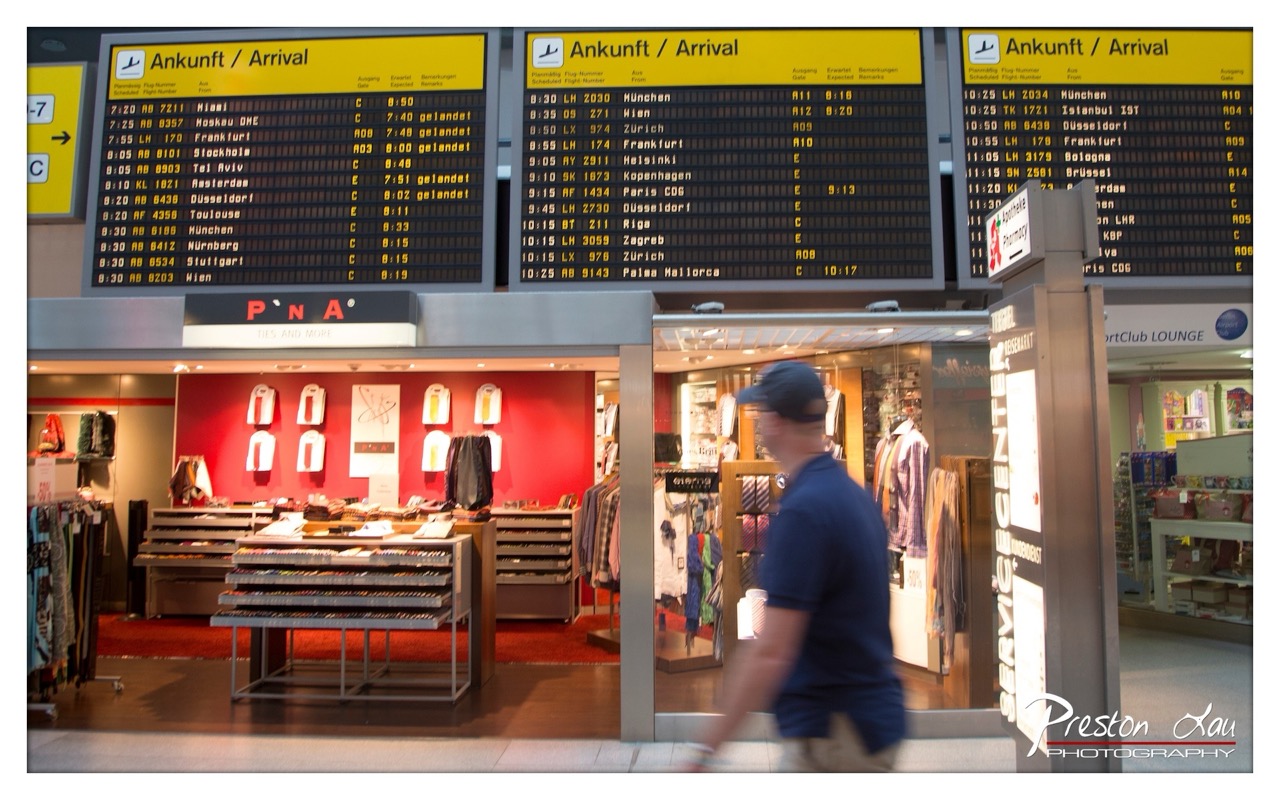

Airport Arrival Boards & Retail Therapy
Rating: 7/10
This image perfectly encapsulates the delightful chaos of an airport concourse, where the serious business of arriving flights collides head-on with the equally serious business of retail. At the top, the iconic yellow 'Ankunft / Arrival' boards proudly display a dizzying array of destinations – from Miami to Moscow, Zurich to Zagreb – promising escapes or signaling homecomings. Below, a vibrant scene unfolds with shops beckoning travelers; prominently featured is 'PNA Ties and More,' a haven for sartorial emergencies and last-minute gift grabs, bathed in a cheerful red glow. In the foreground, a traveler, perhaps overwhelmed by the choices (flights or neckwear?), rushes past in a blur of motion, a fleeting figure against the backdrop of static information and tempting displays. The mood is a blend of organized functionality and consumer temptation, typical of a bustling travel hub.
From a photography perspective, the composition cleverly stacks layers of information and activity, drawing the eye from the high-tech flight data down to the tangible goods on offer. The blur on the foreground subject, while potentially unintentional, effectively conveys the sense of movement inherent in airport life, contrasting with the static nature of the boards and shops. The lighting is standard airport fare – a mix of functional overhead lights and warmer shop illumination, creating some challenging hot spots and glare on the boards, a classic scenario for travel photographers. The color palette is dominated by the striking yellow of the screens and the bold red of the PNA shop wall, adding visual interest to an otherwise neutral architectural space. It's a candid, observational shot that captures the multi-faceted experience of simply being in an airport, reminding us that even amidst the rush, there's always time for a new tie or a quick peek at the pharmacy sign lurking just beyond the frame.
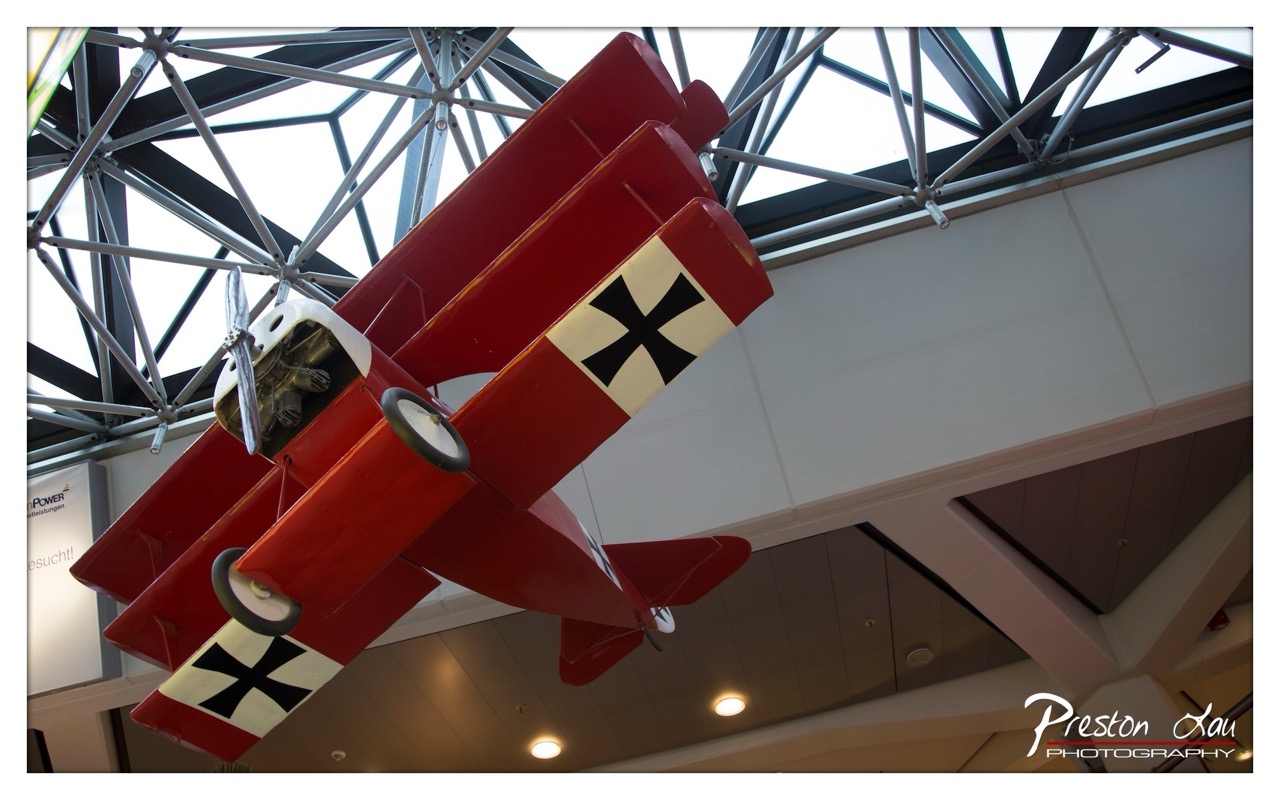

Red Wings Under the Dome
Subject Rating: 8/10
This photograph captures a vibrant red biplane, likely a replica of a World War I-era German aircraft like the Fokker Dr.I (though this appears to be a biplane model), suspended dynamically from the intricate, geodesic-like structure of a modern ceiling. The plane hangs at a jaunty angle, presenting its distinctive black and white Iron Cross insignia and small spoked wheels, appearing mid-flight through the vast indoor space. The background reveals a blend of the complex metalwork and glass panels of the ceiling structure, suggesting natural light filtering in, alongside polished white walls and darker ceiling panels with visible spotlights. A partially obscured sign in the lower left hints at the location being a public space, perhaps a museum, airport, or large exhibition hall. The overall mood is one of grandeur and historical tribute, placing this vintage flying machine in a surprisingly contemporary setting.
From a photographic standpoint, the composition uses the upward angle effectively, making the plane feel imposing and highlighting the contrast between the organic shape of the aircraft and the geometric precision of the ceiling. The dynamic diagonal lines of the plane's wings and the ceiling structure add energy to the frame. Lighting appears to be a mix of ambient light from above and artificial spotlights below, which nicely illuminate the red subject, making it pop against the background, although the bright ceiling areas are slightly blown out, sacrificing some detail there. The color is dominated by the bright red of the plane, which is rendered vividly, drawing the eye instantly. The placement of the plane within the frame is generally good, giving it room to 'fly,' although the large watermark in the lower right corner is quite distracting and unfortunately detracts from the overall image quality and viewing experience for a catalogued piece.
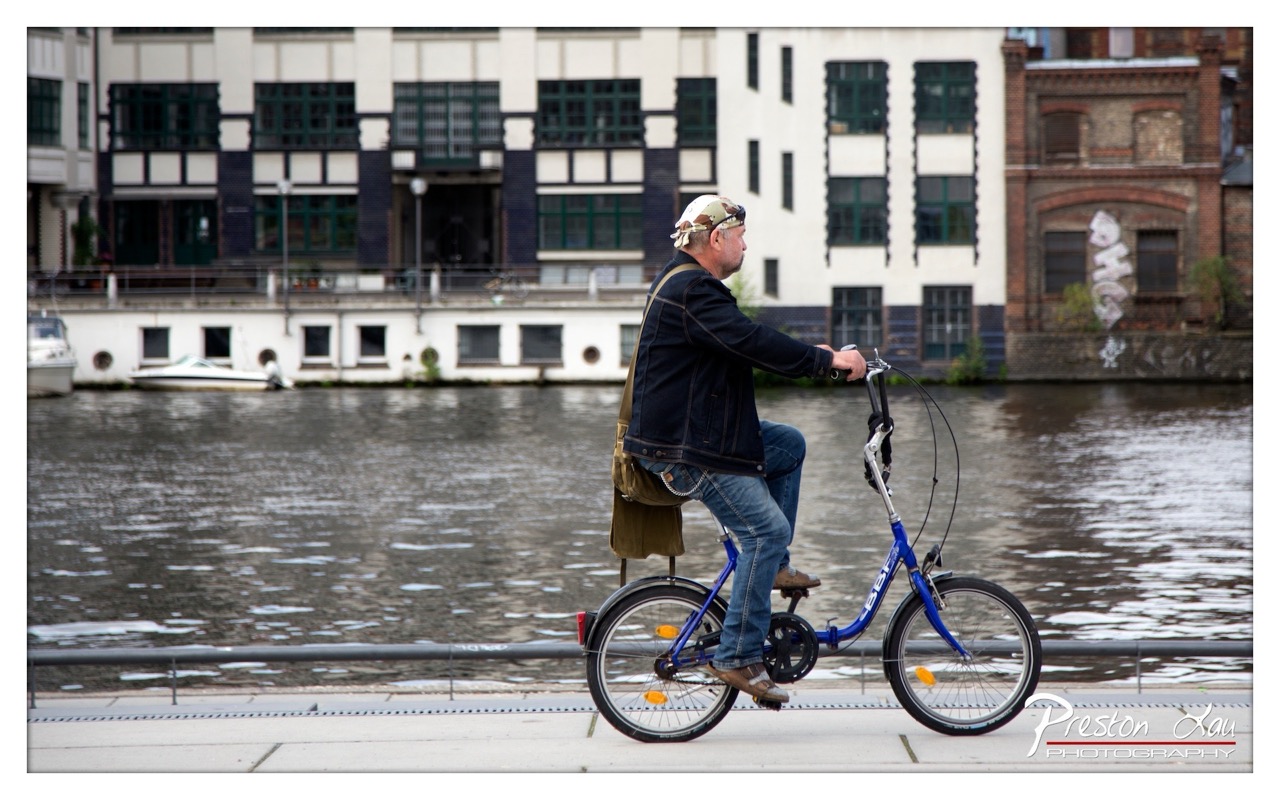

Urban Cyclist of Character
Subject Rating: 8/10
Here we have the star of the show: a gentleman of a certain age, confidently navigating the urban landscape on what appears to be a delightfully undersized blue folding bike. He's rocking a look that says "prepared for anything," complete with a camo bandana, a practical-looking satchel slung across his back, and sensible brown shoes. Riding along the waterfront with a relaxed posture, he embodies the spirit of independent mobility. It's a charming moment, capturing someone simply going about their day, perhaps commuting or perhaps just enjoying a scenic ride. The overall mood is calm and observational, finding a bit of everyday personality in a seemingly ordinary scene.
From a photographer's perspective, the composition places our cyclist off-center, giving him room to 'move' into the frame, a common and effective technique often bordering on the rule of thirds. The soft, overcast lighting is fantastic for this type of candid shot – no harsh shadows or blown-out highlights, just smooth, even illumination that brings out the textures of the man's jacket, the bike's paint, and the details in the background buildings. The color palette is muted, dominated by blues, greys, whites, and browns, fitting for an urban waterway scene on a cloudy day. The background provides context, with the contrasting architecture across the water – a large, multi-windowed structure next to an older brick building with visible graffiti – adding depth and a sense of place. The low railing in the foreground acts as a subtle visual separation, guiding the eye to the main subject while hinting at the path he's on. It's a solid documentary-style shot that captures a specific character within his environment.
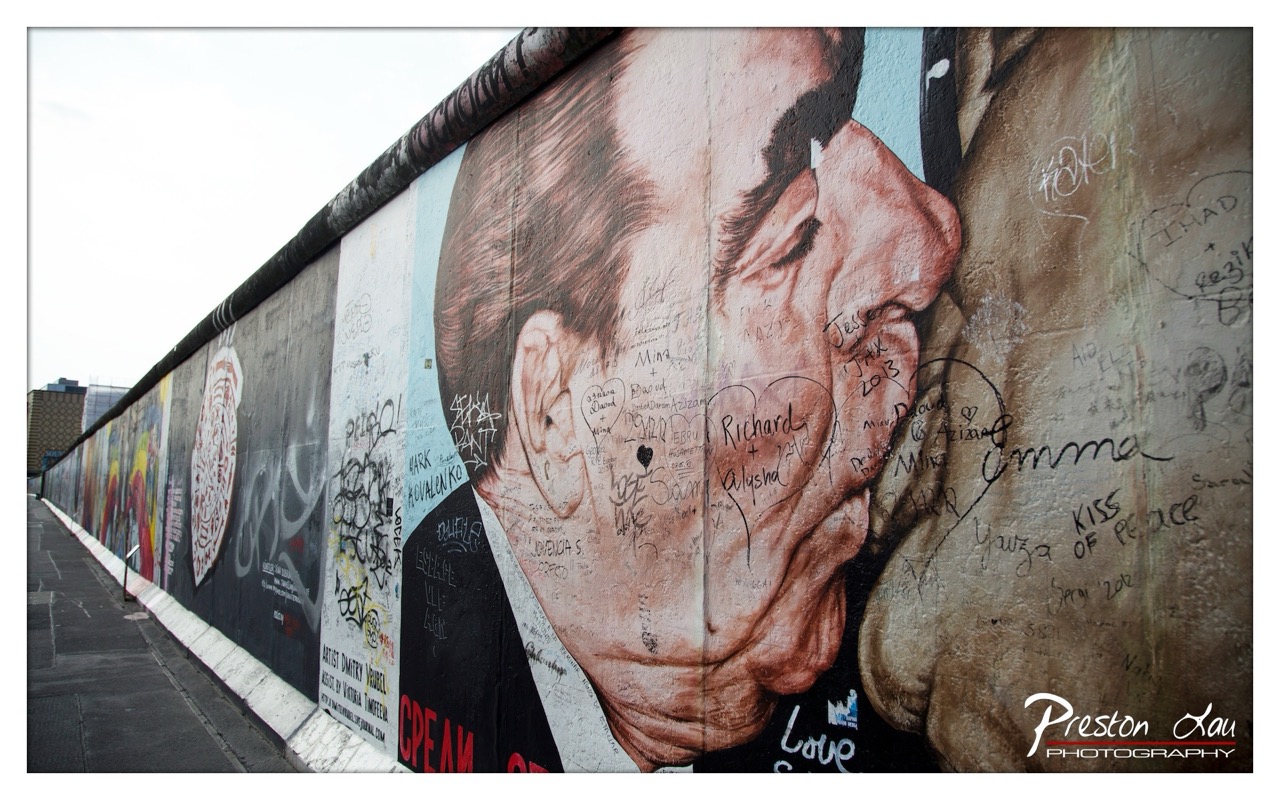

A Concrete Canvas of History and Tagging
Subject Rating: 9/10
Ah, the Berlin Wall. Not just a barrier, but now a sprawling canvas, albeit one that seems to have become a public guestbook for anyone with a sharpie or a can of spray paint. Here, we see the infamous 'Fraternal Kiss' mural, depicting a rather enthusiastic smooch between Soviet leader Leonid Brezhnev and East German boss Erich Honecker. A subject scoring a solid 9/10 for its sheer historical weight and provocative artistic statement. However, this poignant moment of geopolitical PDA is now layered with a democratic free-for-all of signatures, hearts, and various forms of modern hieroglyphics. It's like a yearbook for a particularly rowdy international class, turning a symbol of division into a monument to... well, slightly chaotic human inscription. The mood swings wildly from serious historical art to "Richard + Alysha" left their mark here.
From a photography standpoint, the wide shot captures the scale, with the wall acting as a powerful leading line drawing the eye down its length, showcasing the various murals that stretch into the distance. The perspective is well-chosen to convey the monumentality of the structure. The overcast lighting, while preventing harsh shadows, does result in a somewhat flat image – perhaps a touch more contrast or directional light would have given the textures more pop, especially the peeling paint and rough concrete under the graffiti. The color palette is dominated by the muted tones of the wall and the grey sky, punctuated by the vibrant bursts of graffiti, which, compositionally, add visual clutter but also tell a story of the wall's post-fall life. It's a documentation challenge – how do you photograph a masterpiece when it's been 'enhanced' by a thousand anonymous hands? Maybe the next shot needs a sign: "Please deface responsibly."
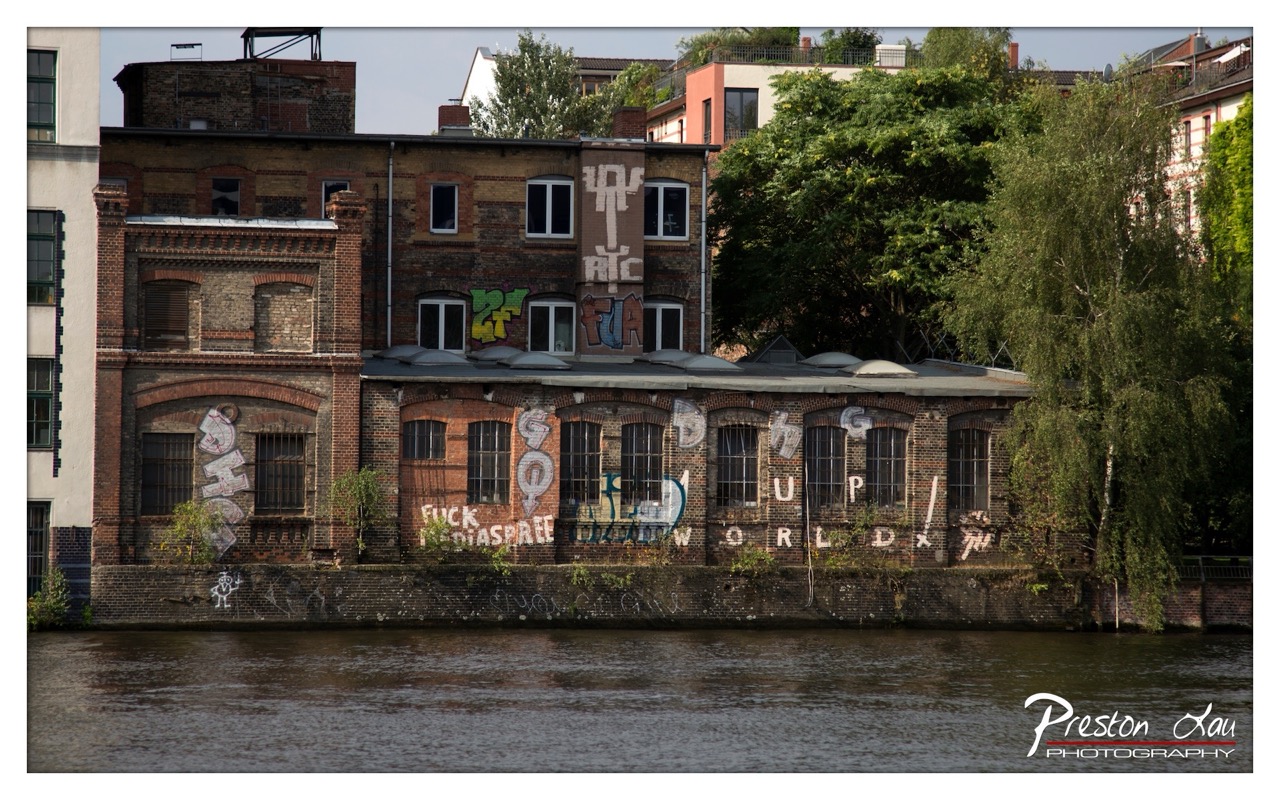

Graffiti Haven on the Spree
Subject Rating: 7/10
Here we have a classic scene of urban decay meets modern expression along what looks suspiciously like the Spree River in Berlin – judging by the "MEDIASPREE" tag, which is rather on the nose, isn't it? The main subject, a robust brick industrial building, stands as a monument to a bygone era, now serving as a canvas for various graffiti artists. We see layers upon layers of tags and pieces, transforming the weathered facade into a vibrant, chaotic tapestry. The overcast sky provides a soft, diffused light, which is great for avoiding harsh shadows and revealing the intricate textures of the old brickwork and the colorful scrawls. However, this flat lighting does make the scene feel a tad less dramatic than it might under more dynamic conditions. The composition is centered and stable, allowing the building to dominate the frame, while the calm, brown river in the foreground adds a sense of place and acts as a subtle leading line towards the structure.
The mood here is undeniably gritty, a blend of urban decay and defiant artistic life. It’s a scene that speaks of abandonment but also resilience and transformation. The colors are muted overall, dominated by the earthy reds and browns of the brick and water, with the graffiti injecting bursts of white, green, blue, and pink – a visual conversation between history and the present. Pertinent objects include the arched windows (some glassless, some boarded), the distinctive brickwork patterns, the various graffiti tags and pieces (like the large white block letters and the colorful spray-painted sections), the river itself, and the surrounding foliage and background buildings. The background shows a mix of trees and other structures, including what appears to be a more modern building, highlighting the juxtaposition of old and new in the urban landscape. It’s a photo that captures a specific style often seen in urban exploration photography, focusing on textures, decay, and the human element left behind, even if that element is just spray paint.
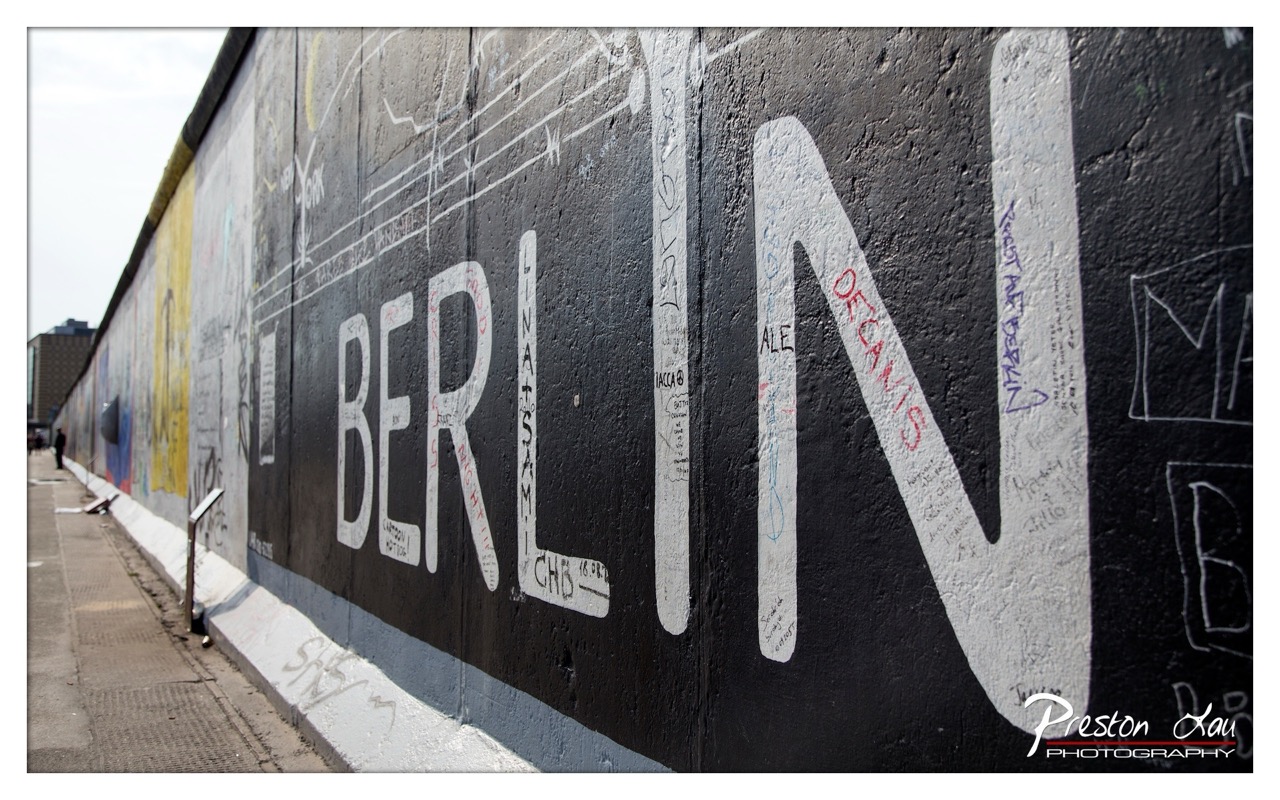

Berlin Wall Messages
Rating: 9/10
Ah, the Berlin Wall! Subject matter doesn't get much more historically significant than this concrete canvas, earning it a solid 9 for pure gravitas, even if some of the artwork is a bit… enthusiastic. What's happening here is a vivid display of history meeting contemporary expression; a long section of the infamous wall stretches into the distance, covered in layers of paint and personal messages. The most prominent feature is the massive, stylized white text spelling out "BERLIN," acting as a bold anchor in the frame, while countless smaller notes, signatures, and doodles are scrawled over and around it in various colors. The mood is a blend of solemn reflection on the past and vibrant, sometimes chaotic, affirmation of the present and future. It feels like a living monument, constantly being added to, despite its static nature. Pertinent objects include the distinct segments of the wall, the concrete base, the messy sidewalk, and the subtle hints of other large murals fading into the background, all testifying to its status as an open-air gallery and historical marker.
From a photographic perspective, the composition leans heavily on diagonal lines created by the wall receding into the distance and the sidewalk leading the eye forward. This creates a strong sense of depth and scale, emphasizing the length of this historical barrier. The lighting appears to be somewhat flat, perhaps under an overcast sky or during the brighter part of the day, which helps minimize harsh shadows on the graffiti but also reduces dramatic contrast. However, the bold white text of "BERLIN" pops effectively against the dark wall. The texture of the concrete is well-rendered, showing the roughness and layers of paint. While the background is blurred, it still shows the wall continuing, featuring glimpses of other, more colorful murals that are out of focus, adding context to the scene without distracting from the main subject – the large "BERLIN" text and the human element of the smaller scribbles. It's a classic documentary or travel shot, capturing an iconic location, though the sheer volume of messages might make you wonder if everyone who visited felt compelled to bring a Sharpie.
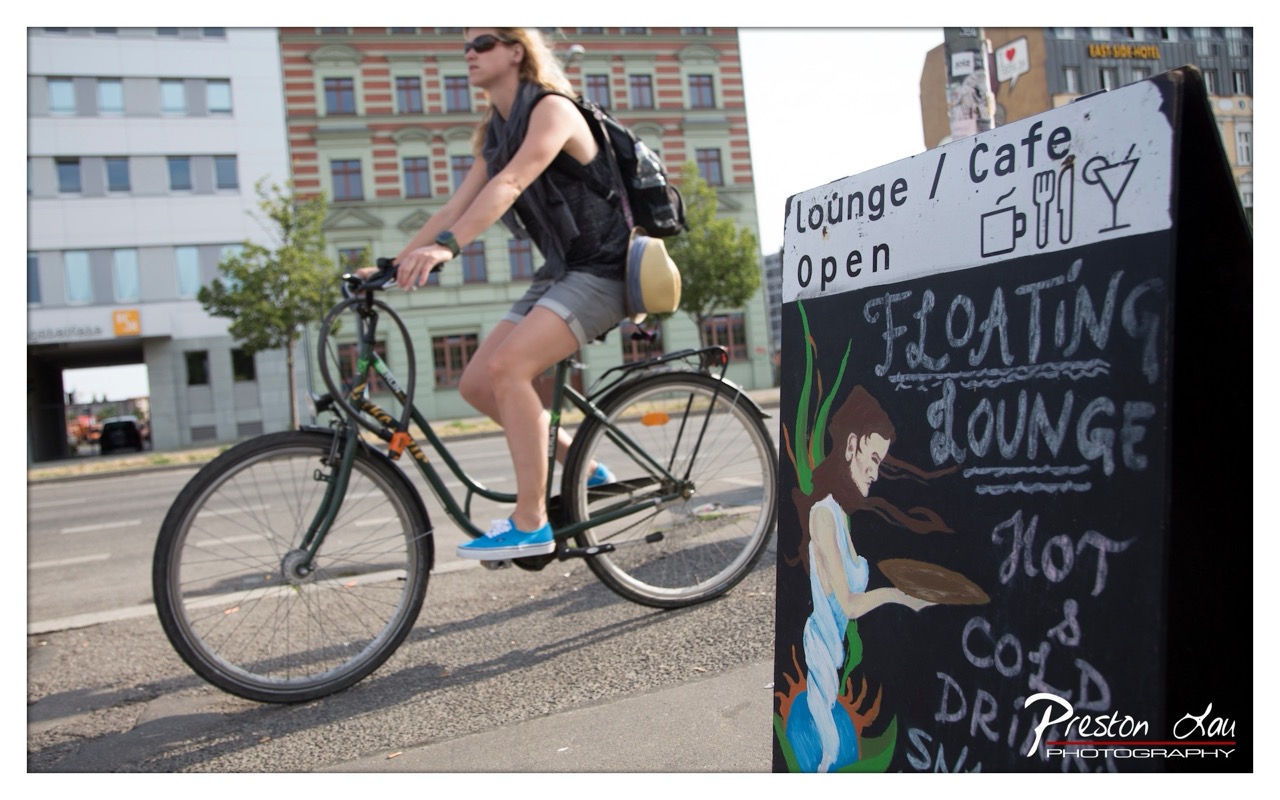

Urban Commute Meets Mystical Cafe Sign
Subject Rating: 7/10 - Our bicycling protagonist is certainly navigating the urban jungle with purpose, but her fashion-forward choice of shorts and shades, while practical, doesn't exactly scream "supermodel on wheels." She's doing her best! We see a woman riding a dark green bicycle down a sunny street, clad in a grey top, shorts, sunglasses, and distinctive bright blue sneakers. She has a backpack on and a wide-brimmed hat clipped to the back rack. The scene feels like a typical day in a bustling city, capturing a moment of effortless movement and daily routine. The mood is relaxed and summery, yet the juxtaposition with the sign on the right adds a layer of intrigue.
Compositionally, the image is a bit of a visual split personality, with the dynamic movement of the cyclist on the left contrasted by the static, painted sign on the right. The diagonal lines of the road and the bike add some energy to the left side, while the sign, placed prominently in the foreground on the right, dominates the other half, almost like two separate scenes awkwardly merged. Lighting is courtesy of a bright, likely overhead sun, casting strong shadows on the street, which gives the scene a high-contrast look typical of mid-day photography. Colors are relatively muted on the cyclist and background, except for the bright blue shoes, while the sign introduces hand-painted elements and text that draw the eye. The background features typical city architecture, with a modern white building next to an older brick one, suggesting a dynamic urban landscape. The quirky chalkboard sign, advertising a "Floating Lounge / Cafe," complete with rough drawings and what appears to be menu items, adds a touch of local character and humor, turning a simple commute scene into something a little more unique and memorable.
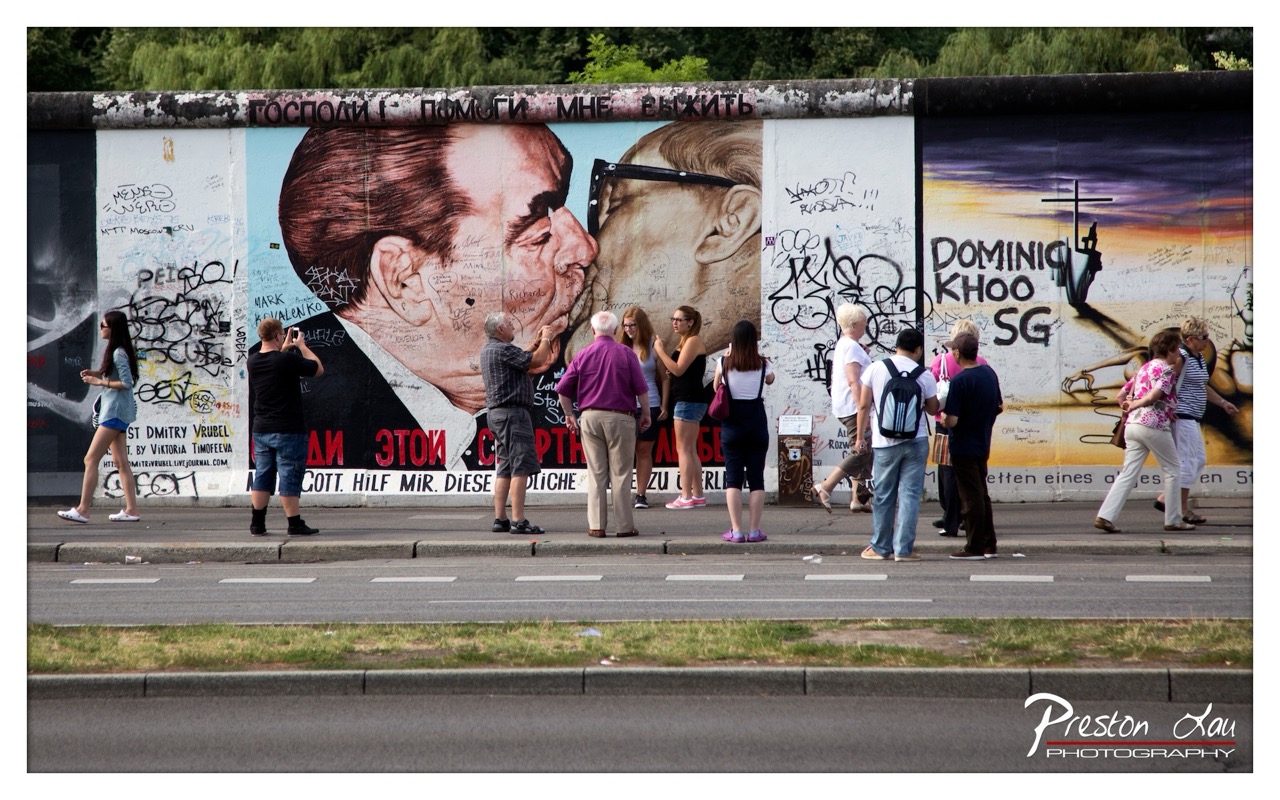

The Kiss and the Tourists
Subject Rating: 9/10 - The Berlin Wall's East Side Gallery, specifically featuring the iconic "Fraternal Kiss" mural, is a subject steeped in history and visual impact, making it a compelling photographic opportunity.
Here we see a snapshot of history literally coming to life, or at least being vigorously documented by modern visitors. A segment of the infamous Berlin Wall, now a vibrant open-air gallery, dominates the scene, proudly displaying Viktor Vilgelmovich Dmitriev's interpretation of the questionable brotherly affection shared between Leonid Brezhnev and Erich Honecker. A motley crew of tourists mill about, some gazing in wonder (or perhaps confusion), others busily snapping photos with their phones, presumably hoping to capture the perfect historical selfie with two deceased communist leaders locked in a passionate embrace. The mood is a fascinating blend of solemn historical reflection and casual twenty-first-century tourism; it's a place where the weight of the past meets the relentless click of digital cameras, proving that nothing says "remember the Cold War" quite like posing next to a giant painted kiss.
From a photographic perspective, the composition is straightforward but effective, placing the wall and its artwork front and center, allowing the human element – the viewers – to provide scale and context. The natural daylight is relatively even, doing a decent job of illuminating the murals without harsh shadows, which is a basic win for documenting public art. The vibrant colors of the artwork, especially the bold reds and blues of the "Fraternal Kiss" segment and the dramatic sunset of the adjacent panel, stand in stark contrast to the grey concrete canvas and the mundane road and sidewalk in the foreground. While the lighting isn't exactly Rembrandt, it serves the purpose of capturing the scene as it is, a candid moment of engagement with a piece of political history turned global tourist attraction. The scattered placement of people prevents the image from feeling cluttered, adding dynamic points of interest along the monumental structure.
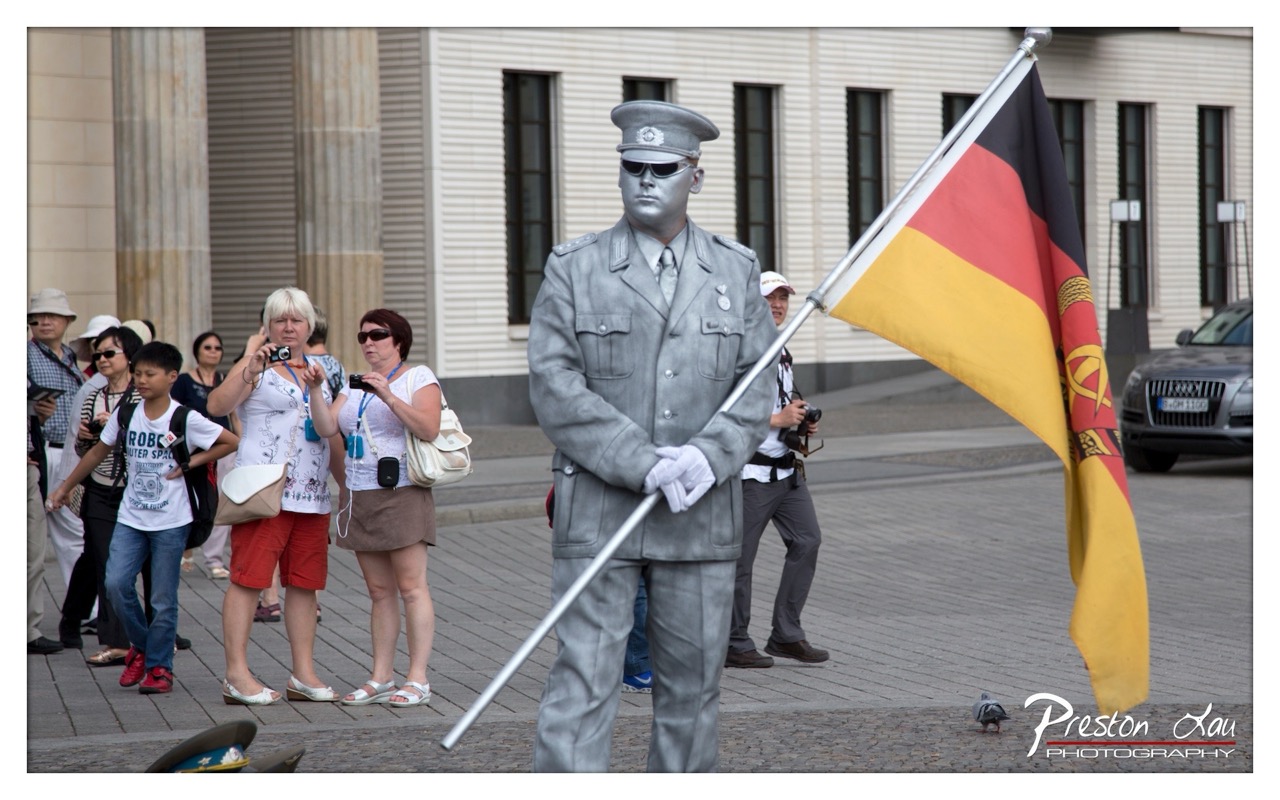

Berlin's Metallic Mascot
Rating: 8/10
Here we have a classic tourist scene elevated by the presence of a rather shiny character. Our main subject, rated a solid 8 for sheer visual novelty, is a street performer meticulously painted silver, clad in a historical-looking military uniform complete with cap, sunglasses, and white gloves. He stands stoically, holding a large German flag aloft, which billows slightly, adding a dynamic element to his static pose. The mood is a blend of theatrical performance and everyday tourism; while the silver man provides the spectacle, the backdrop of busy tourists, cameras clicking, and a distant car grounds the scene in reality. The contrast between the metallic, monochrome performer and the vibrant, tricolor flag is immediately striking and forms the core visual interest of the image.
From a photographic perspective, the composition places the striking figure and the flag front and center, utilizing the flag's diagonal line to add visual energy. The lighting appears soft and natural, effectively highlighting the reflective quality of the silver paint without harsh shadows, though perhaps a slightly more dramatic light could have enhanced the metallic effect further. The color palette is dominated by the bold red, black, and yellow of the German flag, which pops against the silver performer and the relatively muted tones of the background building and pavement. While the subject matter is engaging, the inclusion of a prominent watermark, though understandable for protection, does detract slightly from the overall visual flow. It's a well-captured moment, typical of scenes found in popular tourist areas, successfully highlighting an unusual subject amidst the everyday hustle and bustle.
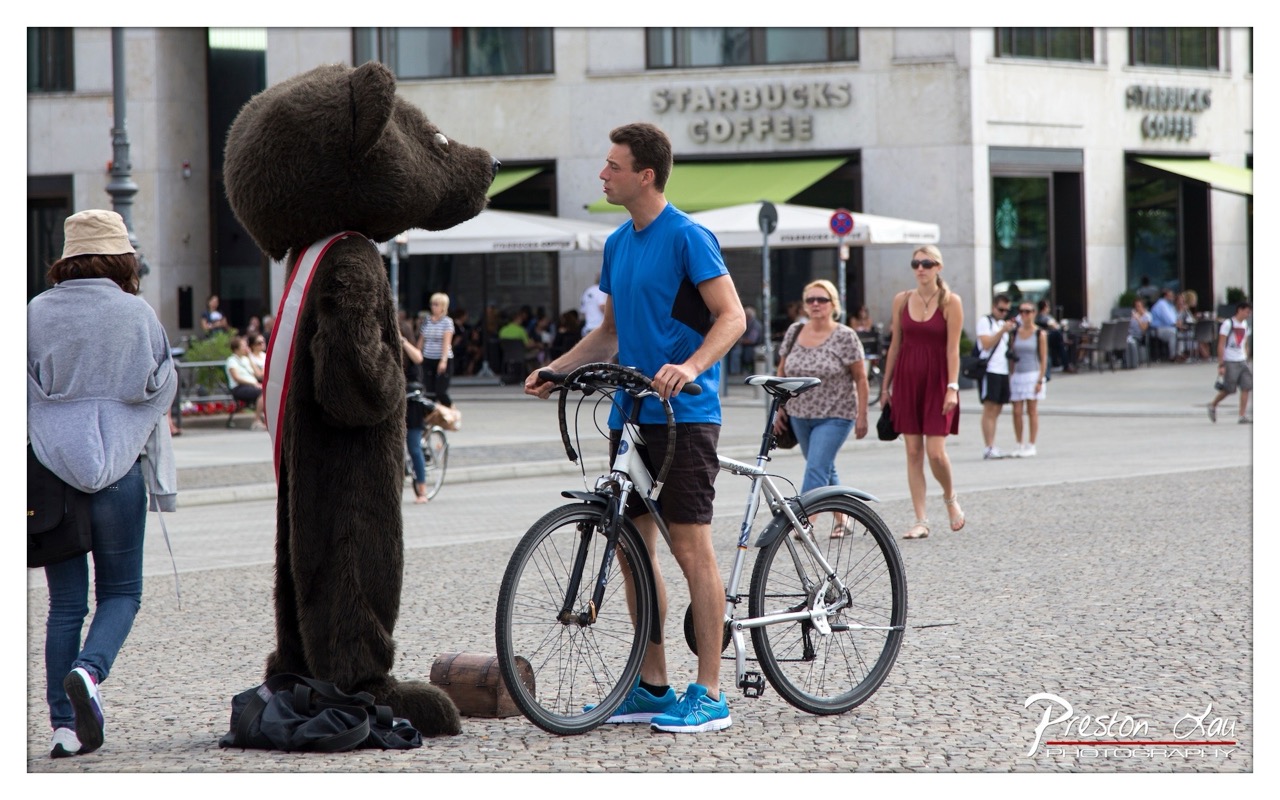

Street Encounter
Subject Rating: 8/10
Well, this isn't something you see every day – a massive, slightly bewildered-looking bear mascot having a chat with a guy holding a bicycle outside a Starbucks. Perhaps they're discussing pedal-powered versus paw-powered transportation, or maybe the bear is just confused about why his hibernation was interrupted for a coffee run. The mood is definitely quirky and unexpected, leaning towards lighthearted and slightly surreal. Our bear friend stands tall with a rather official-looking red and white sash, looking like a fluffy dignitary, while the cyclist, dressed in a bright blue shirt, seems engaged in the conversation, or perhaps just patiently waiting for the furry obstruction to move. Other people mill about in the background, seemingly oblivious to this momentous meeting of man and mascot, adding to the slightly bizarre normalcy of the scene. A discarded bag and a wooden box sit near the bear's feet, hinting at a possible street performance setup.
From a photographic perspective, the composition centers the main subjects well, capturing the height difference and interaction effectively. The slightly low angle emphasizes the bear's stature. The lighting is fairly bright and even, suggesting an overcast or diffused sunny day, preventing harsh shadows but also making the colors feel a little muted, except for the cyclist's vibrant shirt and the bear's striking sash. The cobblestone ground adds texture to the foreground, grounding the scene. The background is a bustling streetscape featuring a Starbucks store with its iconic logo, adding a familiar anchor to the unusual foreground. The depth of field is shallow enough to slightly blur the background crowd, directing focus to the main subjects without completely losing the context of the busy urban environment. It's a candid street shot capturing a fleeting, humorous moment that probably deserved its own reality show segment.
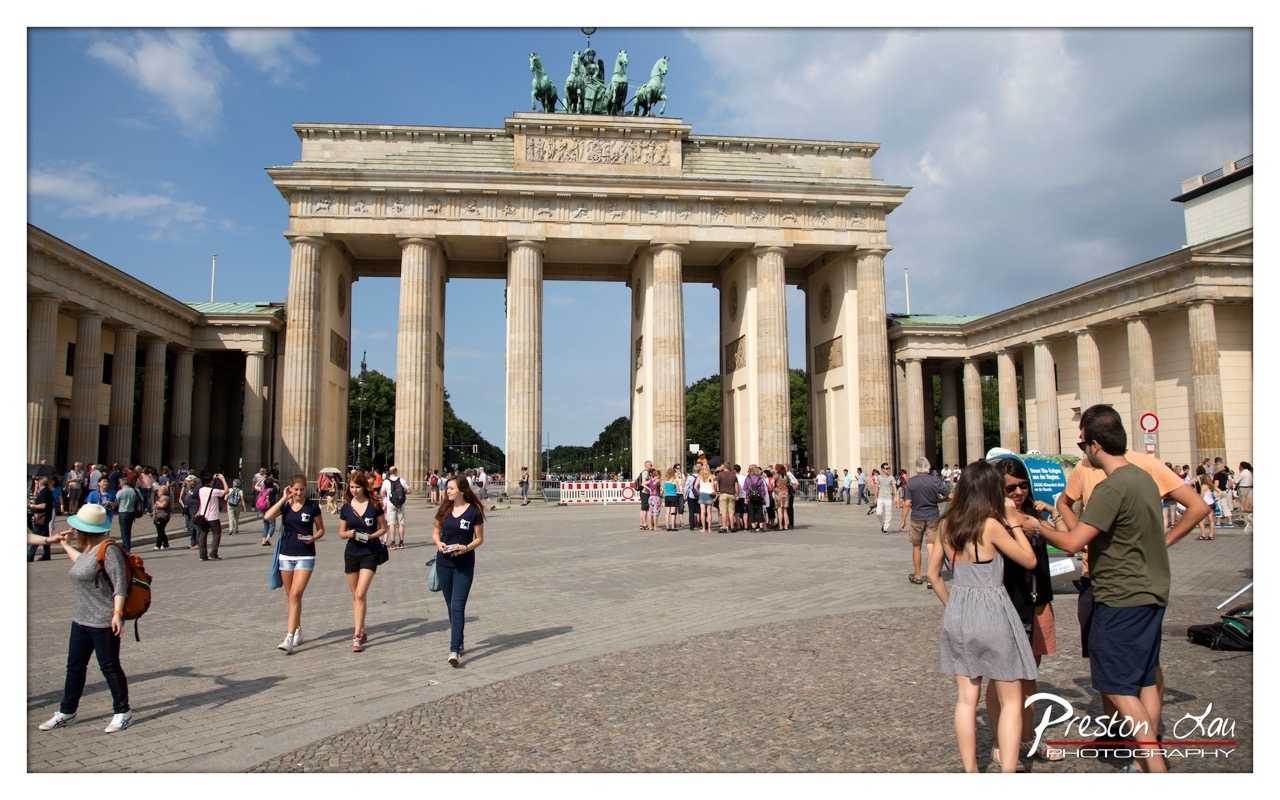

Brandenburg Gate: A Symphony of Tourists and Pillars
Subject Rating: 7.5/10
Ah, the Brandenburg Gate – a classic Berlin landmark captured in its natural state: swarming with tourists. This image perfectly encapsulates the bustling energy of a popular historical site on a pleasant day. People are milling about, some are clearly focused on getting their obligatory selfie or family shot, while others are simply soaking in the atmosphere. The mood is lively and a tad chaotic, like trying to navigate a Saturday market during peak hours, but with significantly more historical significance. It's a snapshot of global pilgrimage to a symbol of German history, proving that no matter how grand the architecture, the real stars are always the folks trying to find the best angle.
From a photographic standpoint, the composition is centered on the magnificent gate, allowing its scale and detail to dominate the upper frame. The foreground is filled with the dynamic ebb and flow of the crowd, adding a sense of life, though perhaps sacrificing that clean, architectural shot many photographers yearn for. The lighting is a mixed bag – a sunny day with scattered clouds provides some definition and shadow on the gate's columns, but also creates bright highlights and potentially harsh shadows on the ground and people. Color-wise, the warm tones of the gate's stone contrast nicely with the blue sky (partially obscured by clouds threatening a mood change). The subject matter is, undeniably, the gate, but the real story here is the human element interacting with it. The photographer has opted for a wider view, embracing the entire scene rather than isolating the architecture, giving a truthful account of the visitor experience – complete with a signature watermark, a stylish touch to claim this moment of organized delightful chaos.
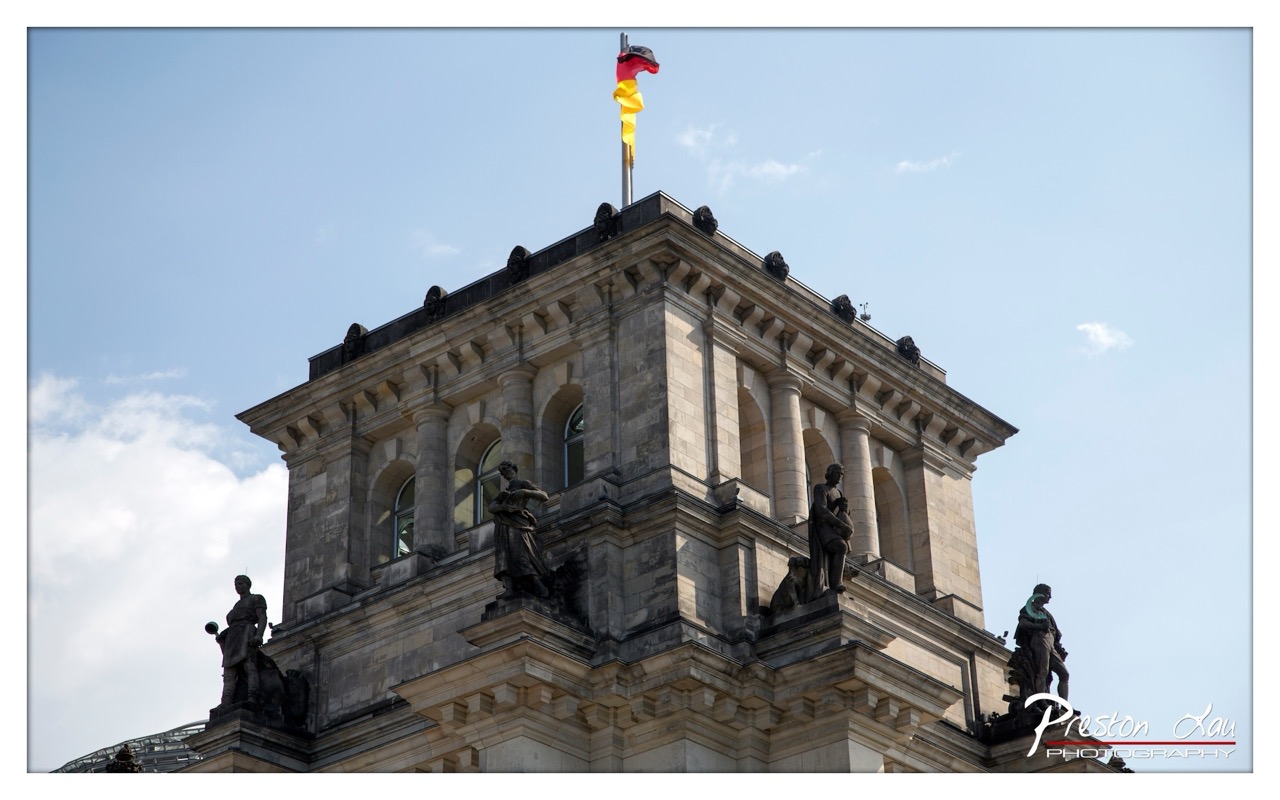

Corner of Power
Rating: 7/10
Here we have a classic view looking up at the corner of a grand stone building, likely something significant given the large German flag proudly fluttering against a clear blue sky. The architecture is impressive, featuring sturdy pillars, elegant arched windows, and decorative stonework that speaks of history and gravitas. Perched along the roofline are several statues, seemingly contemplating the view or perhaps just trying to remember where they left their chisels. The overall mood is one of stately importance and sunny optimism, a perfect day to visit a national landmark or perhaps just enjoy the weather after a particularly lengthy debate about infrastructure budgets.
From a photography standpoint, the composition uses a low angle to great effect, making the building appear even more monumental, although it does leave a generous expanse of bright blue sky which, while nice, takes up a significant portion of the frame. The diagonal lines formed by the building's corner and the edge of the roof provide a strong visual line leading the eye up towards the flag, which adds a crucial splash of color to the otherwise monochromatic stone. The lighting is bright and even, highlighting the texture of the stone and the details of the sculptures, though it seems like a classic midday shot, which can sometimes be a bit harsh. It captures the essence of the place effectively, delivering a solid architectural shot with a touch of national pride.
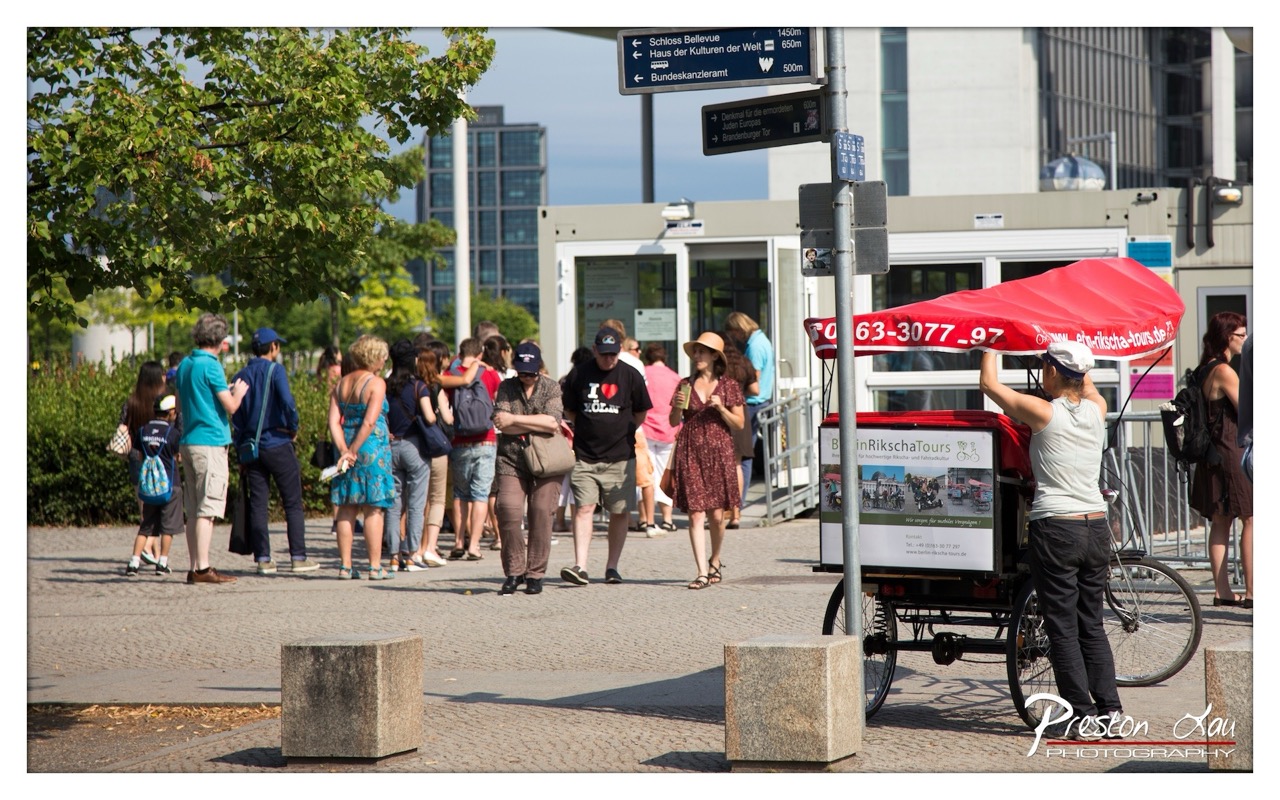

Berlin Rickshaw Blues
Subject Rating: 6/10
Ah, the classic tourist waiting game, captured here with a bright red rickshaw acting as the unintentional star. We're treated to a slice of summer life, likely in Berlin given the directory signs in the background pointing to landmarks like the Bundeskanzleramt. A queue of hopeful tourists forms, waiting for their turn to experience the city, perhaps in a slightly more eco-friendly (or thigh-friendly for the driver) manner. The mood is one of mild anticipation and the general bustle of a warm day at a popular spot. The rickshaw driver, back turned to the camera, is meticulously adjusting the canopy, perhaps shielding future passengers from the sun or a sudden, unlikely downpour. It's a snapshot of everyday tourist infrastructure – functional, slightly quirky, and always involving a bit of a wait.
From a photographic standpoint, the composition is decent, using the foreground concrete blocks to add depth, although they slightly obstruct the view. The shallow depth of field nicely separates the main subjects and the rickshaw from the slightly softer background, giving a sense of layers. Lighting is typical harsh midday sun, creating strong shadows, which can be tricky, but it highlights the vibrant red of the rickshaw canopy. The colors feel natural and summery. It functions as a documentary-style street photograph, capturing a specific moment in time and place. It tells a little story: "People wait in line for a rickshaw tour under a big tree." Perhaps not groundbreaking, but a solid capture of the scene's reality, even if the lighting isn't ideal for portraiture.
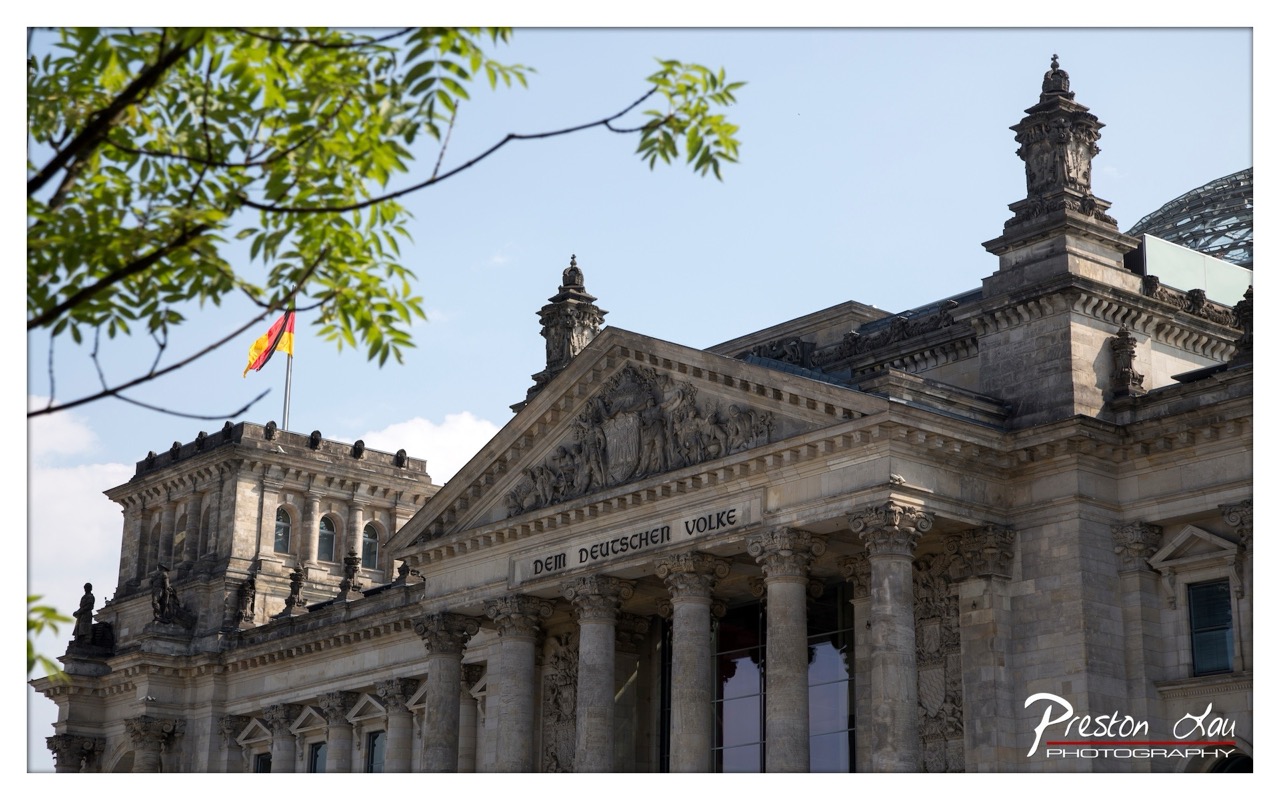

Title: Parliamentary Peaks and Patriotic Foliage
Rating: Subject Rating: 9/10
Ah, the majestic Reichstag, looking rather grand and important, as one would expect from the seat of German democracy. What's happening here? Mostly just standing around, looking stoic, while a German flag bravely flutters in the breeze, seemingly debating whether to wave left or right. The mood is one of civic gravitas meets a surprisingly pleasant sunny day. It's like the building is saying, "Yes, important things happen here, but look, pretty leaves!" The subject matter is undeniably significant – a true historical landmark. You can almost hear the echoes of debates, or perhaps just the gentle rustling of the strategically placed tree branches, which definitely add a touch of natural flair to the imposing stonework.
From a photographic perspective, the composition plays with layers, using the leafy branches in the foreground to frame the imposing architecture behind. This adds depth and a touch of organic chaos to the otherwise structured scene, though it does obscure some of the building's upper reaches. The low angle emphasizes the building's scale, making you feel appropriately small and insignificant compared to the weight of history and stone. Lighting is bright and clear, indicating a sunny day and casting sharp shadows that highlight the intricate stonework and architectural details, like the "DEM DEUTSCHEN VOLKE" inscription – always a nice touch to remind you who this place serves (or perhaps just who paid for the renovation). The colors are natural and appealing – the warm stone, the vibrant flag, the crisp green leaves against a clear blue sky. It's a classic architectural shot, elevated slightly by the natural framing, proving even serious buildings can look good on camera with a bit of greenery.
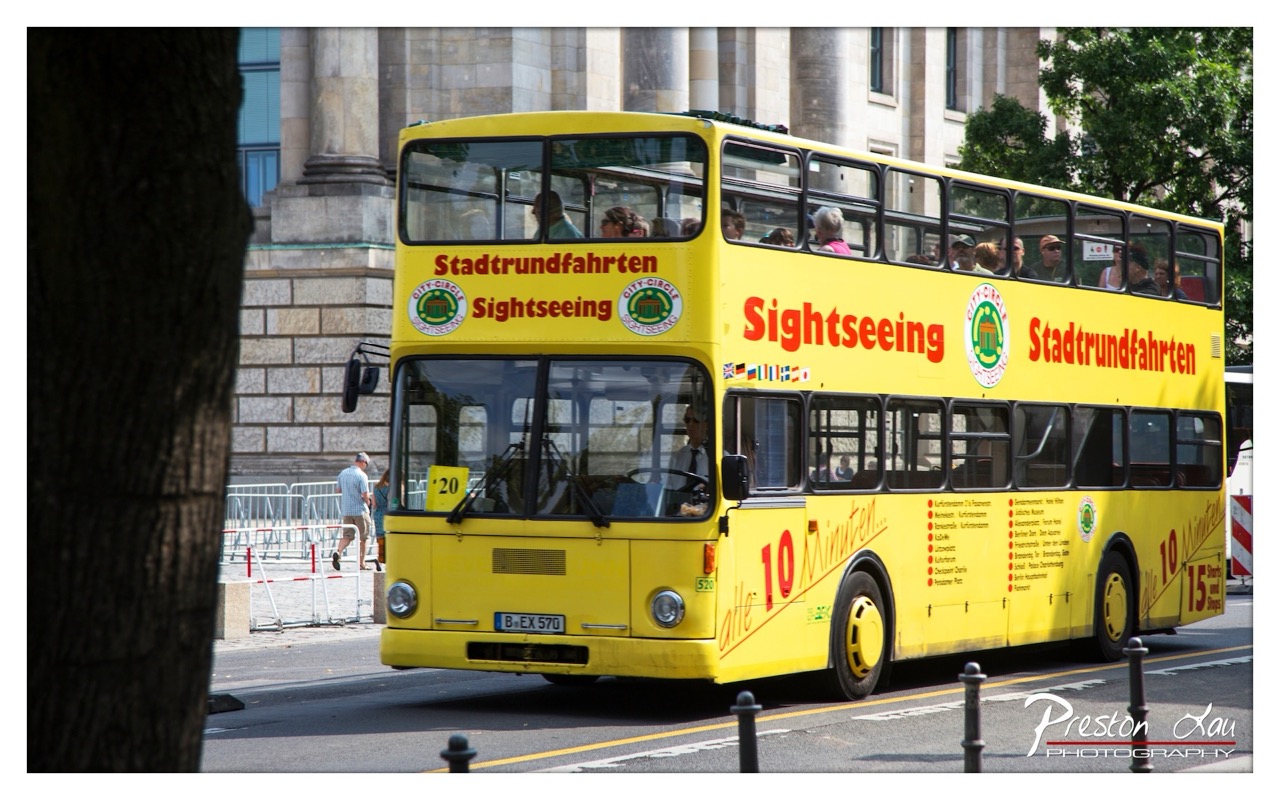

Big Yellow Bus Energy
Rating: 7/10 (for the bus, it's working hard)
Ah, the majestic yellow double-decker sightseeing bus, a true titan of tourist transportation. Our subject here, a vibrant splash of banana peel yellow, is caught mid-rumble through what appears to be a rather grand European city, likely Berlin given the German text advertising "Stadtrundfahrten Sightseeing." What's happening? Well, exactly what you'd expect: people are bundled onto both decks, presumably soaking in the architectural wonders or perhaps just enjoying a break from walking while the bus driver navigates the complex world of inner-city tourism. The mood is bright and sunny, perhaps a tad mundane for the jaded traveler, but full of potential discovery for those fresh off the plane, ready to tick off landmarks listed on the side of the bus. The bus itself, a trusty workhorse, stands out dramatically against the more subdued stone facade of the building in the background and the deep, textured bark of the foreground tree.
From a photographic perspective, this shot captures a slice of street life with a focus on the main event: the bus. Compositionally, the tree on the left serves as a strong foreground element, though one might argue it's slightly too dominant, acting like a stage curtain drawn a bit too far across the star performer. The lighting is typical of a bright day, creating strong highlights and shadows which give the bus a solid, tangible feel but might be slightly harsh. The color palette is heavily anchored by the bus's bold yellow, effectively drawing the eye and providing a cheerful contrast to the neutral building behind. The subject matter is straightforward travel photography, documenting a common sight. While not breaking any compositional boundaries, it successfully isolates the iconic bus, capturing its functional beauty and the promise of exploration it represents, despite the photographic challenge posed by that leafy photobomber.
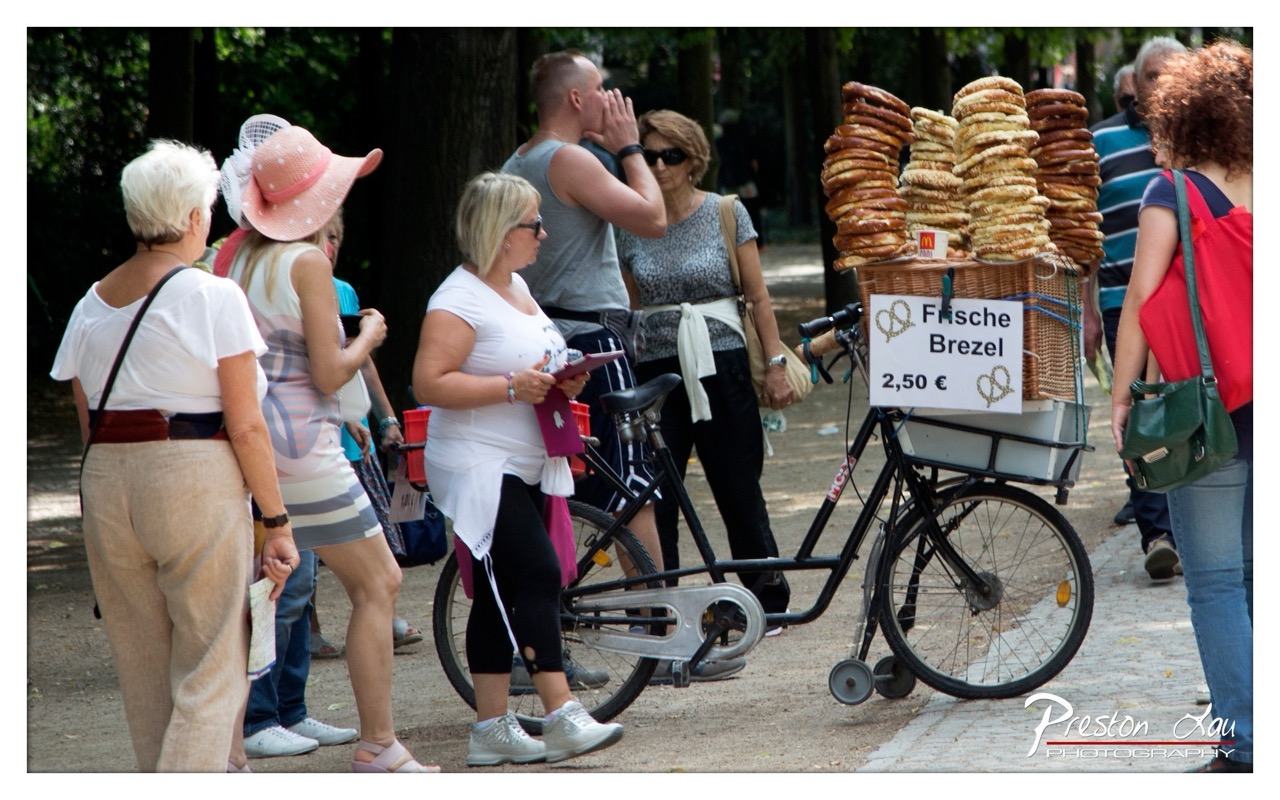

The Great Pretzel Mountain
Subject Rating: 7/10
This scene captures a lively moment in what appears to be a park or outdoor gathering, centered around an impressive mobile pretzel stand. The star, besides the crowd, is undeniably the bicycle laden with a staggering mountain of "Frische Brezel" (Fresh Pretzels), advertised at a very reasonable 2,50 €. People are milling about, engaging with each other and likely eyeing up the golden, baked goodness. We see a mix of characters: a woman in a stylish pink hat, another reviewing some paperwork, a man seemingly calling out loudly, and others simply passing by or waiting. The mood feels bustling and casual, the kind of scene you'd stumble upon during a pleasant day out, possibly near a popular attraction given the density of the crowd and the vendor setup. The bicycle itself, with its large front basket and stabilizing wheels, is a fascinating object, clearly designed for transporting large quantities of doughy delights.
From a photographic perspective, this is a challenging candid scene. The composition feels a bit cluttered, capturing a wide range of activities and individuals without a single, clear focal point, although the pretzel bike draws the eye effectively with its sheer volume and prominent sign. Midday lighting creates some contrast and potentially harsh highlights or shadows, typical difficulties when shooting outdoors without controlling the light – notice how some figures are a bit dark or brightly lit depending on their position. The colors are naturalistic, reflecting the outdoor environment and the earthy tones of the pretzels and clothing, punctuated by the vibrant pink hat and red bag. It feels like a quick, handheld shot aimed at capturing the overall atmosphere and the unique pretzel vendor setup. While not perfectly composed or lit, it successfully conveys the energy of the moment and the quirky subject matter. The background is nicely blurred, helping to separate the main subjects from the less important elements, a good use of aperture (or distance and focal length) to add a little depth.
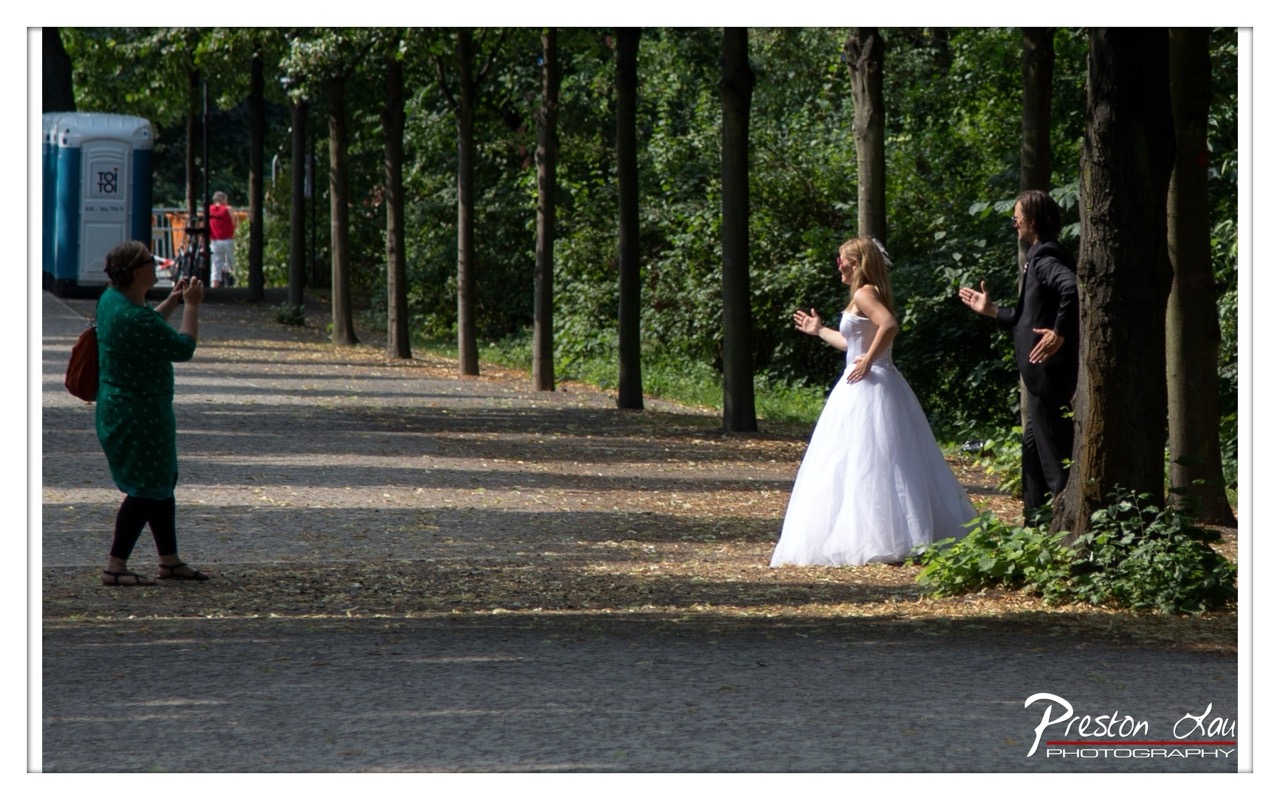

Behind the Scenes of Wedded Bliss (and Paparazzi)
Subject Rating: 6/10
Ah, the classic wedding shoot - a beautiful moment captured... or is it? Here we have a scene that perfectly encapsulates the modern wedding experience: the happy couple, striking a pose under the dappled light filtering through the trees, seemingly directed by an unseen master photographer. The bride, a vision in white, and the groom, dapper in black, are mid-gesture, perhaps mimicking the flight of doves or just waving goodbye to their single lives. But wait, there's a twist! On the left, a keen observer in a vibrant green dress has decided *this* is the shot, whipping out their phone to capture their own version of this romantic tableau, creating a delightful case of photoception. The mood is a mix of staged formality and unexpected reality, punctuated by the jarring presence of a blue portable toilet in the background, adding a touch of stark utility to the pastoral setting.
From a photographic standpoint, this image is a fascinating study in layers and perspectives. The composition is anchored by the receding path and the strong vertical lines of the trees, creating a sense of depth, although the empty space in the middle feels a bit vast. The lighting, while creating lovely patterns on the ground, casts some shadows and highlights that aren't ideally placed on the subjects. The color palette is dominated by greens, nicely contrasted by the bride's white dress and the pop of the blue toilet (truly, a compositional challenge). The style is clearly a candid capture of a planned event, showcasing the chaotic beauty of people interacting and documenting. While the main subjects are clear, the presence of the 'other' photographer and the background elements dilute the focus, making it a document of the *event* of the photoshoot, rather than a perfect portrait. The watermark reminds us someone intended to capture this, perhaps realizing the humorous reality unfolding before them.
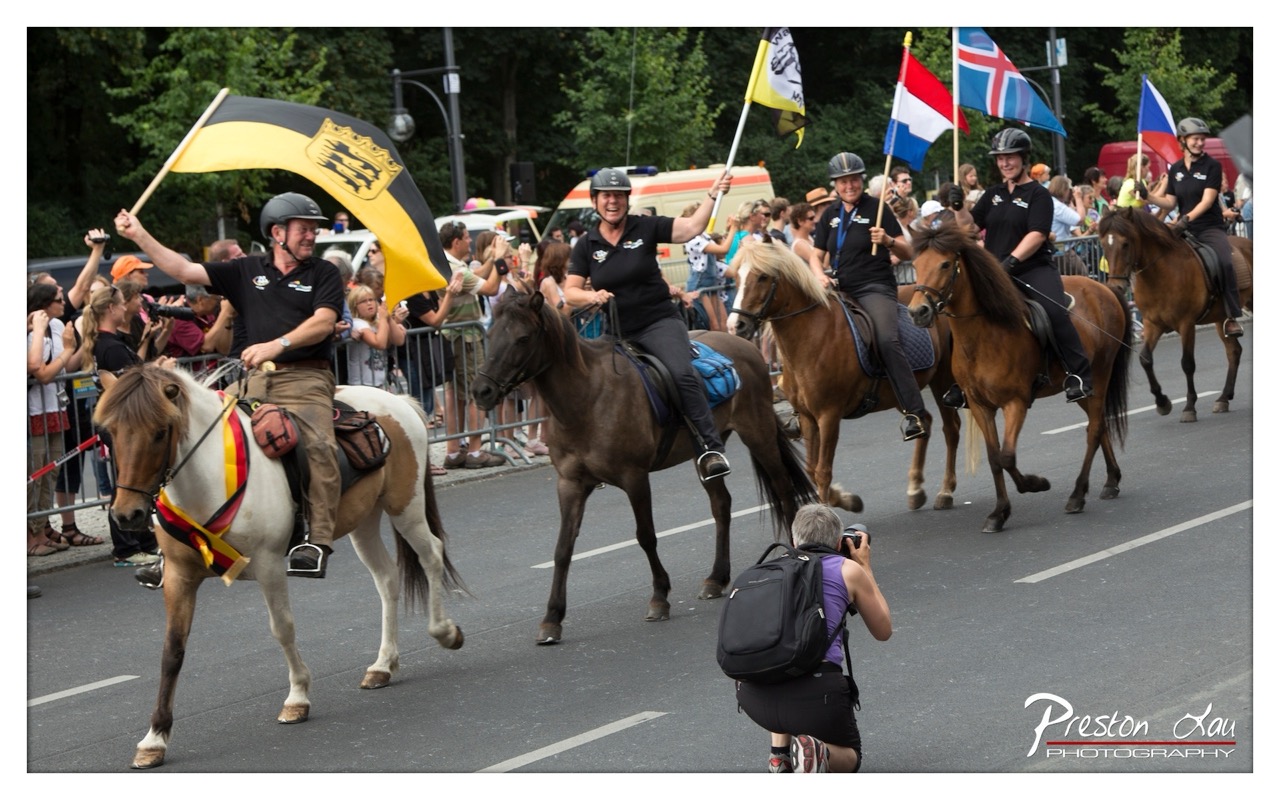

An Equestrian Extravaganza, Documented
Rating: 8/10
This image gallops right into the heart of a lively parade, featuring a procession of riders on sturdy horses, perhaps Icelandic ponies given their appearance, proudly carrying various flags. The scene exudes a festive and energetic mood, capturing the spirit of a community event. Our lead rider, sporting a fetching black polo shirt and helmet, waves a striking yellow and black flag with some regal crest, while behind him, others follow suit with national flags, adding an international flavor to the proceedings. Spectators are visible behind barriers on the left, participating in the excitement. It's a classic parade moment, full of motion and interaction, with the main subjects being the well-turned-out horses and their enthusiastic riders.
From a photographic perspective, the composition uses the diagonal lines of the horses moving through the frame effectively, creating a sense of dynamic forward motion. Including the kneeling photographer in the foreground adds an interesting layer – it's either a slightly risky compositional choice or a meta-commentary on the act of capturing the event itself. The lighting is typical bright daylight, providing even illumination that highlights the subjects and colors of the flags, though lacking the dramatic shadows or highlights of magic hour (because parades rarely wait for perfect light, obviously). The background of cheering crowds, trees, and the street provides context without being overly distracting, keeping the focus on the equine participants and their human counterparts. It's a solid documentary-style shot, capturing the essential elements of the scene with clarity, although perhaps lacking that unique visual punch that would elevate it to truly iconic status – maybe the lead horse needed a tiny top hat? Just a thought.
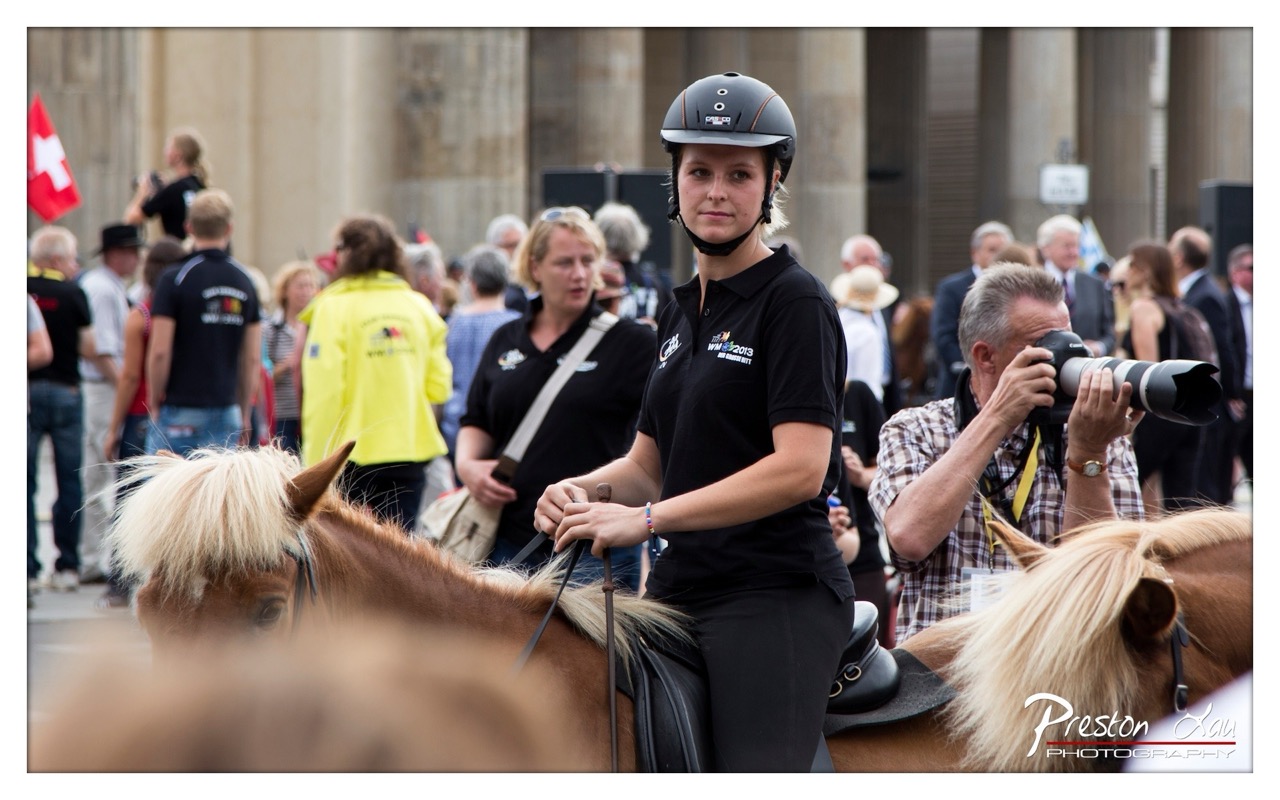

Equestrian Focus in the Crowd
Subject Rating: 9/10
Captured amidst the buzz of a public event, the image centers on a determined young woman astride her horse. Clad in a black riding helmet and a smart black polo shirt (emblazoned with what appears to be event branding), she holds a riding crop, her gaze fixed intently slightly off-camera. Her focus suggests deep concentration, perhaps preparing for or participating in a parade or competition. The foreground features the head of another horse, slightly out of focus, creating a sense of being embedded within the activity. This close-up perspective on the rider and her immediate equine companion effectively draws the viewer into her world, giving a glimpse of the intensity required in such a setting. The soft, even lighting suggests it's either a cloudy day or late afternoon, providing pleasant, diffused illumination that highlights the subject without harsh shadows.
The scene unfolds against a backdrop of a bustling crowd and the imposing, blurred architecture of a grand building with columns, hinting at a significant location like the Brandenburg Gate in Berlin (visible text on shirt reads "WM 2013 Berlin"). The sheer number of people adds to the feeling of a major event, though their blurriness, thanks to the shallow depth of field, keeps the focus squarely on the rider. Adding a touch of meta-narrative, a gentleman in the background is actively taking a photo with a substantial telephoto lens – perhaps capturing this very rider, or another aspect of the event. This inclusion is a fun detail, showing the event being documented in real-time. The composition successfully layers the scene from the blurred foreground horse, through the sharp main subject, to the softer crowd and architectural background, although the prominent, out-of-focus horse head in the lower left could be considered slightly distracting depending on taste. Overall, it's a well-executed capture of a moment of focus and activity within a large public gathering.
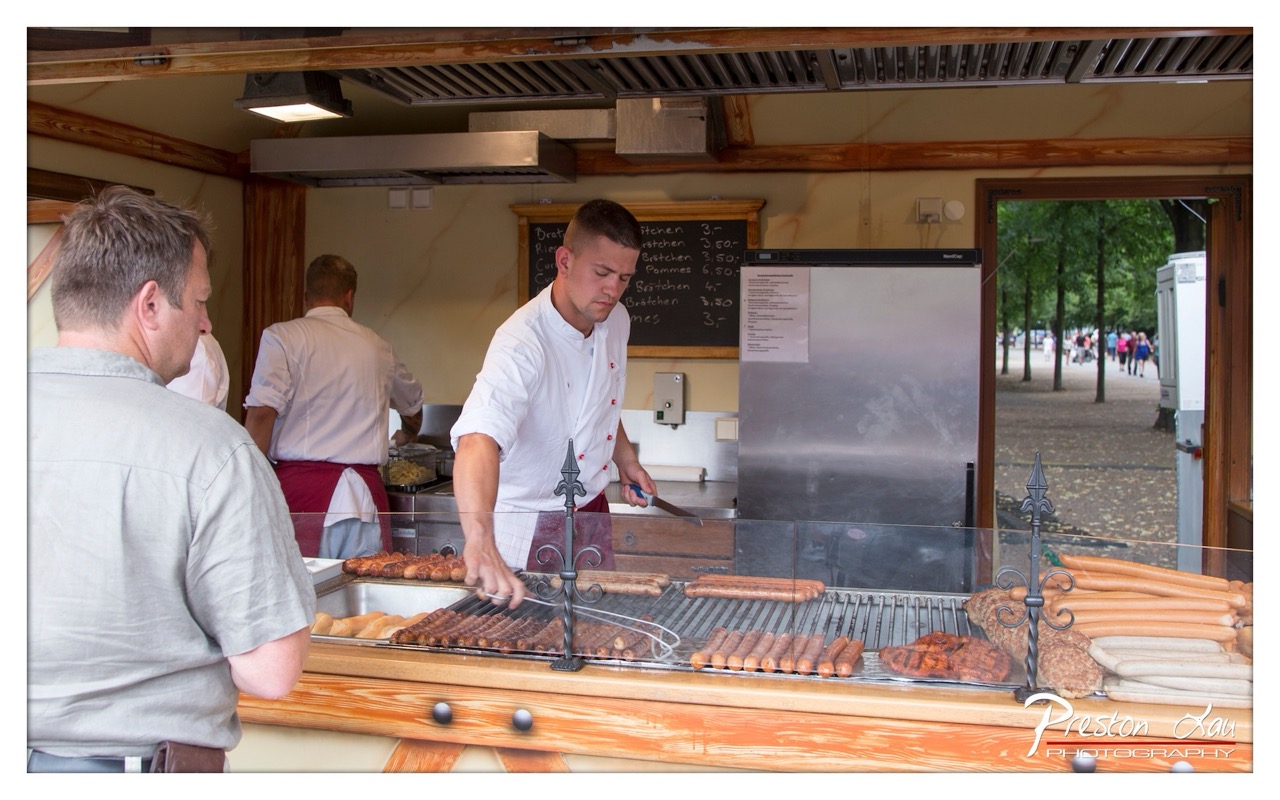

Wurst Case Scenario
Subject Rating: 8/10
Alright folks, gather 'round the wurst-mobile! We're witnessing a full-blown sausage operation here, a true German culinary battlefield. In the foreground, a gentleman is contemplating his life choices, or perhaps just the sheer magnitude of grilled meat before him, sporting a casual grey shirt and what looks like a fanny pack – a bold fashion statement only the promise of sausage can justify. Behind a protective glass barrier, a dedicated grill master in a pristine white chef's jacket is intensely focused, spatula in hand, tending to a veritable mountain of sizzling sausages and what appears to be some meaty patties. To his left, another vendor is seen in the background, busy with preparations. The mood is hungry, slightly chaotic, and undeniably aromatic. We've got a smorgasbord of wurst varieties lined up, ready for their close-up (and eventual consumption), sitting proudly on a gleaming metal grill that clearly sees a lot of action. The wooden counter adds a rustic, traditional touch to this temple of grilled meats, complete with decorative metal spikes that seem to be guarding the precious cargo.
From a photography perspective, this shot perfectly captures the bustling energy of a popular food stand. The composition uses the foreground customer to frame the scene and add a sense of participation, even if he's slightly obscuring the view – a common challenge in candid street shots. The main grill master is well-placed, drawing the eye to the central action, his serious expression a testament to the high-stakes world of sausage grilling. Lighting seems to be a mix of natural daylight filtering in and perhaps some internal lighting from the stand, creating a decent exposure with good detail on the sausages (important!). The color palette is dominated by the warm browns and reds of the meat and wood, offset by the cool tones of the metal equipment and the green trees peeking through the doorway in the background. Speaking of the background, that glimpse into a leafy park with people strolling adds crucial context, reminding us this isn't just about the food, but the lively atmosphere of an outdoor event or market. It's a slice-of-life capture, slightly documentary in style, showcasing the craft and the customer interaction, proving that sometimes, the most compelling subjects are the simple, delicious ones found on the street.
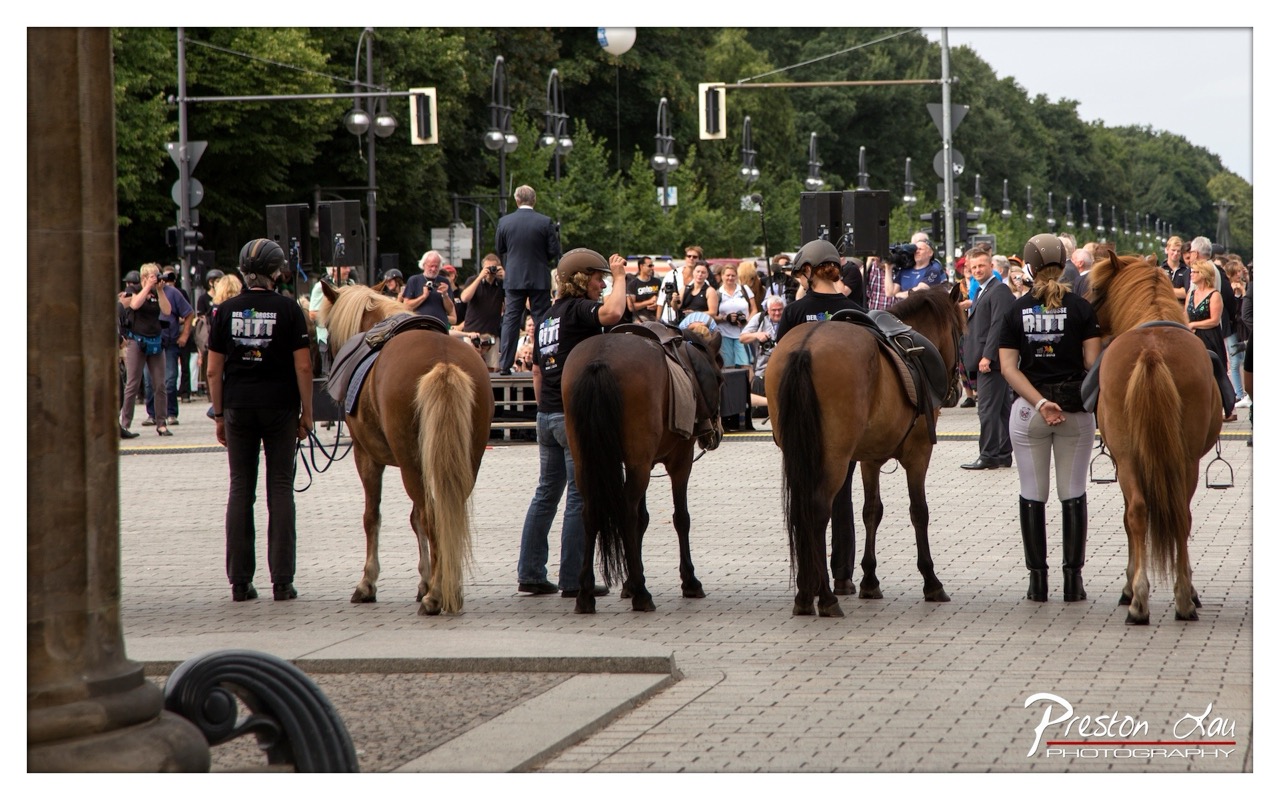

Title: The Waiting Game (or: Best Butts of Berlin)
Rating: 6/10
In this candid shot from what appears to be "Der Grosse Ritt" in Berlin, we're treated to an exclusive, slightly awkward, rear view of three magnificent horses and their handlers patiently waiting their turn. It's a scene captured moments before or after the main action, providing a slice of the behind-the-scenes reality at a public event. In the background, a suited figure addresses a crowd from a stage, flanked by large speakers and attentive onlookers – a stark contrast to the quiet anticipation felt by our equine and human subjects in the foreground. The mood is one of patient stillness amidst potential hubbub, a moment of calm before the storm, or perhaps just a break. The detail on the 'DER GROSSE RITT BERLIN' shirts provides nice context, grounding the image in a specific time and place.
From a photographic standpoint, the composition is... let's say, unique. Focusing on the backsides of the subjects isn't your typical glamour shot, but it does create an interesting perspective, almost like peeking around a corner. The large pillar on the left acts as a heavy frame, though perhaps a little too dominant. Lighting is soft and even, suggesting an overcast day, which is functional but lacks dramatic impact. The depth of field is sufficient to keep the horses and handlers sharp, while the background is just blurry enough to provide separation without losing all context. The color palette is earthy and natural, reflecting the subjects. While the documentary style captures the moment, the prominent watermark on the right is a significant distraction, fighting with the image itself. It feels like a snapshot from the wings, capturing the less glamorous, but equally necessary, moments of an event.
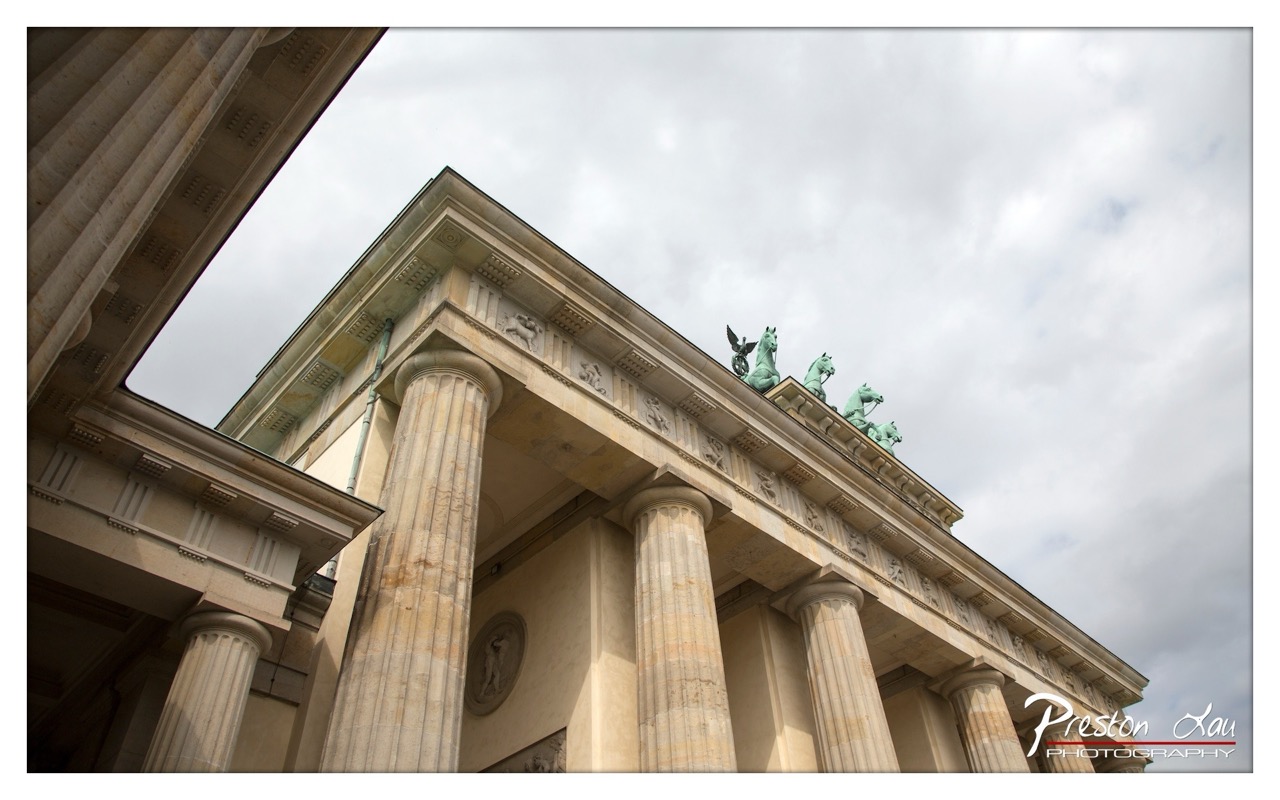

Brandenburg Gate Grandeur
Rating: 8/10
This shot gives us the worm's eye view of the iconic Brandenburg Gate, proving you sometimes have to get low to appreciate the high points of history. We're looking straight up at the majestic neoclassical structure, specifically the upper section featuring the famous Quadriga statues and the detailed frieze work. The mood is one of grand scale and enduring history, amplified by the dramatic perspective and the brooding, overcast sky overhead, which adds a touch of gravitas without completely muting the scene. The subject matter is instantly recognizable, an architectural and historical heavyweight that's always a compelling photographic subject.
Compositionally, this is a bold choice with the extreme low angle, using the architectural lines to guide the eye upwards. The structure on the left side provides a strong diagonal element, framing the main central section with its imposing Doric columns. The overcast lighting acts like a giant softbox, minimizing harsh shadows and allowing details in the stone and frieze carvings to remain visible, though it does make the scene feel a bit flat compared to golden hour. The muted stone colors and the distinctive green of the copper statues contrast nicely against the soft grey sky. It's a solid execution of a classic landmark shot, though the prominent watermark reminds us whose crick in the neck this impressive perspective caused.
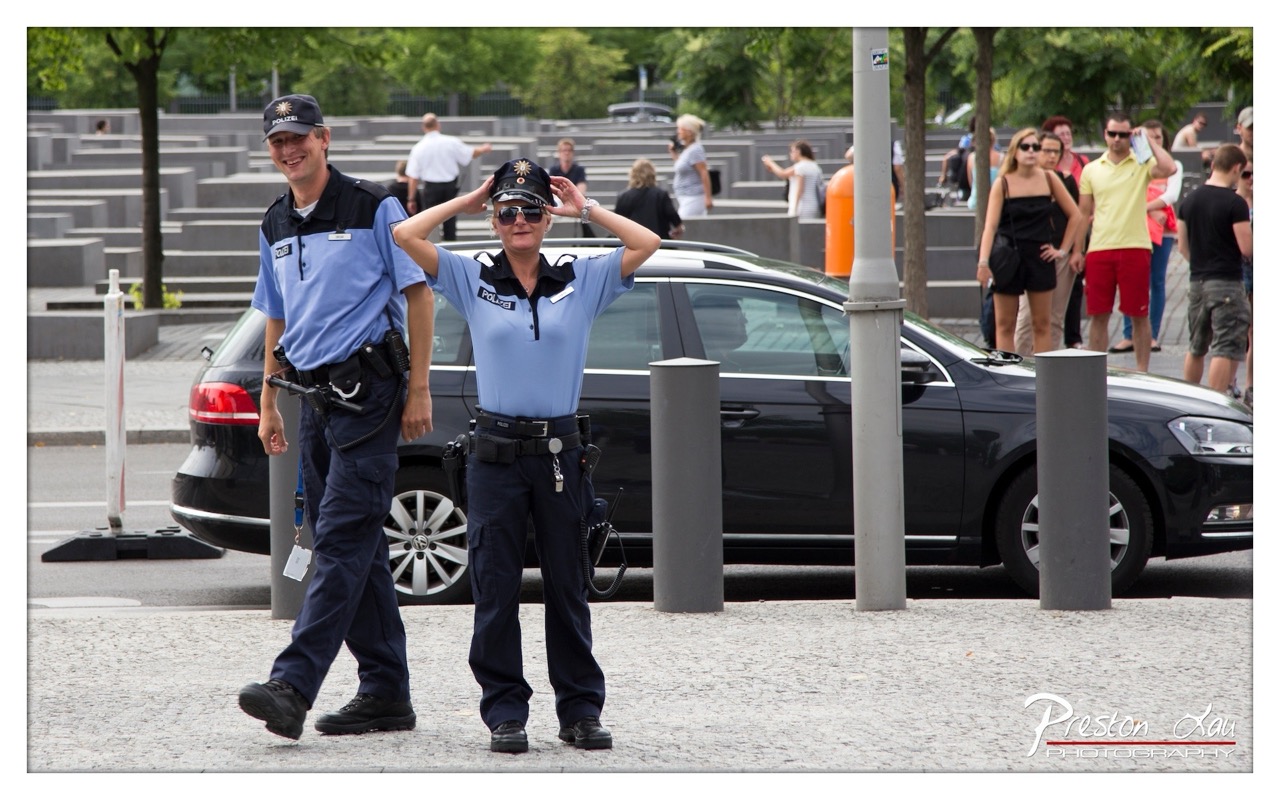

Germany's Friendliest Polizei
Rating: 8/10
Caught mid-pose on what appears to be a pleasant summer day, two German police officers offer a moment of unexpected levity. The officer on the left, sporting a broad, slightly goofy grin and standard-issue sunglasses perched on his cap, looks like he's genuinely enjoying the interaction with the photographer. Beside him, his colleague adjusts her hat with a determined look, perhaps ensuring her uniform is impeccable for her unexpected close-up, while her aviator sunglasses lend an air of cool professionalism (or maybe just shield her from the sun). The overall mood is surprisingly light and friendly, contrasting slightly with the typical stern image of law enforcement, and certainly with the somber background of the Memorial to the Murdered Jews of Europe visible behind them. Their standard blue uniforms and tactical gear are clearly visible, grounding the scene in reality, but their willingness to pose adds a personal touch.
From a photography perspective, this shot leans towards spontaneous street portraiture, capturing a candid-feeling moment despite the subjects being aware of the camera. The composition places the officers somewhat off-center, which isn't necessarily a bad thing, but the large, dark car parked directly behind them takes up a significant portion of the mid-ground, acting as a slightly distracting, albeit practical, backdrop (perhaps their patrol car?). The lighting is typical bright daylight, a bit flat but sufficient to illuminate the subjects clearly without harsh shadows. The color palette is dominated by the blues of the uniforms, the black of the car, and the muted greys and greens of the urban environment and background memorial stelae. There's a decent separation of the subjects from the slightly blurred background, though the car is quite sharp. The paving stones in the foreground add texture, and the poles on either side frame the scene somewhat awkwardly. Despite the slightly cluttered background and composition quirks, the engaging expressions of the officers make this a memorable capture, perfectly rounded off by a classic photographer's watermark in the bottom corner, just in case you forget who captured this moment of policing charm.
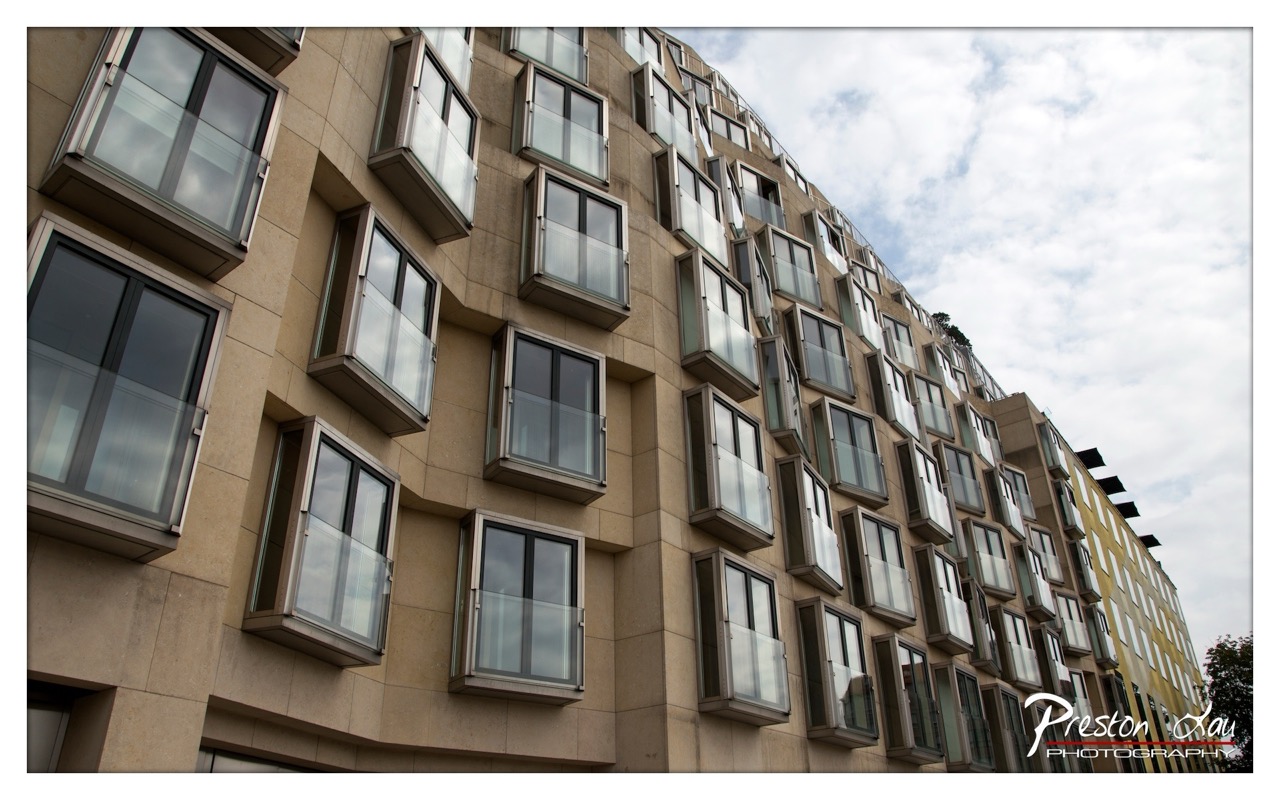

The Patterned Facade
Subject Rating: 8/10
Ah, behold the concrete jungle's attempt at giving every resident their own personal box! This image captures the intensely repetitive facade of a modern building, where window units seem to be stacked like slightly askew drawers in a giant, minimalist chest. What's happening here is essentially a celebration of architectural rhythm and repetition, viewed from a dramatic low angle that emphasizes the building's height and makes the protruding window-balconies seem like they're leaning out to say hello – or maybe just get a better look at the cloudy sky. The mood is one of structured order, perhaps verging on the overwhelming, set against a muted palette of beige concrete and grey-white clouds. It’s certainly not a building you’d lose your keys on the wrong floor in; just count the boxes!
From a photography perspective, this shot leans heavily into compositional elements. The low angle creates powerful leading lines that draw the eye up and along the building's side, exaggerating the perspective and giving it a slightly imposing presence. The lighting, thanks to the overcast sky, is wonderfully soft and diffused, which helps to evenly illuminate the facade and highlight the texture of the concrete and the reflections in the glass without harsh shadows. However, it does lend a somewhat flat look overall. The subject matter – geometric repetition – is handled well, creating a strong visual pattern. One might critique the slightly tilted horizon or the placement of the watermark, which, while unobtrusive in opacity, does sit over a key part of the building. Overall, it's a solid architectural study that captures the building's unique and perhaps dizzying design.
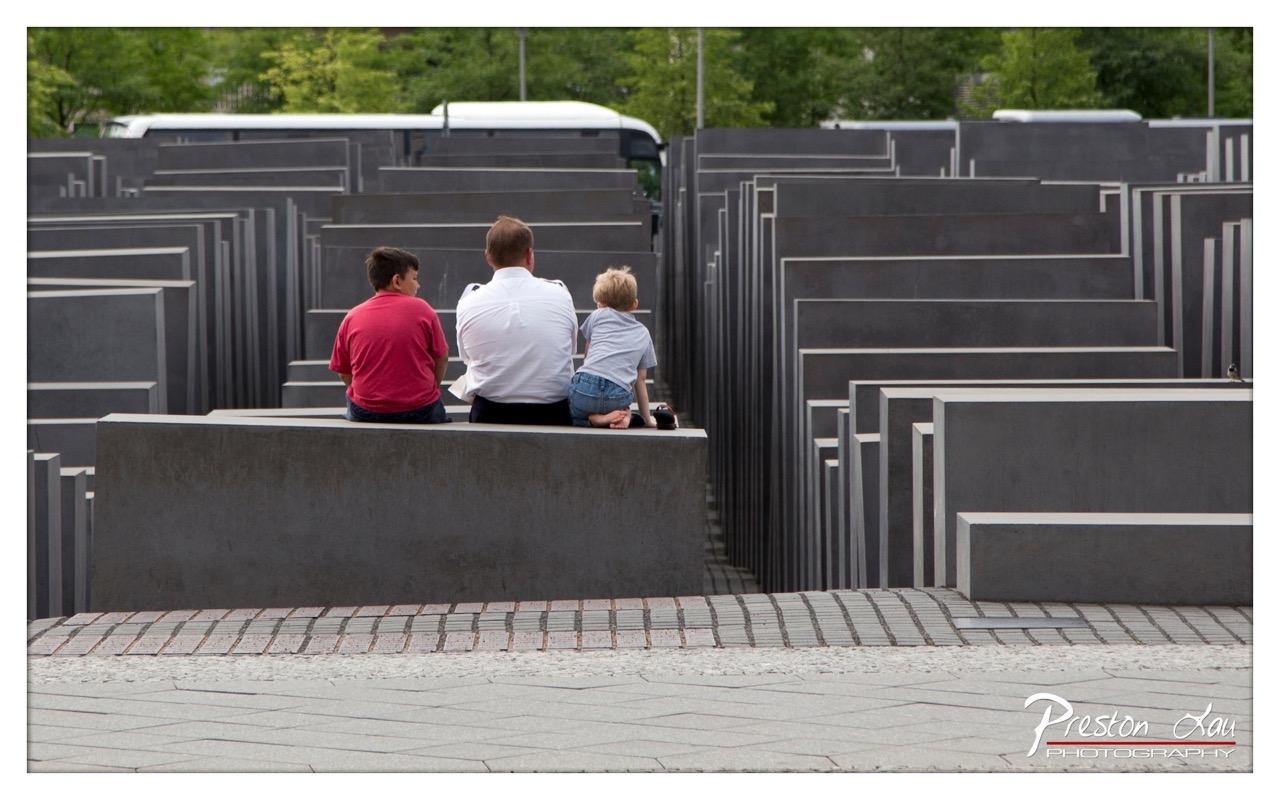

A Moment Among the Stelae
Subject: 8/10
This poignant image captures a quiet moment at the Memorial to the Murdered Jews of Europe in Berlin, where a man and two young boys sit facing the vast, undulating field of concrete stelae. Viewed from behind, their posture of contemplation speaks volumes against the stark, grey backdrop of the memorial blocks, which vary dramatically in height to create a disorienting yet powerful visual experience. The mood is undoubtedly solemn and reflective, emphasizing the human scale and perspective within this immense monument to memory and loss, while also suggesting a moment of pause and perhaps explanation from the adult figure.
From a photographic standpoint, the composition effectively uses the solid foreground concrete block to ground the subjects, contrasting their presence against the overwhelming geometry of the background. The repetitive vertical lines of the stelae provide a strong sense of depth and texture, leading the eye into the scene and highlighting the sheer scale of the installation. The color palette is deliberately muted, dominated by the somber greys of the concrete, which enhances the gravitas of the location, with the single vibrant red shirt offering a small focal point of life against the stone. Lighting appears soft and diffused, perfect for bringing out the subtle variations in texture and form of the concrete blocks without harsh shadows – a clever choice that maintains the desired serious tone, proving that sometimes, the best shots are simply about finding the right place and waiting for the perfect moment (or hoping the kids don't wander off too soon).
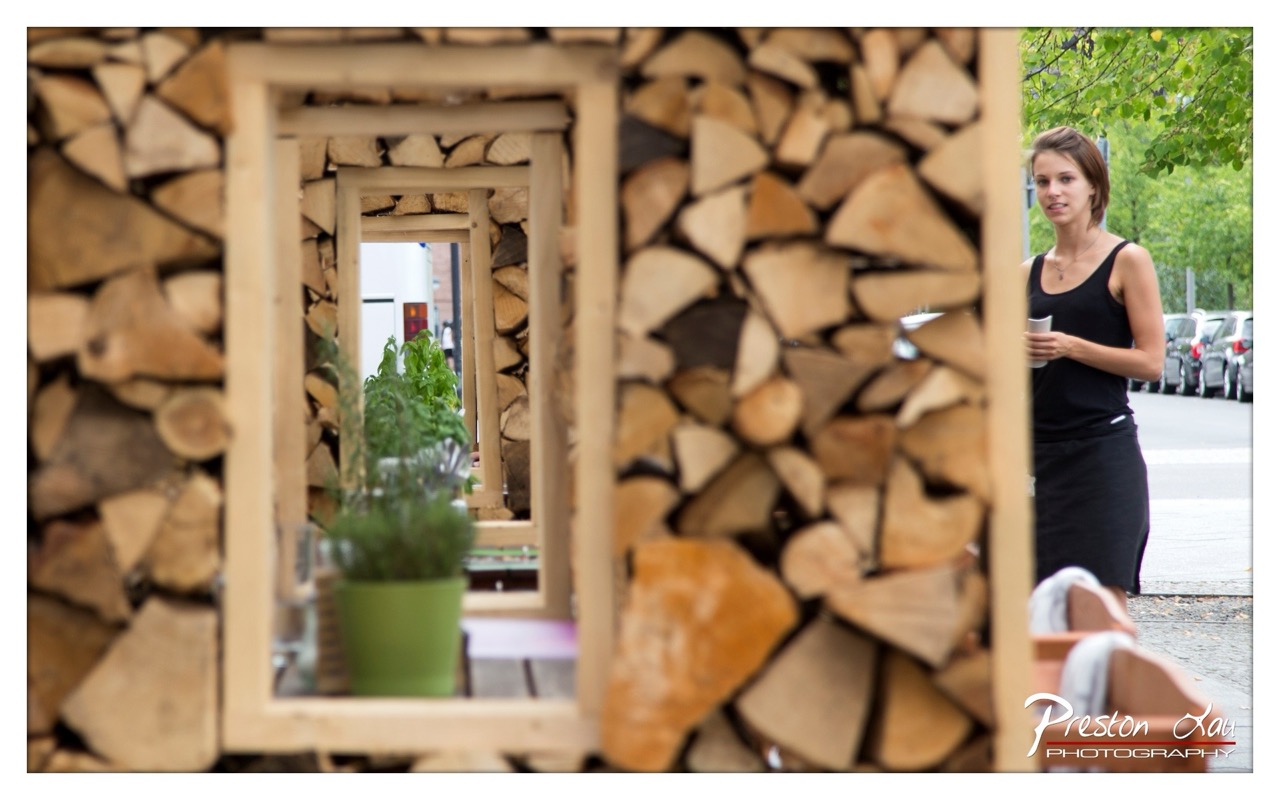

Framed by Firewood
Rating: 6/10
Well, isn't this a cozy scene? We have a young woman, looking rather thoughtful, positioned rather casually next to what appears to be a house built out of... well, firewood. But not just any firewood house, this one comes complete with mirrored windows offering tantalizing glimpses of the inside, revealing vibrant green plants that seem to be thriving despite the unusual architecture. The woman, dressed in a simple black tank top and skirt, holds something small in her hand, perhaps contemplating the ecological footprint of her lunch break or just checking her phone. The scene unfolds on a street, suggested by the line of parked cars in the bokeh-heavy background and the subtle hint of trees overhead. The overall mood feels a touch whimsical and certainly unique, like stumbled upon a pop-up installation where lumberjack meets interior designer.
From a photographic standpoint, the composition is certainly ambitious, attempting to use the quirky firewood structure as a dynamic foreground element and frame. The nested wooden frames and mirrored reflections create a layered effect that pulls the eye inward, offering multiple points of interest. The shallow depth of field effectively blurs both the foreground firewood and the background street, helping the eye focus on the planes of the structure and the subject. However, placing the main subject so far to the right and partially obscured by the foreground structure feels a tad awkward, almost as if the photographer wasn't quite sure if the structure or the woman was the star. The lighting is soft and natural, lending a gentle quality to the scene, and the color palette is dominated by earthy browns and greens, broken up by the woman's black attire. It’s a creative attempt to blend environmental portraiture with architectural interest, though the framing could perhaps have served the subject a little more effectively.
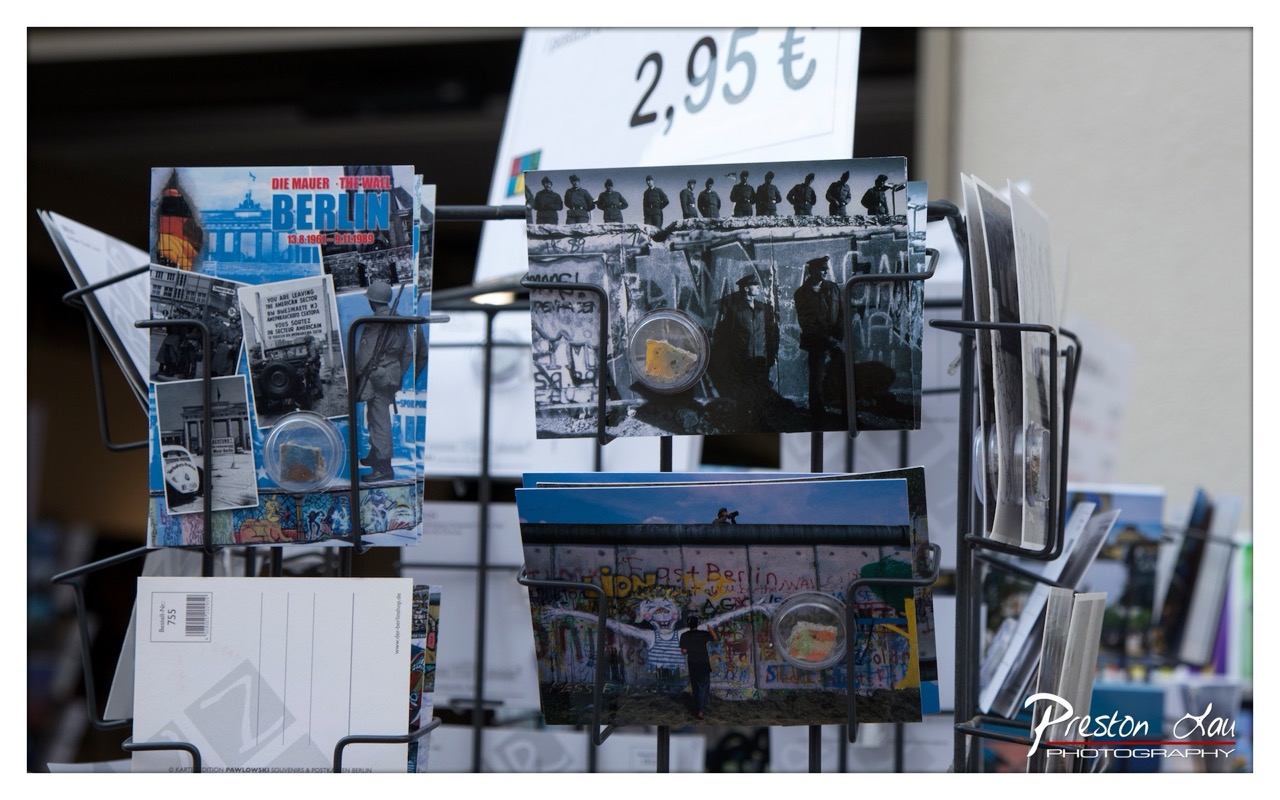

Pieces of the Past, Price Tag Included
Rating: 7/10
Step right up and get your very own piece of the Berlin Wall! This shot captures a display of postcards, each featuring historical images of the infamous wall and, in a stroke of entrepreneurial genius, containing a small, embedded chunk of the actual structure. They sit neatly arranged on wire racks, ready for purchase, with a prominent price tag of 2.95€ hovering above like a silent judge of historical commodification. The mood is distinctly touristy and perhaps a touch ironic, transforming a symbol of division into a tangible, albeit small, souvenir.
From a photographic standpoint, the composition cleverly uses a shallow depth of field to draw attention squarely to the postcards in the foreground, creating a layered effect with the wire racks. The lighting is soft, highlighting the textures on the postcards and the small, colorful fragments within the plastic bubbles. While the subject matter itself is inherently interesting (the transformation of history into commerce), the framing and detail capture this specific reality well. The subtle contrast between the historical black and white images on the cards and the splashes of color from the graffiti and embedded pieces adds visual interest. It's a focused, documentary-style detail shot, perfect for illustrating the specific nuances of the modern-day Berlin souvenir market.
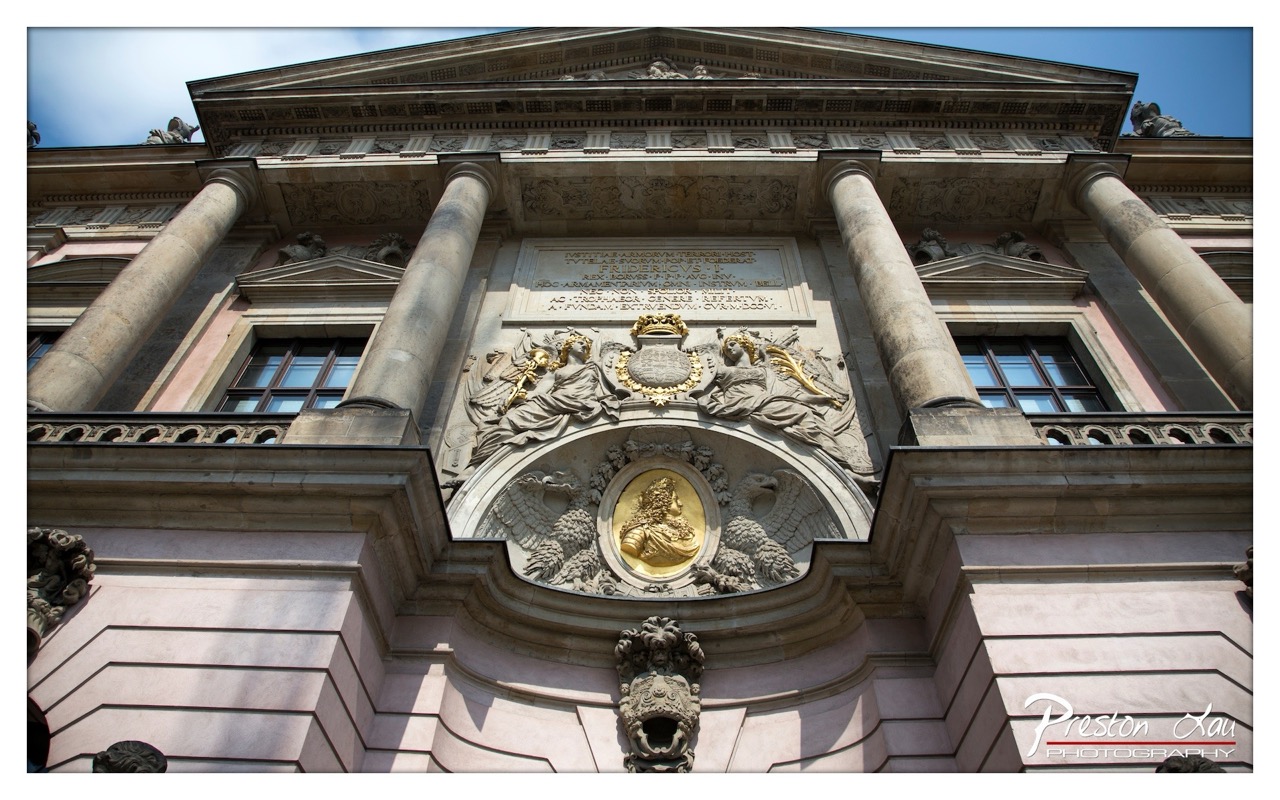

Facade of Grandeur
Rating: Subject: 8/10
Gazing up at this imposing historical facade is like getting a stern lecture from history itself. Nothing is really "happening" here in the action sense, unless you count the sun valiantly battling the shadows, but the sheer presence of this building commands attention. The mood is one of historical grandeur and perhaps a touch of being slightly intimidated by the scale and ornate detail. Prominent are the sturdy classical columns flanking windows, leading the eye up towards the richly decorated central section featuring intricate relief carvings of allegorical figures, a regal crest, and a striking golden portrait medallion. Below, a fierce lion head carving adds a touch of ancient power, standing guard over centuries of stories.
From a photographic perspective, the low-angle composition effectively emphasizes the building's height and dominance, making you feel small in its presence – a classic technique for architectural awe, though one wonders if the photographer was flat on their back to get this shot. The strong sunlight, while perhaps a tad harsh and creating deep shadows under the cornices, does a fantastic job of making those golden elements pop with a regal shimmer. The muted stone colors provide a solid, dignified foundation for the golden accents. The style is clearly aiming for a dramatic capture of architectural heritage, focusing on the central decorative elements. A minor critique: the watermark, while understandable, does detract from the bottom right corner. Overall, a strong attempt to capture the majestic details of this historical structure, even if the lighting didn't cooperate perfectly to reveal all the intricate stone carving details.
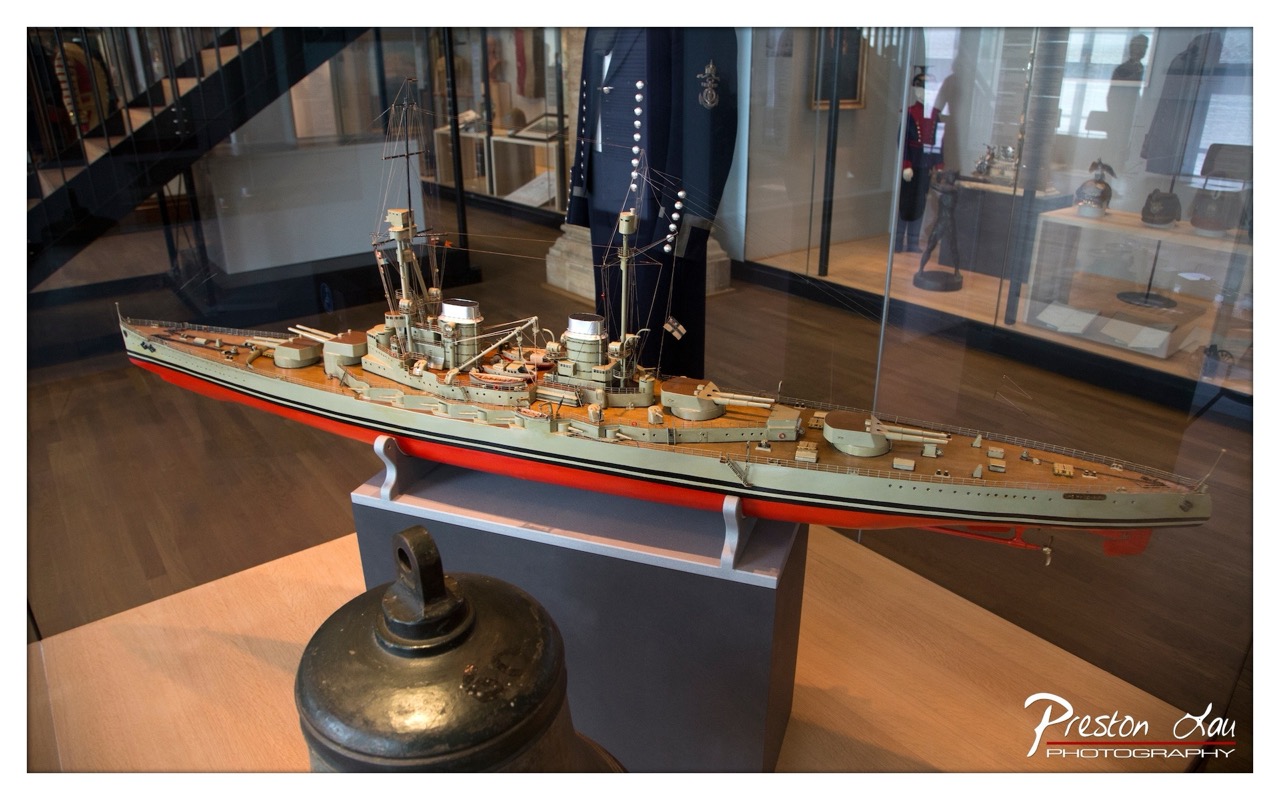

Title: Dreadnought Display in a Hall of History
Rating: 9/10
Behold, a magnificently detailed model battleship, proudly sitting on its stand as the undisputed centerpiece of this historical tableau. Rated a solid 9 out of 10 for its intricate craftsmanship, this miniature leviathan dominates the frame, pulling the viewer's eye with its sharp lines and striking red hull. The scene unfolds within what appears to be a museum or exhibition hall, a place where history is carefully curated and presented. The mood is one of quiet reverence and historical intrigue, inviting contemplation about naval power and past eras. Compositionally, the model is well-placed, angled to showcase its impressive length and features. However, the inclusion of a mysterious, darkly lit object (is that an antique kettlebell?) in the foreground, slightly out of focus, adds an unexpected and somewhat perplexing layer to the image, providing depth but also a slight visual puzzle.
The lighting, typical of an indoor exhibit, illuminates the model effectively, highlighting the detailed deck and turrets, while simultaneously creating challenging reflections on the surrounding glass display cases. These reflections transform the background into a ghostly collage of mannequins in historical uniforms, blurry artifacts, and architectural details like a staircase, a common and often frustrating hurdle for museum photographers. The color palette is dominated by the battleship's grey and red, contrasted with the warm wood tones of the display table and the muted hues of the background exhibits. This blend of prominent subject and softly rendered surroundings, captured perhaps with a wide aperture to isolate the model, creates a visually appealing yet slightly haunting effect, perfectly encapsulating the experience of exploring a museum filled with silent echoes of the past. And look, is that mannequin giving the ship model a disapproving glare? Maybe it remembers something it shouldn't.
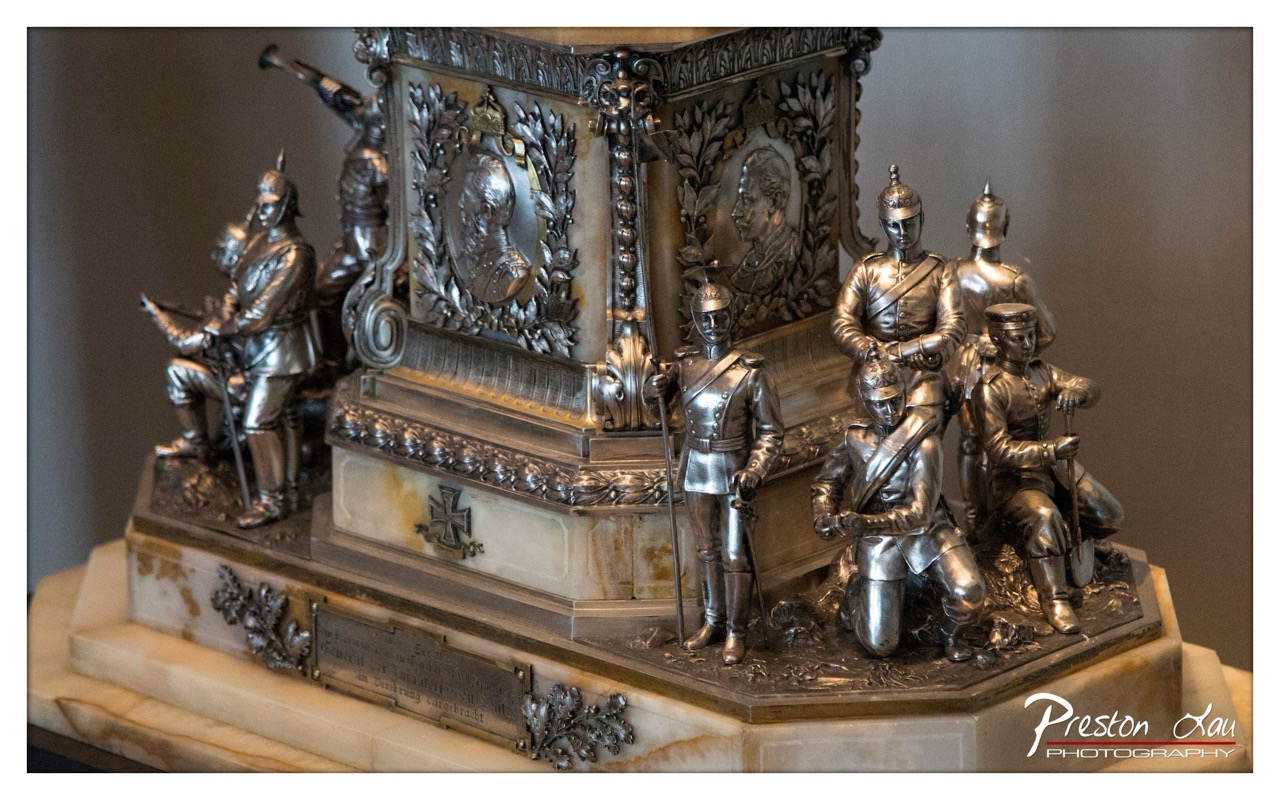

Subject Rating: 8/10
This image presents a rather impressive, albeit slightly overwhelming, silver military monument or trophy, likely from a bygone era where metal polishing was clearly a competitive sport. The subject, a towering structure adorned with miniature silver soldiers in various dramatic, if somewhat stiff, poses – including kneeling, standing stoically, and brandishing tiny weaponry (or is that a shovel?) – commands attention. The mood is decidedly historical and formal, perhaps even a touch melancholic, capturing a static moment of commemoration. The central column features detailed relief portraits, seemingly of distinguished individuals, surrounded by intricate metallic foliage and classic ornamentation. It’s a piece so dense with detail you could get lost counting the individual buttons on the soldiers' jackets or the leaves in the wreaths. This monument doesn't just stand there; it *announces* its historical significance with every polished surface and tiny, determined silver face.
From a photographic standpoint, the image does a commendable job of wrestling with a challenging subject – shiny, highly detailed metal and marble. The composition is centered enough to show the monument's scale and complexity, yet slightly offset to add a bit of dynamic interest to what is essentially a static object. The lighting, likely ambient with some directional source, creates strong highlights on the silver, emphasizing its texture and form, though some areas push the boundaries of specular highlights (a common battle when photographing polished metal). The creamy marble base provides a nice contrast in material and color, grounded by the darker, out-of-focus background which thankfully doesn't compete with the already busy subject. The focus is sharp where it needs to be, capturing the intricate details of the figurines and reliefs, which is crucial for a piece like this. Overall, it's a solid, informative shot that documents the subject effectively, proving that sometimes, even the most rigid silver soldiers deserve their moment in the photographic spotlight.
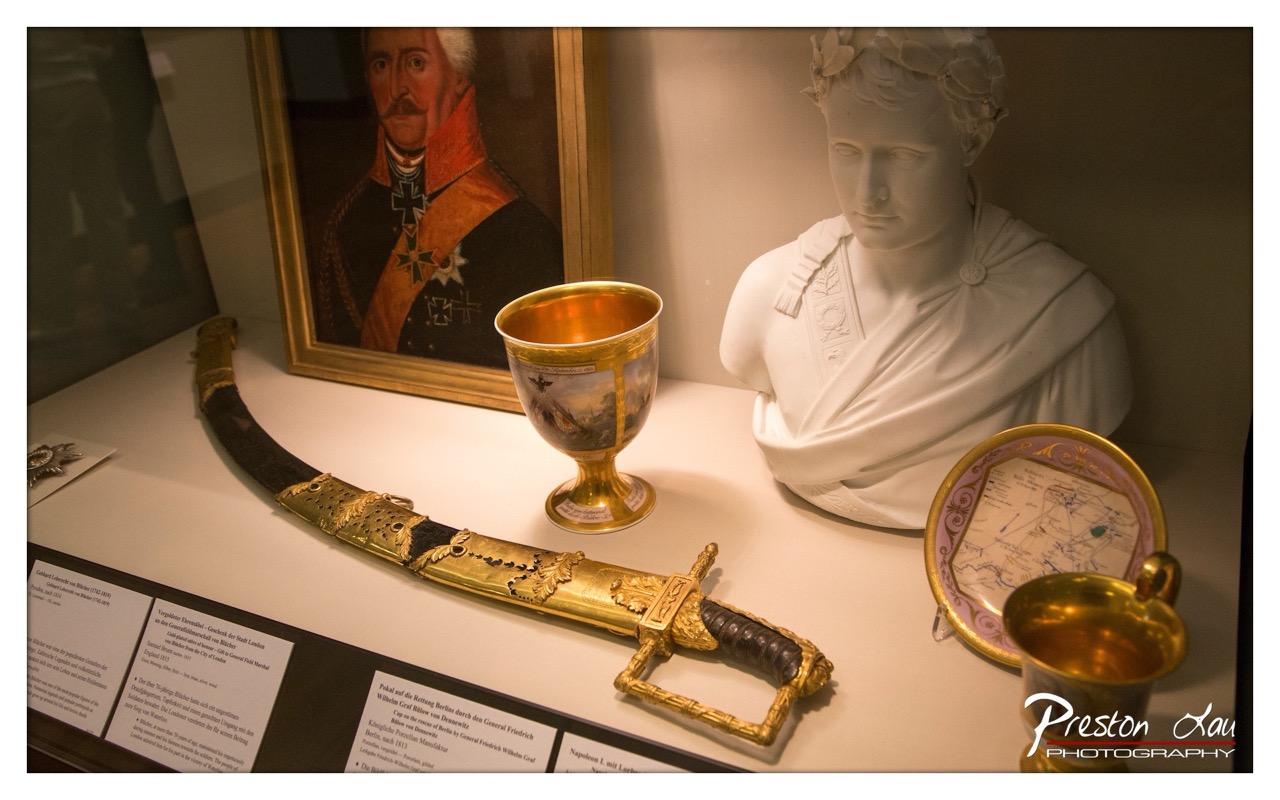

Museum Menagerie: A Historical Huddle
Rating: 6/10
Step right up to this rather crowded historical tableau! What we have here is an eclectic gathering of museum artifacts, all vying for attention under warm, somewhat dusty spotlights. Front and center, a magnificent gold-hilted saber curves across the display, looking far too ready for action considering its age. Beside it stands a fancy gold goblet adorned with a scenic painting, perhaps holding the victory bubbly. In the background, a stern-faced gentleman in a portrait glares from his frame, overseeing the collection, while a classical bust (possibly Napoleon, giving us his best stoic gaze) stands silently to the right. A small, rather charming plate with a map sits near the bust, adding a touch of geographical intrigue to this historical get-together. The mood is one of static importance, a frozen moment from the past presented for modern contemplation, albeit in a slightly jumbled fashion.
From a photographic perspective, this shot faces the classic museum display challenge – making inanimate objects pop without disturbing them. The composition attempts to fit a lot in, resulting in a slightly cluttered scene where the eye isn't entirely sure where to land first. The sword provides a strong leading line, but it leads off-frame. The lighting is standard overhead museum fare, creating nice highlights on the gold but lacking significant depth or drama. The depth of field is relatively shallow, which successfully separates the foreground objects but leaves the bust in the background slightly out of focus – Napoleon looks a bit fuzzy around the edges, which is perhaps historically inaccurate. The framing feels a bit tight, cutting off some elements on the left and right. Overall, it's a competent documentation shot, capturing the objects as they are, but it doesn't quite elevate the presentation into a truly engaging visual story. And yes, the prominent watermark adds another, decidedly modern, layer to this historical display.
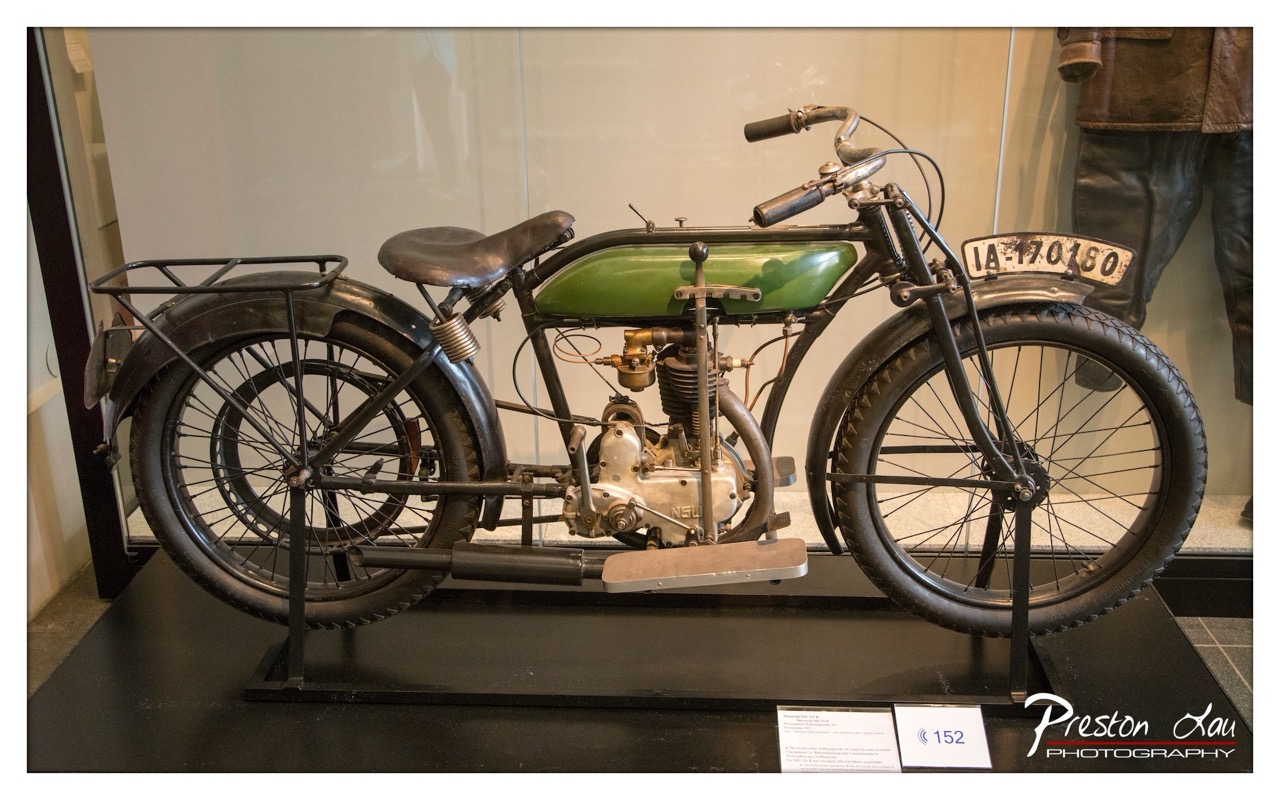

Vintage Two-Wheeled Time Machine
Rating: 8/10
Well, hello there, gorgeous! Here we have a stunning profile shot of what appears to be a rather well-preserved, albeit undeniably vintage, motorcycle. It's posed heroically on a display stand in what looks like a museum or exhibition setting. The bike itself is the undisputed star, filling the frame with its delightful anachronisms: a shiny green fuel tank (the only splash of vibrant color), spindly spoked wheels, a seemingly minimalist engine that probably ran on hopes and dreams, a sprung saddle that looks... well, rustic, and a peculiar luggage rack on the back. You can almost hear it whispering tales of open roads before paved roads were even a consistent thing. It sits stoically, just *being* an old motorcycle, patiently waiting for someone to admire its historical swagger. The overall mood is one of quiet reverence for a bygone era of transportation.
From a photographic standpoint, the composition is straightforward and effective – a classic side-on view that maximizes detail of the subject. The lighting seems to be typical indoor/museum illumination, reasonably even but perhaps a tad flat, which highlights the bike's form but doesn't add much dramatic flair. The muted background of a beige wall helps the dark metal and green tank stand out nicely, although the reflection adds a slight distraction. The contrast between the smooth tank and the intricate mechanics is visually interesting. The photographer, Preston Lau (whose watermark boldly graces the lower right), captured the essence of the machine, though maybe a slight angle or more directional light could have brought out the textures even more. Still, it's a solid capture for documentation, complete with the exhibit label and number 152 – proving this old beast has earned its place in history. And bless its heart, it even has a license plate!
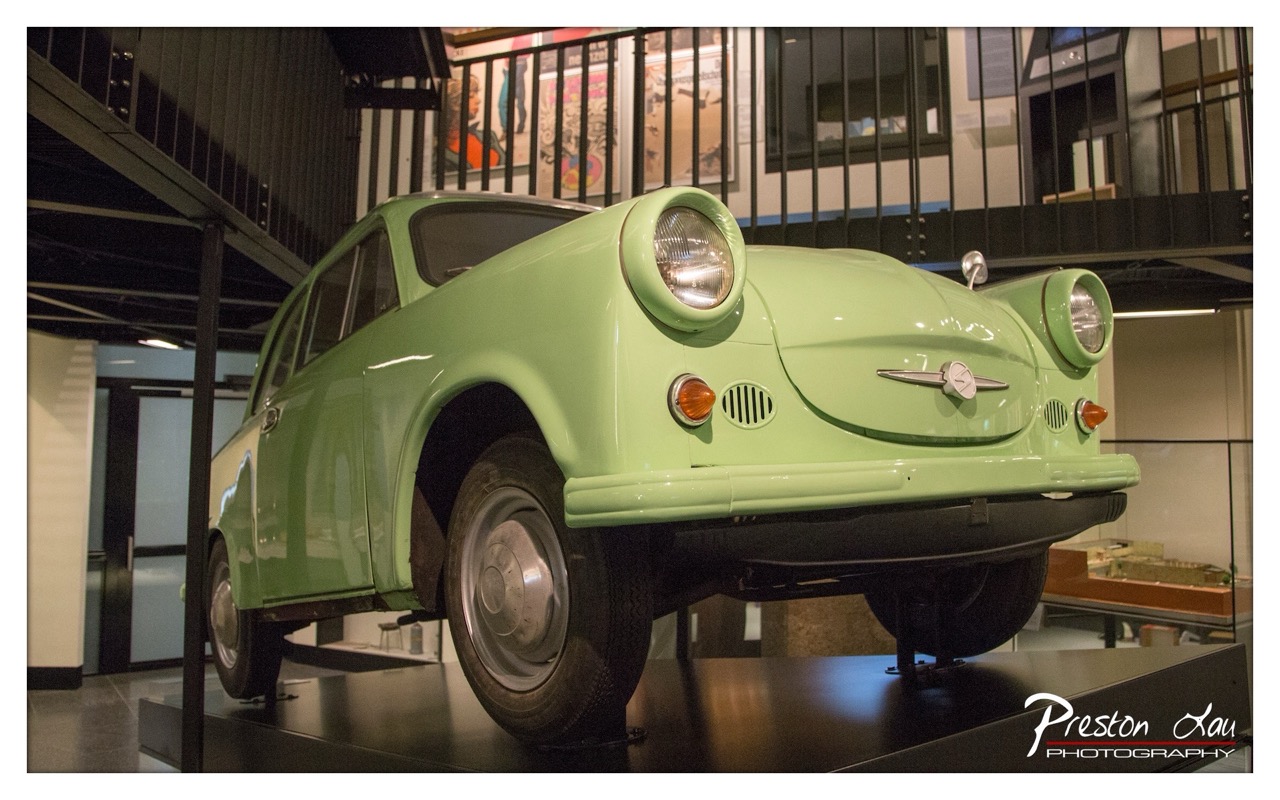

A truly charming subject, this light green automobile, which strongly resembles a classic Trabant, is presented like a star on a black elevated stage. It looks like it just rolled out of a time machine, sporting its simple, rounded lines, prominent circular headlights like wide-open eyes, and a rather hopeful, if slightly bewildered, expression (yes, cars have expressions, don't argue). Elevated above ground level, it's clear this little engine that could (or maybe just did) is on display, likely in a museum or exhibition dedicated to classic cars or perhaps a specific historical period. The mood is one of nostalgic reverence mixed with a touch of quirkiness, celebrating the humble design of a vehicle built for necessity rather than extravagance. Subject Rating: 7/10 - Points for historical charm, but it's no supercar.
From a photographic standpoint, the composition centers the car effectively, with the elevation providing a clean separation from the floor and foreground elements, although the platform itself dominates the bottom third a bit heavily. The lighting is typical of a museum exhibit, using spotlights to make the subject pop against a darker, less distracting background. This creates nice highlights on the car's polished surface, but also makes the darker areas quite deep. The color palette is dominated by the car's distinctive pastel green, contrasted with the stark black of the display structure and the muted tones of the background exhibits. The photographer did a good job of capturing the car head-on at an appealing angle, though shooting elevated subjects can sometimes make the base feel overwhelming, as seen here. The background, showing railings and display cases, clearly places the car in a curated environment, adding context while keeping the focus on the vehicle. The presence of the photographer's watermark is a clear indicator this is intended as a portfolio or promotional shot. Capturing reflections in a glossy car in a spotlighted environment is always tricky, and the photographer managed this reasonably well.
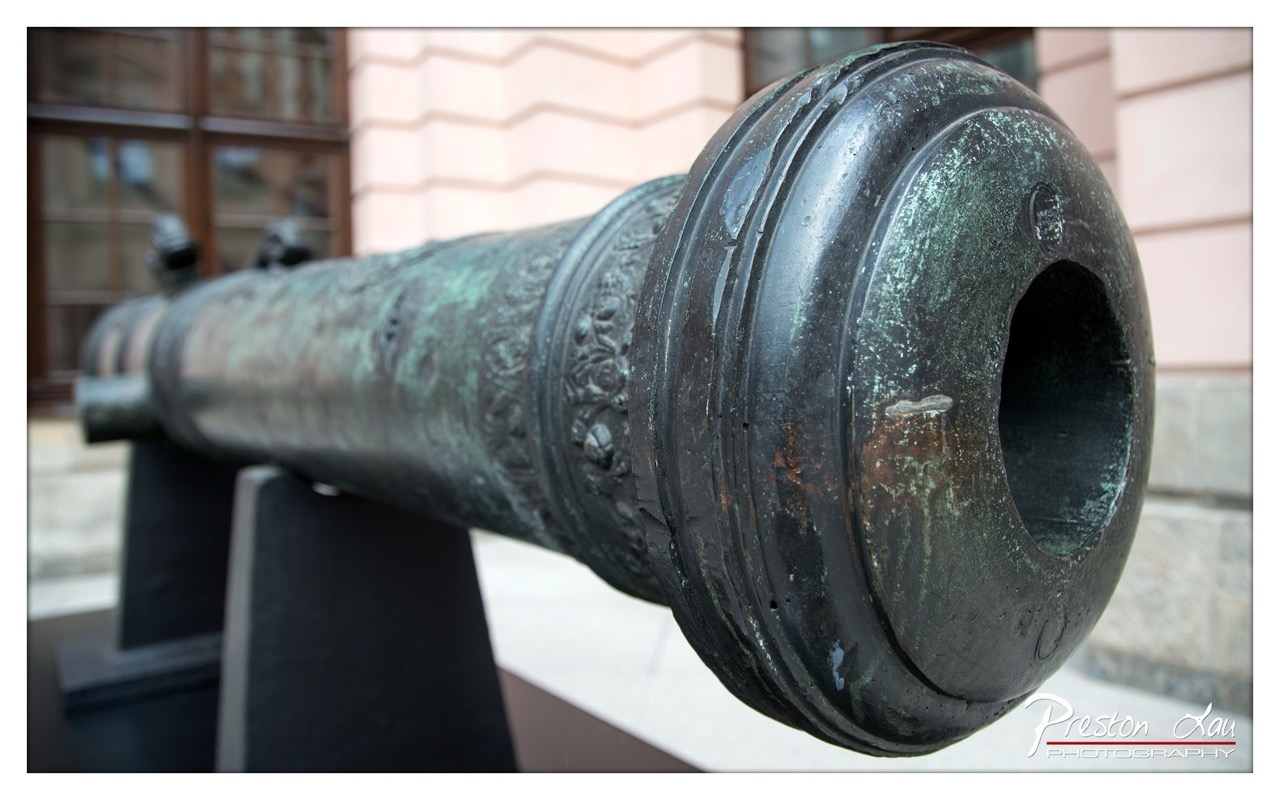

The Venerable Boom Tube
Rating: Subject: 7/10 (A weighty piece of history, but not exactly dynamic)
Behold, the Venerable Boom Tube! This image captures the imposing muzzle of a rather substantial, ancient bronze cannon, resting quietly on modern black supports. It's not exactly 'happening' here; more like 'standing impressively still and looking like it could tell some stories if only bronze could speak.' The mood is one of historical gravitas, perhaps a touch melancholic for its glory days, set against the blurred backdrop of a building that hints at its display location. Compositionally, the photographer has used a low angle and a strong diagonal line from the barrel to the heavily detailed muzzle in the foreground, drawing the viewer's eye along the length of the weapon. The shallow depth of field is a great touch, really isolating the intricate details and the fascinating patina of the cannon's surface.
From a photography perspective, the natural lighting is soft, bringing out the wonderful textural details and the rich, aged color of the metal, a blend of dark bronze and green verdigris. The color palette is earthy and muted, fitting for a historical artifact. While the focus on the barrel is sharp, the background is rendered as a pleasant wash of warm architectural tones, suggesting but not defining the environment. It's a classic approach to artifact photography – make the subject pop! Though, one might humorously note that those slick modern mounts look a bit out of place beneath such a distinguished old weapon, like a knight wearing sneakers. Still, it's a well-executed shot that makes this relic of war look rather magnificent, albeit permanently retired.
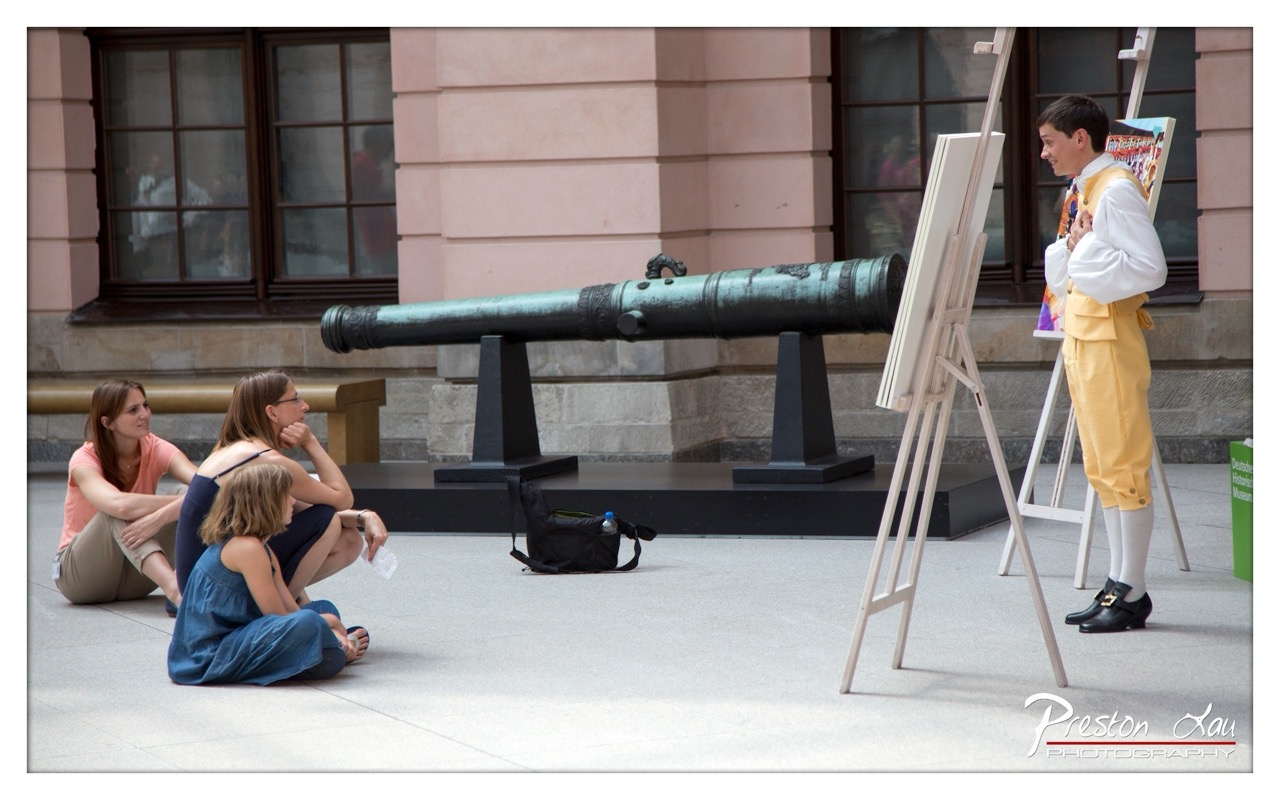

History Lesson, Floor Level
Subject Rating: 7/10
Step right up and behold the magnificent...cannon! Oh, and also this gentleman in a fetching canary-yellow ensemble, who seems intent on explaining the finer points of either art or warfare to a rather grounded audience. Perched comfortably on the pavement, three spectators – a woman looking thoughtful, another looking engaged, and a young person absorbed – listen attentively (or perhaps just enjoying a sit-down) near a formidable bronze cannon resting on sleek black stands. This appears to be a historical demonstration or performance outside a grand, peachy-hued building, complete with easels suggesting an artistic or educational angle. It's a fascinating tableau of public engagement, where the main historical artifact happens to be more visually imposing than the lively presenter trying to steal the show from the big gun.
From a photographic perspective, the composition here is quite strong, using the massive cannon as a powerful horizontal anchor that divides the scene while also connecting the subjects. The vertical elements of the easels and the standing performer on the right cleverly balance the seated group on the left, creating a nice visual equilibrium. The natural light is soft, lending a gentle quality to the scene, though the building facade shows some unevenness. The vibrant yellow of the performer's costume acts as a delightful pop of color against the otherwise muted tones of the stone and bronze, effectively drawing the eye. It's a candid, slice-of-life shot capturing a moment of public education or entertainment, framed nicely to include context and demonstrate the scale of the historical objects present. The style is documentary, capturing a fleeting public interaction.
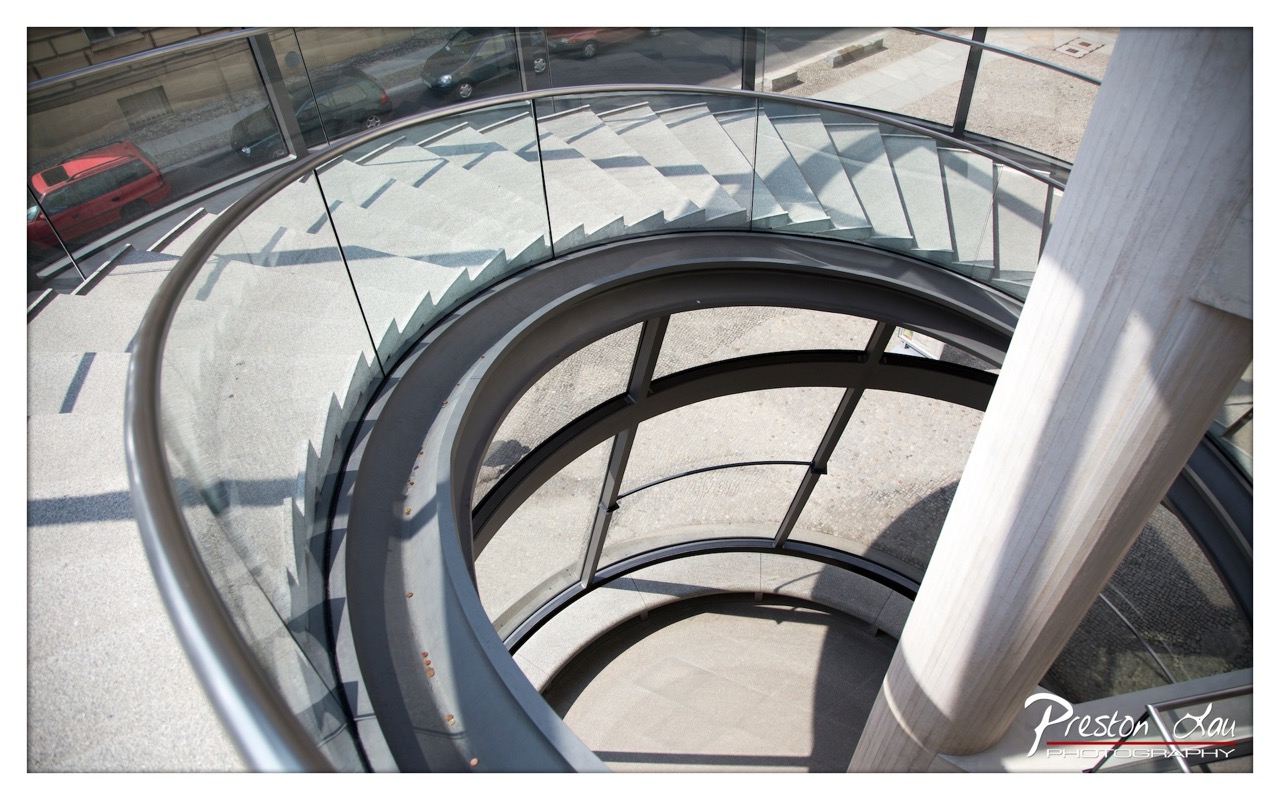

The Modern Helix
Rating: 8/10
Okay, hold onto your hats – or just the railing, preferably – as we take a tumble down this rather striking spiral staircase. Given its blend of form and function, we'll rate this architectural marvel a solid 8 out of 10 for subject interest and photographic appeal. What we're witnessing isn't just a pathway; it's a swirling vortex of modern design, featuring concrete steps wrapped in a sleek cage of glass and metal. Shot from a dizzying top-down perspective, the composition emphasizes the perfect curve of the structure, creating a dynamic, almost hypnotic visual flow. The mood is undeniably modern and clean, though the sheer drop might induce a slight flutter in the stomach of anyone prone to vertigo.
From a technical standpoint, the photographer has expertly captured the graphic potential of this scene. The strong, direct sunlight isn't shied away from but embraced, creating dramatic, angular shadows from the steps that add a bold pattern to the floor below. These high-contrast shadows are key to defining the form and texture of the staircase. The color palette is dominated by cool greys of concrete and metal, offset slightly by the warmth of the polished column and the faint reflections of red and green cars from the world outside, seen through the transparent glass walls. The strategic inclusion of the vertical column on the right side serves as a necessary anchor point, preventing the spiraling lines from completely disorienting the viewer. It's a great example of how architectural elements, even mundane ones like stairs, can become captivating subjects when viewed from an interesting angle and bathed in dramatic light.
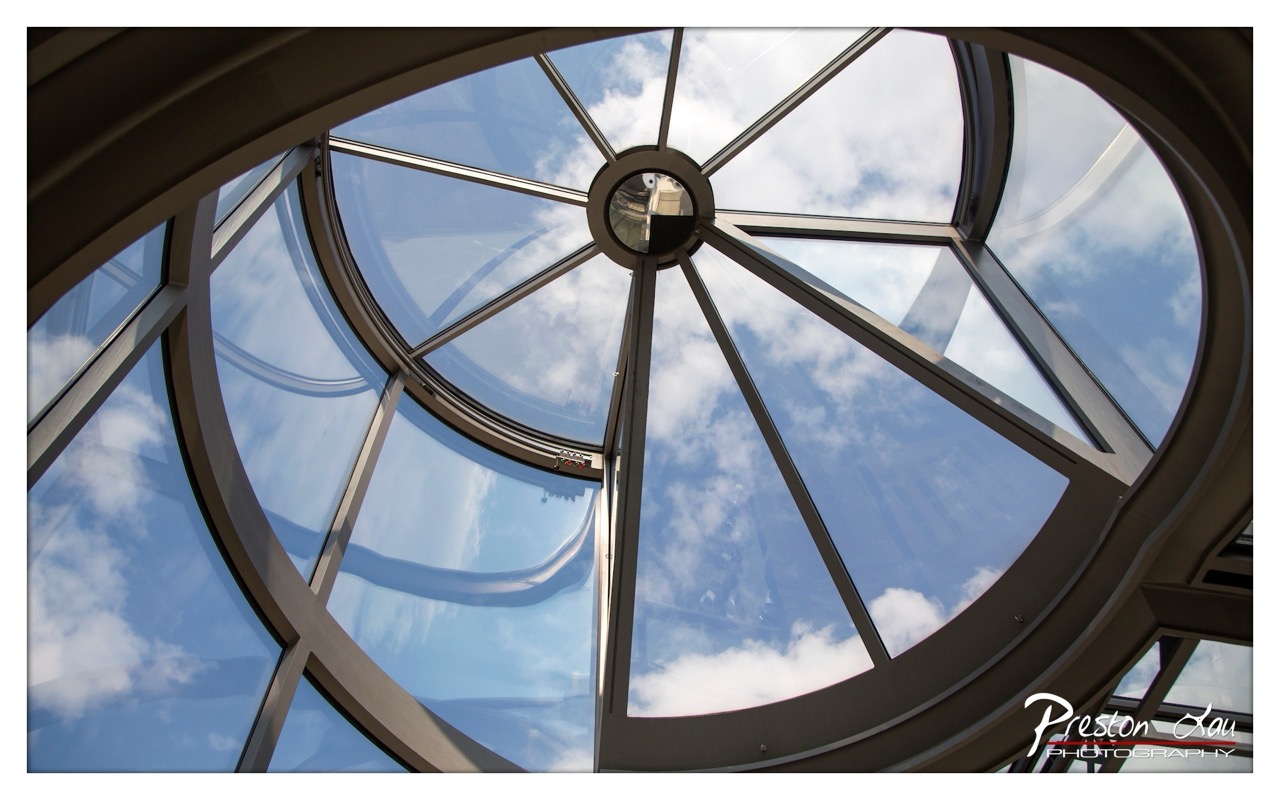

The Eye in the Sky(light)
Subject Rating: 7/10
This shot, capturing a circular glass skylight from a direct upward angle, gives a unique perspective on a common architectural feature. The subject itself, a geometric structure framing a view of the sky, is interesting enough to merit a 7/10 – it's not a world wonder, but it offers a visually engaging pattern. What's happening is simple yet effective: the camera is pointed straight up through the skylight, showcasing the blue sky and scattered white clouds above. The mood is bright and expansive, offering a sense of connection to the outside world even when indoors. The composition utilizes the strong circular shape and the radial lines of the frame to draw the eye into the center and then outwards towards the sky, creating a dynamic, almost dizzying effect that plays with perspective. Reflections on the glass add another layer of visual information, subtly hinting at the internal environment from which the photo is taken.
The lighting is entirely natural, with sunlight streaming through the glass, creating bright, well-lit panels and defined shadows from the metal frame. The colors are primarily the vibrant blue of the sky, the soft white of the clouds, and the cool, neutral grey/silver of the metal structure, creating a clean and striking palette. This image falls under the umbrella of architectural photography, specifically focusing on interior details and how they interact with the external environment. It's a great example of how simple geometric forms and natural elements like sky and light can create a compelling abstract image. The pertinent objects are the metal frame, the glass panels (complete with reflections), and the central hub where the spokes meet. The background is, quite literally, the sky itself, dotted with picturesque clouds, framed by the structure. It reminds us that even in built environments, nature provides the ultimate backdrop, sometimes viewed through surprisingly complex lenses.
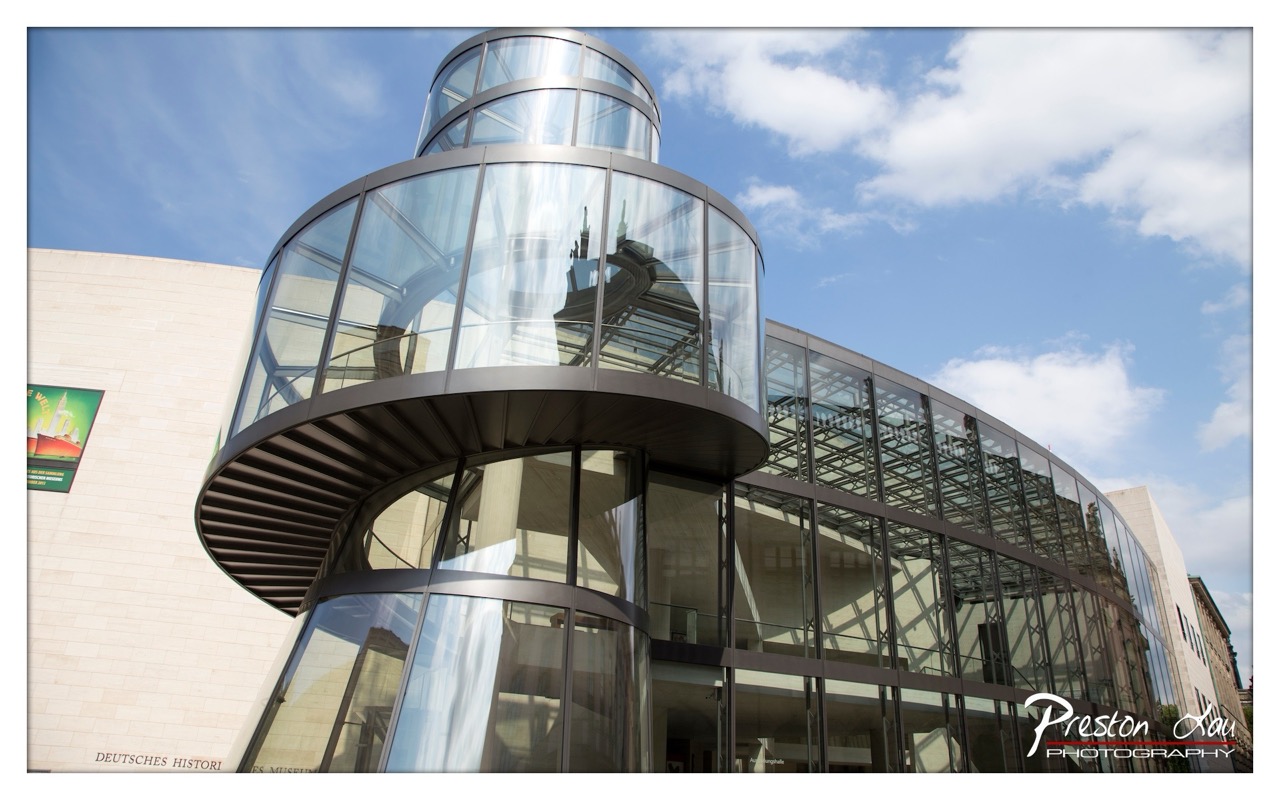

Modern Twist on History
Rating: 8/10
This shot captures the striking modern architecture of what appears to be an extension to the Deutsches Historisches Museum in Berlin, a subject that scores high on the "visually interesting building" scale. The mood is bright and dynamic, thanks to the clear blue sky dotted with puffy white clouds which obligingly posed as a perfect backdrop. The main subject is the curved glass and metal structure, featuring a prominent spiral staircase element encased in glass, giving it a look somewhere between a futuristic observation deck and a very fancy helter-skelter you probably shouldn't slide down. The glass reflects the sky and clouds beautifully, creating complex patterns that distort the reality of what's inside, much like trying to remember historical facts after a few beers. The older, more stoic building to the left provides a nice architectural counterpoint, highlighting the dramatic difference in design styles.
From a photographic perspective, this is a great example of handling challenging glass architecture. The composition uses the sweeping curves of the building to lead the eye through the frame, giving the image a sense of movement despite being static. The diagonal orientation adds to this dynamism. The lighting is bright, typical of a sunny day, which is great for showing off the structure but also means dealing with those inevitable, potentially distracting reflections – though here they mostly add to the visual complexity rather than detracting. The limited colour palette of blues, greys, and beige keeps the focus squarely on the architectural form. It's a solid shot of a fascinating building; capturing glass and reflections without getting your own reflection holding a camera is always a win in our book!
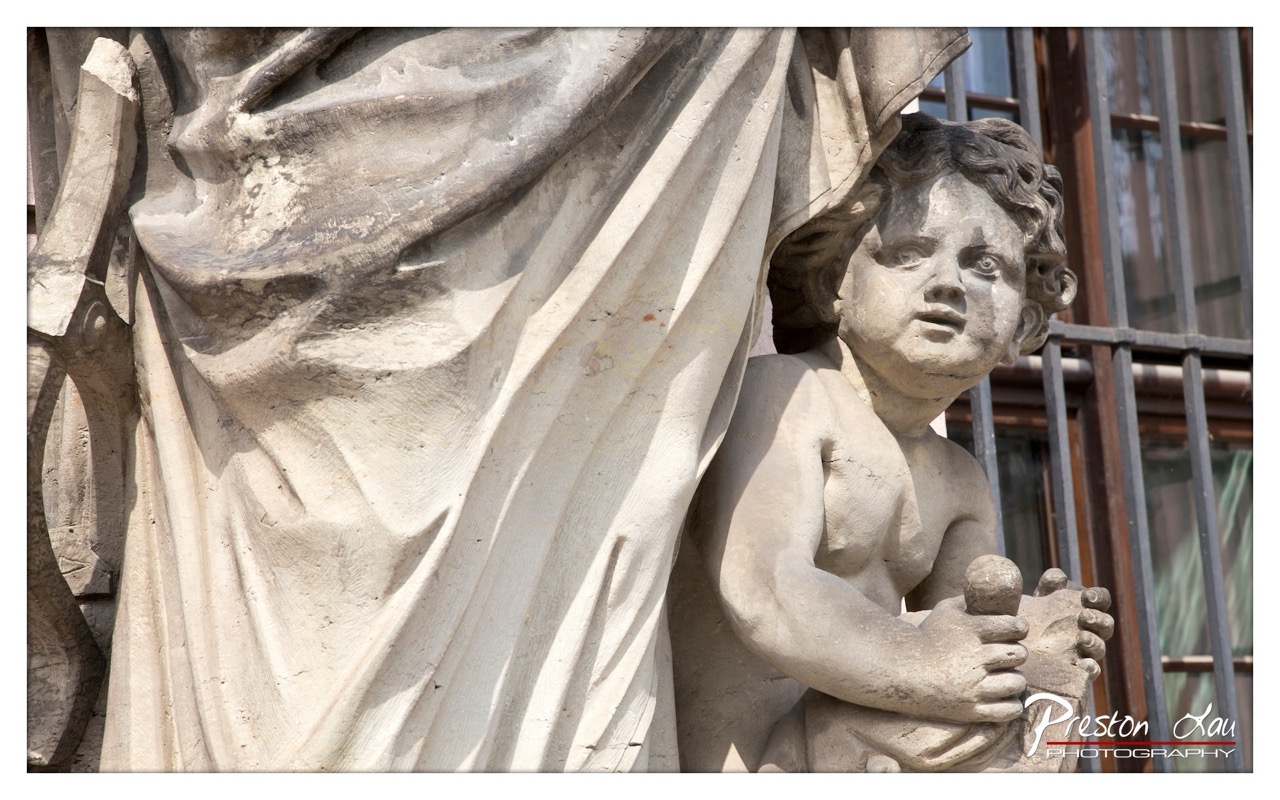

Ancient Gaze, Stone Child
Subject Rating: 7/10
Behold, a tiny stone tot, peering out from behind the voluminous, equally stone drapery of a much larger (and presumably more important) figure. Our little cherub, or putto, or perhaps just a very young saint sculpted mid-thought, clutches a mysterious round object in its hands, looking off-camera with an expression that suggests it's just remembered it left the oven on centuries ago. The heavy folds of the stone cloak on the left provide a dramatic frame, emphasizing the child's vulnerable, exposed form. Behind this stony tableau, a window with foreboding vertical bars offers a glimpse of a blurry world beyond, adding a touch of urban reality to the timeless nature of the sculpture. The mood is one of quiet endurance, tempered by the child's oddly expressive, slightly bewildered face.
From a photographer's perspective, this shot nails the texture – that harsh side light is doing wonders, highlighting every crack, chip, and the gritty surface of the weathered stone. It's almost *too* good at showing the wear and tear, making the child look like it needs a good scrub... or maybe just a hug. The composition is tight, focusing squarely on the child and the defining drapery, effectively using the larger mass to frame the smaller subject. While the background window adds context, its busyness slightly pulls focus from the main subject. However, the photographer has clearly aimed for a detailed study of form and texture under strong directional light, sacrificing a softer look for maximum detail pop. It's a classic architectural detail shot, perhaps a bit unforgiving in its clarity, but undeniably effective at documenting the subject's current, time-worn state.
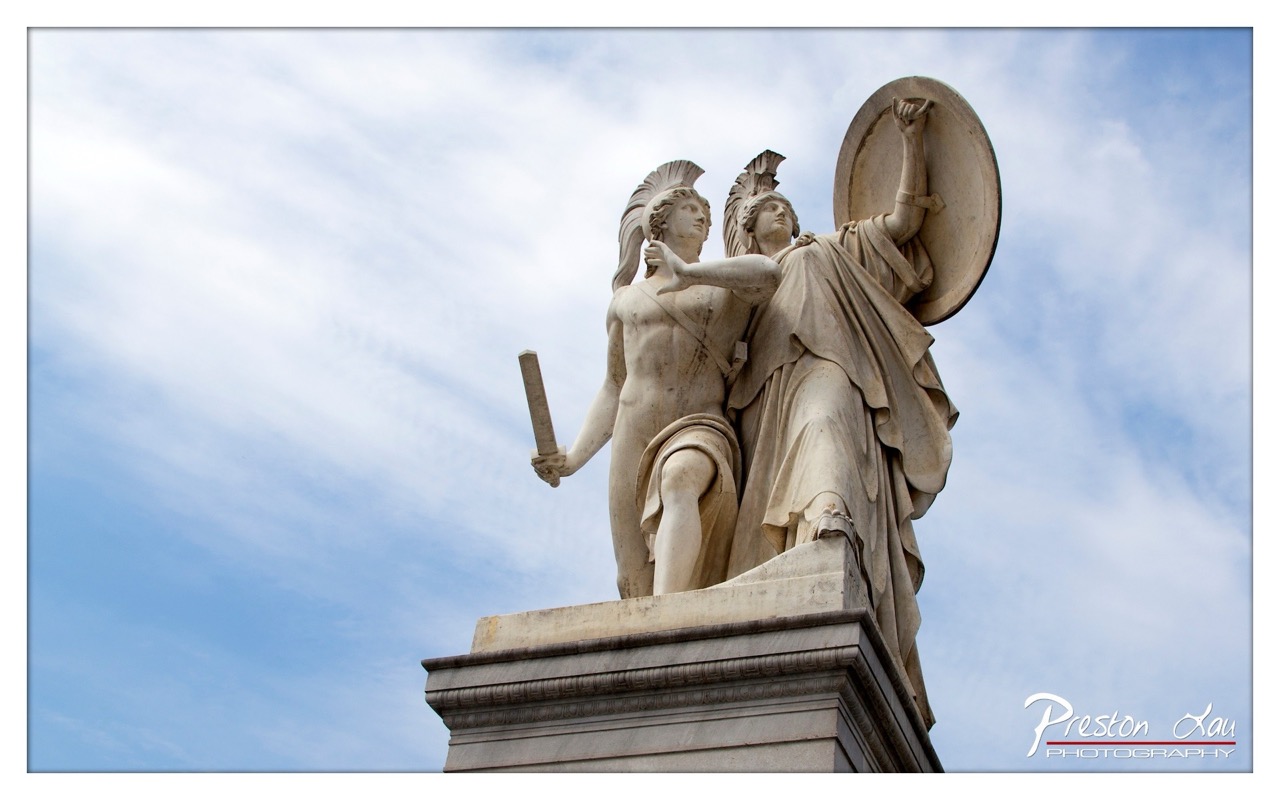

Standing Tall Against the Sky
Rating: 7/10
Perched high on a pedestal, these magnificent stone figures certainly make a statement against the bright sky. We've got a dynamic duo here, one holding what looks like a weighty baton or scroll (maybe they're heading to a very important meeting, or perhaps it's just a stylish club?), and the other, a formidable individual brandishing a shield like they're about to deflect a rogue pigeon or maybe just asserting their personal space. They're both decked out in classic warrior gear, complete with some serious helmet plumes, giving off a vibe that screams 'ancient heroism' or 'ready for anything... as long as it doesn't involve cardio'. The material looks like beautifully weathered stone, adding to the sense of history and permanence, while the backdrop of a bright blue sky with streaky white clouds provides a suitably epic stage for their stone-cold drama.
From a photography standpoint, the choice of a low-angle perspective was a solid move, really emphasizing the statue's scale and power. It makes you feel like you're craning your neck up, suitably impressed. Compositionally, placing the statue slightly off-center works well, leaving breathing room in the sky, although maybe trimming a smidge more off the bottom could have kept the focus purely on the figures and their base rather than the whole pedestal. The lighting, while soft and even – great for showing off the intricate details of the carving and the stone texture without harsh shadows – could have benefited from a bit more drama, perhaps hitting them from the side to carve out their forms more decisively. The colors are simple and effective: the cool tones of the stone against the classic blue and white sky. Overall, a good capture, though that watermark is a bit of a party crasher down in the corner.
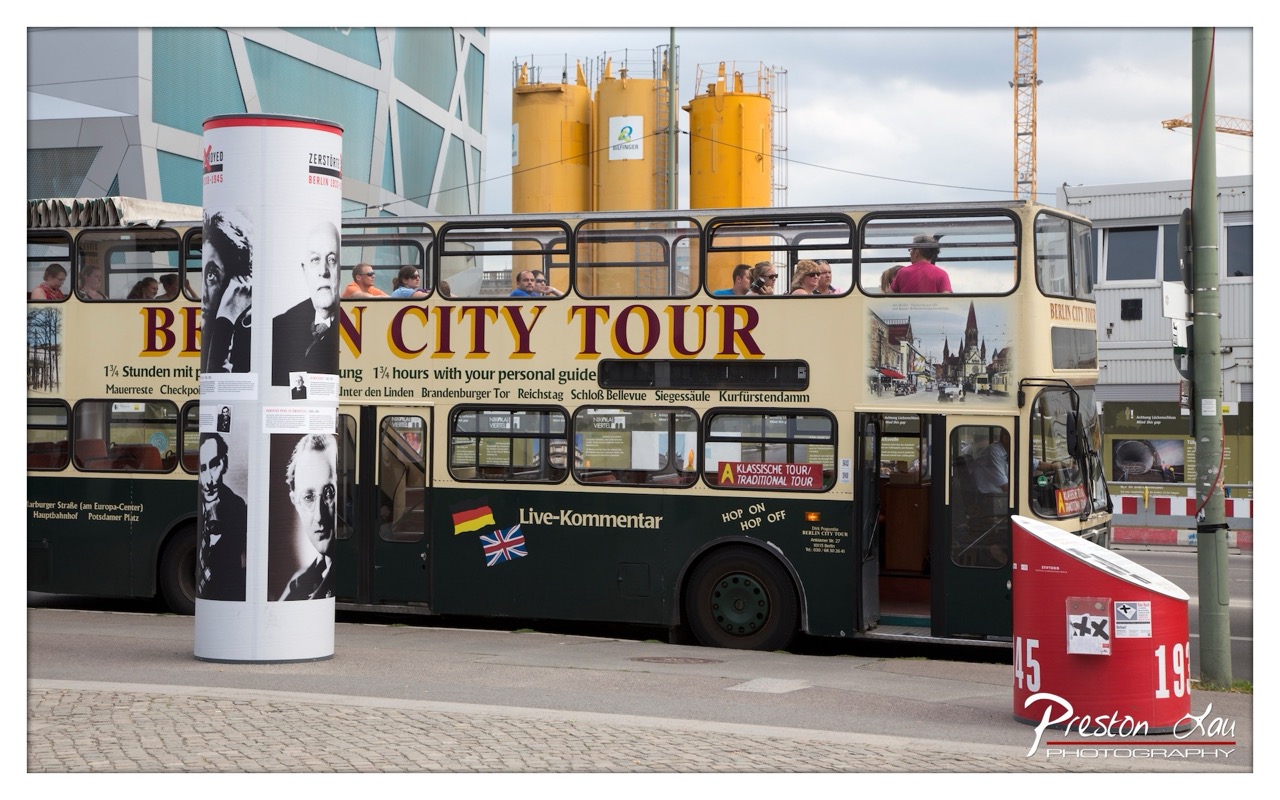

Berlin Layers: Bus, History, and Cranes
Subject (Berlin Tourist Scene Captured): 6/10
Welcome to Berlin, where history literally stands in your way while you're trying to photograph a tour bus. The main subject here is undeniably the classic double-decker "Berlin City Tour" bus, packed with tourists enjoying the sights, or perhaps just the air conditioning on a presumably warm day. In the foreground, commanding attention (perhaps too much attention?), are a couple of cylindrical pedestals, one white featuring historical photographs and text, and a bright red one adorned with the significant dates '45' and '1990', shouting silent tales of the city's complex past. The mood is one of typical urban tourism – a blend of historical awareness and modern convenience, set against a backdrop of evolving cityscapes, complete with cranes, modern geometric buildings, and some distinctly industrial yellow towers that look suspiciously like giant Tic Tacs floating in the distance.
From a photographic standpoint, the composition is a brave attempt at layering, using the historical pedestals to frame (or perhaps just obstruct) the star of the show, the bus. While this adds visual depth and thematic relevance, one can't help but wonder if a clear shot of the bus wasn't the primary goal. The lighting, courtesy of a classic German grey sky, is wonderfully diffused, ensuring no harsh shadows but also stripping the scene of any dramatic contrast. The colors are generally muted, except for the striking red pedestal and the cheerful yellow towers, which provide much-needed visual anchors in the frame. It’s a solid documentary shot capturing a specific moment in Berlin’s tourist cycle, showcasing the juxtaposition of its layered history with the ongoing urban development, even if the foreground elements feel a *smidge* like they wandered into the frame by accident.
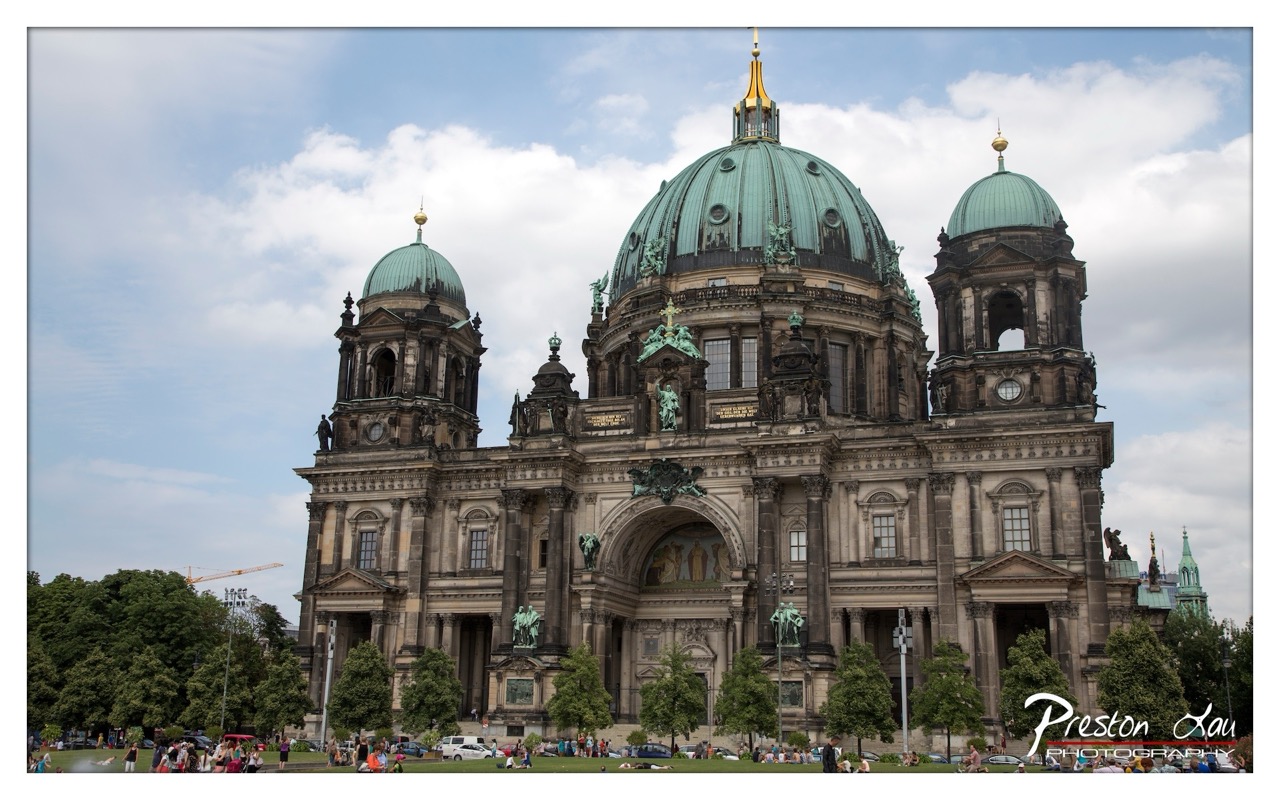

The Grand Green Dome
Rating: 9/10
Behold the magnificent Berlin Cathedral, a true architectural heavyweight dominating the frame with its impressive domes and intricate stonework. In the foreground, a lively scene unfolds as locals and tourists alike sprawl across the green grass, picnicking, chatting, and generally enjoying a leisurely day under the cloudy sky, seemingly oblivious to the sheer grandeur towering above them. It's a classic juxtaposition of monumental history and everyday life – some admiring the masterpiece, others just trying to find a comfortable spot for a nap.
The mood is one of stately serenity mixed with casual relaxation. Composition-wise, the building is the undeniable star, centered and filling the frame effectively, although a slightly wider or lower angle might have emphasized its scale even more relative to the tiny humans below. The lighting, courtesy of an overcast sky, provides soft, diffused light, which is perfect for architectural detail but perhaps lacks a bit of dramatic punch. The vibrant green of the domes and the lush grass provide nice pops of color against the stone grey. While the foreground people add scale and life, the rogue construction crane peeking over the trees on the left is a less welcome guest in this otherwise picturesque vista, a reminder that even historic landmarks exist in a modern, ever-changing city. And, of course, no masterpiece capture is complete without a generously sized watermark ensuring everyone knows who *might* be thinking about selling prints.
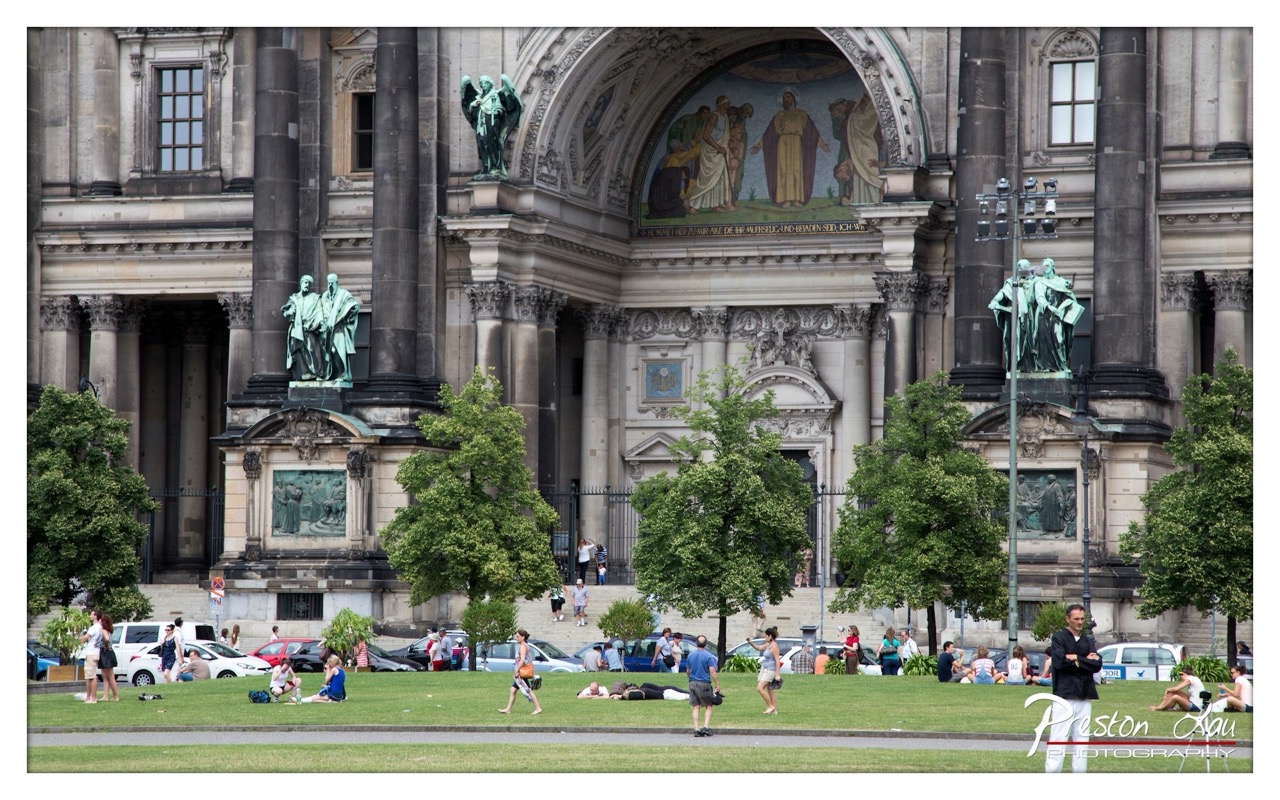

Berlin Cathedral Calm
Rating: 9/10
This photo captures the impressive scale of the Berlin Cathedral towering over a relaxed summer scene. The subject, undeniably the monumental church facade with its intricate details, statues, and grand entrance archway featuring a detailed mosaic, receives a high rating for its sheer architectural presence and historical weight. What's happening is a common summer sight in popular urban spots: people are lounging on a grassy lawn, some sitting, some lying down, others walking or standing, enjoying the warm weather and the view. A few cars are parked or driving in the background street. The mood is a pleasant blend of historical grandeur and casual leisure, feeling calm and summery despite the bustling city context implied.
From a photographic perspective, the composition attempts to balance the towering subject with the human element in the foreground. The grand columns and arches of the cathedral dominate the upper frame, while the green lawn filled with people occupies the lower half, creating a layered scene. The lighting is soft and diffused, likely from an overcast or late-day sun, which avoids harsh shadows but makes the building details a bit flat. Color-wise, the image is dominated by the rich grey-brown of the stone and the vibrant green of the grass and trees, punctuated by the colorful clothing of the people and the blue of the mosaic. The style is clearly documentary, capturing a moment in time at a famous landmark. While the scale is well-represented, ensuring sharp focus across both the distant building and the closer people simultaneously is a challenge here; perhaps a slightly different angle or aperture could have enhanced this. It's a classic tourist scene, showing that even the most magnificent structures serve as backdrops for everyday life, or in this case, everyday napping.
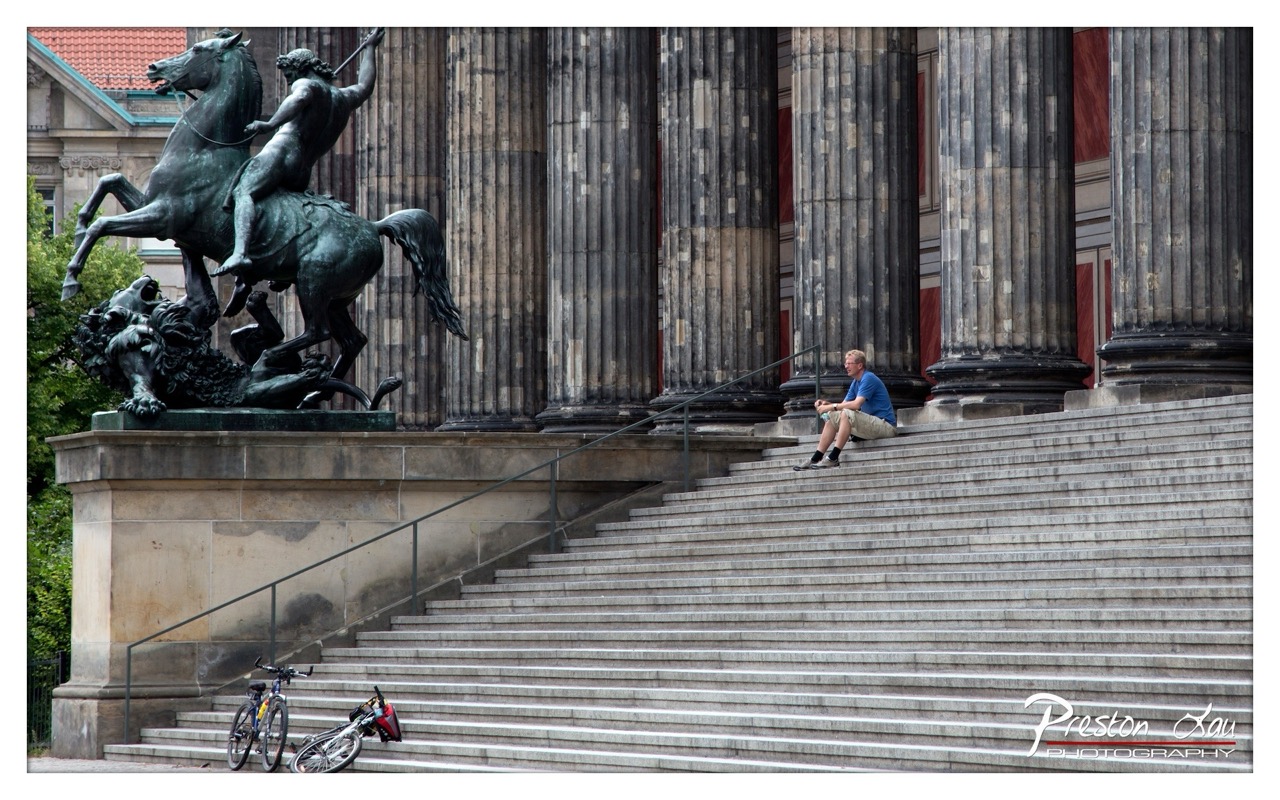

Stairway to ... Relaxation?
Subject Rating: 7/10
This photograph captures a moment of serene stillness against a backdrop of historical drama and architectural grandeur. On the vast, imposing steps of a stately building, likely a museum or government structure given the monumental columns and classical statue, a solitary man in a blue shirt and shorts is seated, seemingly lost in thought or simply enjoying a quiet break. To the left, a striking bronze statue depicts a dramatic scene: a mounted figure battling a powerful lion, a struggle frozen in time on a stone pedestal. At the bottom of the steps, two bicycles are parked or perhaps just left leaning, adding a touch of modern everyday life to the scene. The overall mood is a fascinating blend of the monumental and the mundane, a place where epic battles cast in bronze coexist with a guy having a sit-down and parked bikes.
From a photographic perspective, the composition uses the strong diagonal lines of the grand staircase to draw the eye up and across the frame, leading towards the seated figure and the towering columns beyond. The statue provides a powerful, dynamic focal point on the left, balancing the more subdued human presence on the right. The lighting appears diffuse, likely from an overcast sky, which minimizes harsh shadows and allows for detail across the stone and bronze textures, though it also flattens the scene somewhat. The color palette is predominantly grey stone, with hints of green foliage and the warm reddish-brown doors visible between the massive columns. The juxtaposition of the classical sculpture, the neoclassical architecture, and the modern elements like the man and the bikes is the core subject matter here, creating a narrative contrast between history, art, and contemporary life; perhaps the bikes are waiting for the guy to finish contemplating the timeless struggle before heading off to their own less dramatic adventures.
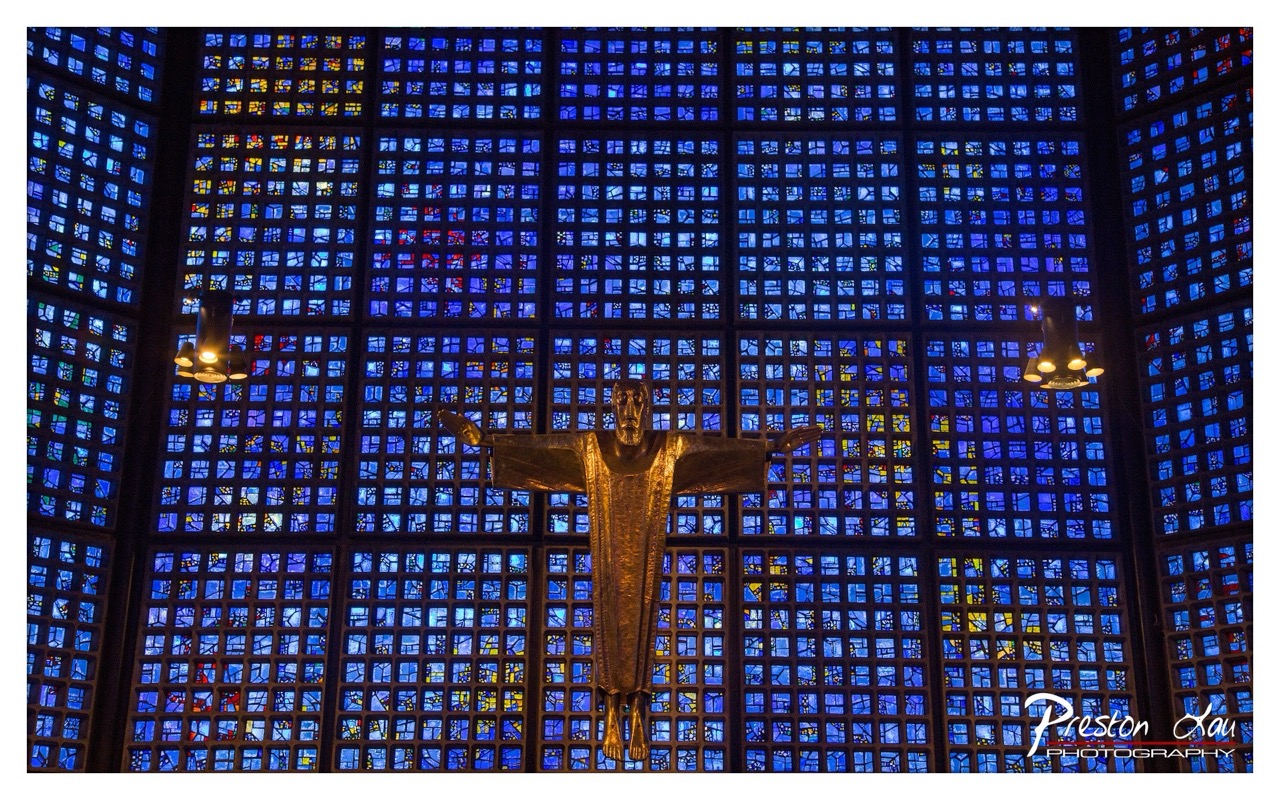

Divine Beacon in Blue Hues
Rating: 9/10 (Subject: A powerful, albeit slightly aloof-looking, statue of Christ against an epic backdrop)
This shot captures the striking interior of what appears to be a modern church, dominated by a colossal, abstract stained-glass window composed of countless small, vibrant blue panes. Front and center, a golden-toned statue of Jesus stands with arms outstretched, looking less like he's about to embrace you and more like he's just finished directing a particularly dramatic orchestral movement. The sheer scale of the stained glass provides a breathtaking, almost cosmic, backdrop, making the statue feel both significant and slightly dwarfed by the overwhelming blue. The mood is one of awe and reverence, though the geometric pattern of the window adds a touch of modern abstraction to the traditionally spiritual setting. It's the kind of place that makes you whisper, "Wow," and then immediately wonder how the heck you're going to expose for both the bright window and the dimmer statue without blowing out everything or losing detail in the shadows.
From a photographer's perspective, the composition is strong, with the statue centered and the symmetrical architecture drawing the eye inward. The lighting is challenging but effective; the diffused light from the vibrant blue window backlights the entire scene, creating a dramatic contrast with the golden statue. While the blue dominates the color palette, hints of yellow, red, and green peeking through the glass add complexity and visual interest, preventing the scene from becoming monochromatic. The low angle emphasizes the grandeur of the space. The two strategically placed lamps add a little foreground interest and perhaps a bit of fill light, though the primary source is clearly the window. It’s a bold choice to lean into the intense blue, and it certainly makes for a memorable, slightly otherworldly image. Capturing the detail in both the dark statue and the bright window is a classic high-dynamic-range nightmare, likely requiring careful exposure or post-processing wizardry, proving even divine architecture throws photographic curveballs.
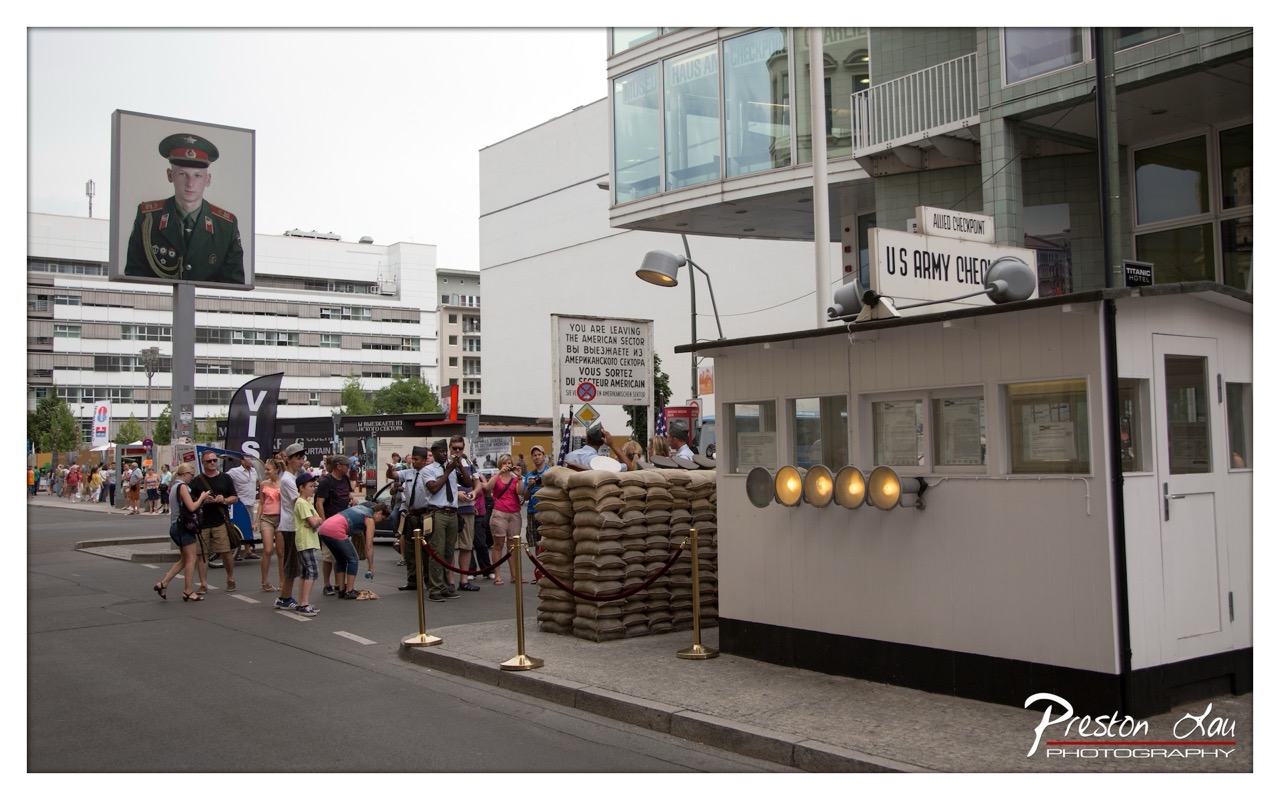

Checkpoint Charlie: Cold War Relic, Warm Tourist Trap
Rating: Subject (The Checkpoint Scene): 7/10
Welcome to Checkpoint Charlie, where the Iron Curtain now features a velvet rope and sandbags are less about defense and more about providing a backdrop for selfies. This image captures the bustling tourist scene around the famed border crossing between East and West Berlin. A motley crew of visitors, some dressed in vaguely military garb for effect (or perhaps just because it was laundry day), mill about near the replica guard shack. Towering over the street like a communist propaganda billboard gone rogue is a colossal portrait of a soldier looking remarkably stoic, perhaps wondering how his grim posting ended up as a stop on a hop-on, hop-off bus tour. The mood is a bizarre blend of historical solemnity and cheerful, slightly chaotic tourism, proving that even the most serious past can become a profitable present.
From a photographic standpoint, the composition is a bit of a grab bag, with the checkpoint building anchored firmly on the right and the giant soldier portrait trying to balance the frame from the left – a sort of visual Cold War standoff in itself. The flat, diffused lighting suggests an overcast day, which, while preventing harsh shadows, also renders the scene a touch undramatic, much like a carefully planned five-year economic plan. Colors are subdued, relying on the green uniform and the occasional splash of tourist attire for interest against the predominantly grey and white urban backdrop. The subject matter, combining history, architecture, and human activity, offers plenty of narrative potential, though here it feels more like a snapshot of a crowded moment than a deeply insightful capture of the site's meaning. It's a classic documentary style, capturing the 'what is', but perhaps leaving the 'why it matters' slightly lost in the crowd amidst the modern buildings in the background.
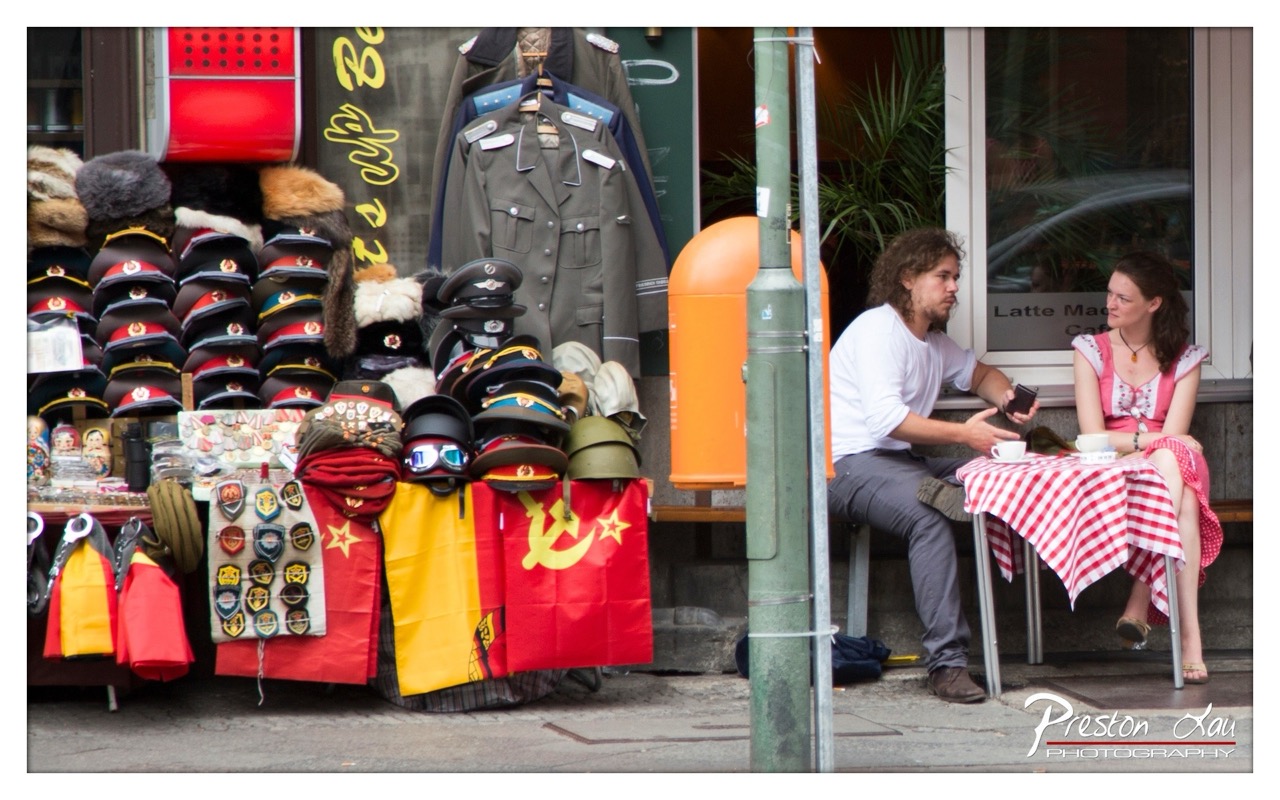

Cold War Relics and Coffee Dates
Rating: 7/10
This image presents a fascinating, if slightly cluttered, juxtaposition of historical artifacts and everyday life, earning it a respectable 7/10. On the left, a vendor stall overflows with a chaotic yet captivating assortment of military surplus. Piles of caps, including what appear to be Soviet-era officer hats and fur Ushankas, compete for space with drab military uniforms, gleaming badges, and even what looks like a couple of German Stahlhelm helmets. Adding to the visual cacophony are vibrant red banners featuring the Soviet hammer and sickle and a Chinese-style star, alongside charmingly out-of-place matryoshka dolls. The scene is a riot of textures and colors – the matte green of uniforms, the shiny black of visors, the fluffy brown of fur, and the stark reds and yellows of political symbols. It feels like a curio shop exploded onto the street, offering everything you might need for a small-scale historical reenactment or perhaps just a very unique souvenir.
In sharp contrast to the historical overload on the left, the right side of the frame features a serene, modern-day tableau. A man and a woman sit at a small, red and white checkered table outside a cafe, identifiable by the "Latte Mac..." sign visible through the window. They are engaged in conversation, the man looking at his phone while the woman watches him, a couple of coffee cups between them. This scene is quieter, bathed in softer light, and offers a moment of contemporary calm against the backdrop of bygone eras. Compositionally, the large vertical pole near the center awkwardly divides the frame, though it could also be seen as a visual representation of the distinct worlds occupying the same physical space. The lighting is relatively even, preventing harsh shadows, which suits the documentary style of the street photography. While the subject matter is rich, the composition feels slightly unbalanced, and the pole is a distracting element that keeps the image from achieving a higher score, but the sheer visual interest of the vendor stall makes up for some of these technical quibbles.
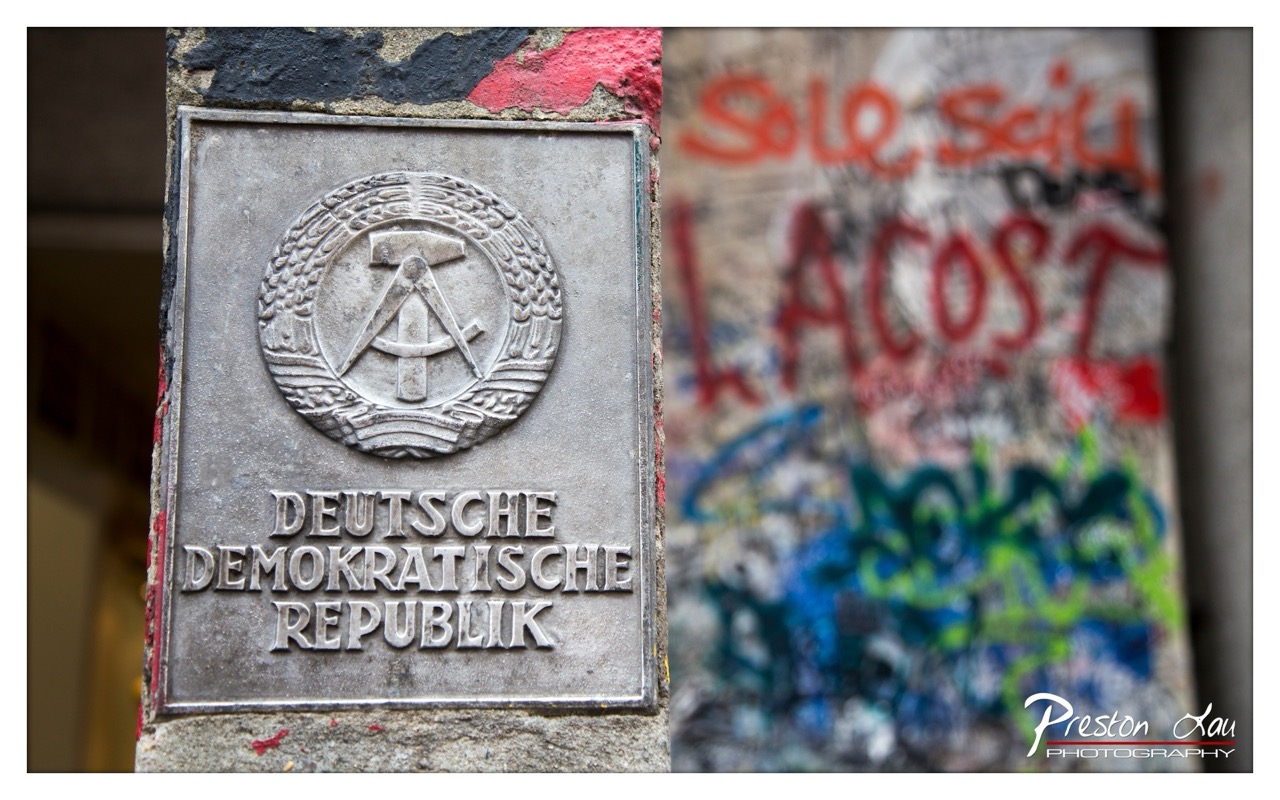

The Relic and the Renegades
Subject Rating: 8/10
This compelling image presents a stark contrast between historical permanence and fleeting urban expression. In sharp focus, a weathered, rectangular metal plaque proudly displays the coat of arms of the German Democratic Republic – a hammer and compass encircled by a wreath of grain, symbolizing the worker, the intellectual, and the farmer (or perhaps just a really intricate compass needing repairs). Below, the words "DEUTSCHE DEMOKRATISCHE REPUBLIK" are clearly embossed, a relic from a state that no longer exists. The plaque is mounted on a textured, grey concrete wall, subtly stained with red paint around the edges, hinting at previous layers of history or perhaps an enthusiastic decorator. The mood is one of reflective melancholy and historical juxtaposition, highlighting the passage of time and the layering of different eras on the same physical space.
The photographic technique is effective in emphasizing this contrast. A shallow depth of field isolates the plaque as the clear, undeniable subject, while the background dissolves into a vibrant, chaotic blur of graffiti. This soft-focus background, though indistinct, adds significant context, showing bold red lettering ("ACOST" is somewhat legible) and splashes of blue and green spray paint – the visual language of contemporary urban life. The lighting appears soft and even, perhaps natural light, which helps to reveal the texture and detail of the metal plaque without harsh shadows. Compositionally, the plaque occupies the left side of the frame, leaving space for the blurred background to contribute to the narrative. The photographer, Preston Lau, has added their watermark subtly in the bottom right corner, a final modern touch on this historical observation. It's a clever visual metaphor for history being buried under the noise of the present.
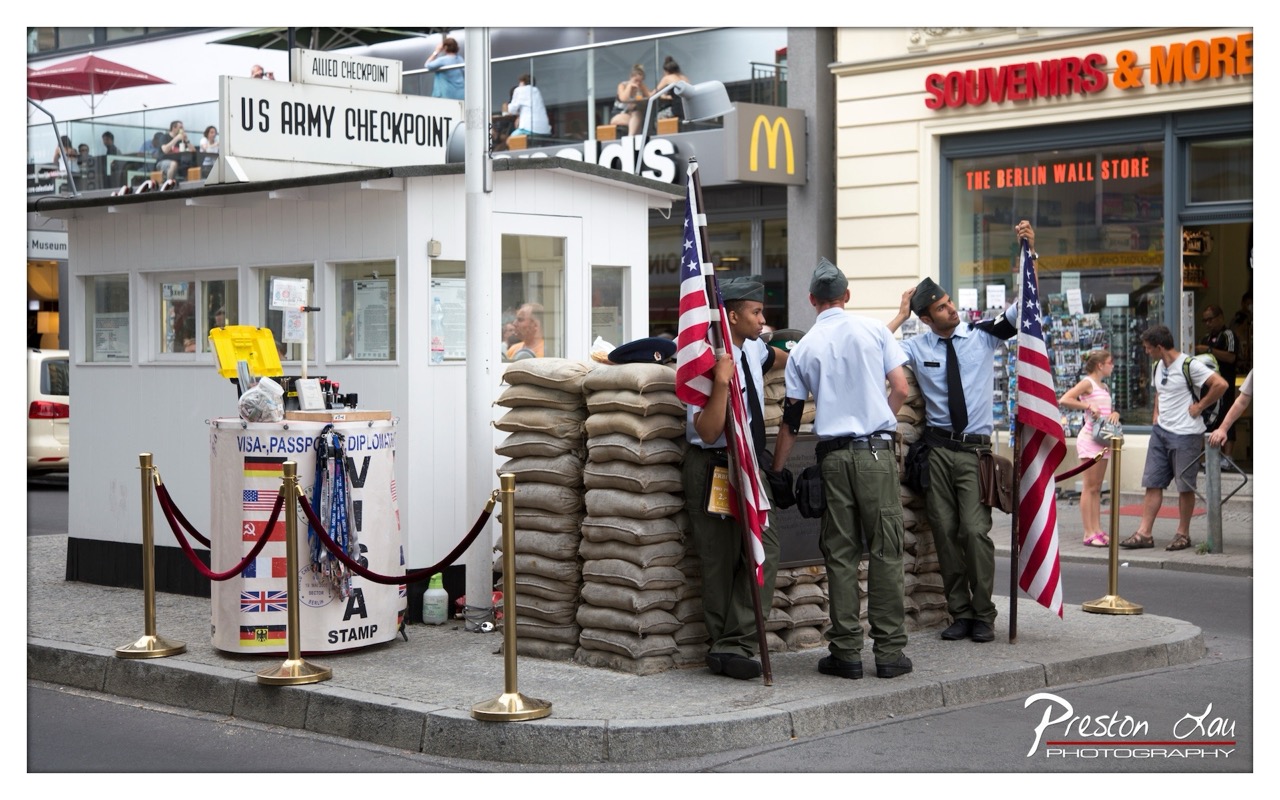

Checkpoint Charlie Reenactment Extravaganza
The subject, a gaggle of historical reenactors posing as US Army soldiers at Checkpoint Charlie, clocks in at a fascinating 7/10. What's happening is a standard day at one of Berlin's most famous intersections – a blend of historical performance art and brisk tourism. Three individuals in period-style uniforms stand guard by a heap of sandbags and a white guard shack, one theatrically brandishing the American flag. They're clearly engaging with passersby, likely offering photo opportunities, perfectly embodying the intersection of Cold War history and modern-day commercial savvy. The mood is a unique mix of manufactured historical solemnity and the lively, slightly chaotic atmosphere of a popular tourist spot on a sunny day.
From a photography perspective, the composition works well, placing the core checkpoint elements prominently while allowing the bustling background to provide context. The diagonal line of the curb and the red velvet ropes help lead the eye into the main scene. The bright daylight provides ample illumination, though it creates some harsh shadows typical of midday sun. The color story is an interesting contrast between the military drab of the uniforms and sandbags and the vibrant, almost garish signs in the background like the yellow McDonald's arches and the red "Souvenirs & More" text – a visual metaphor for the site itself. It’s a classic street photography shot capturing the peculiar reality of Checkpoint Charlie today, where the echoes of history are comfortably nestled amongst fast food and souvenir stands selling pieces of a fallen wall.
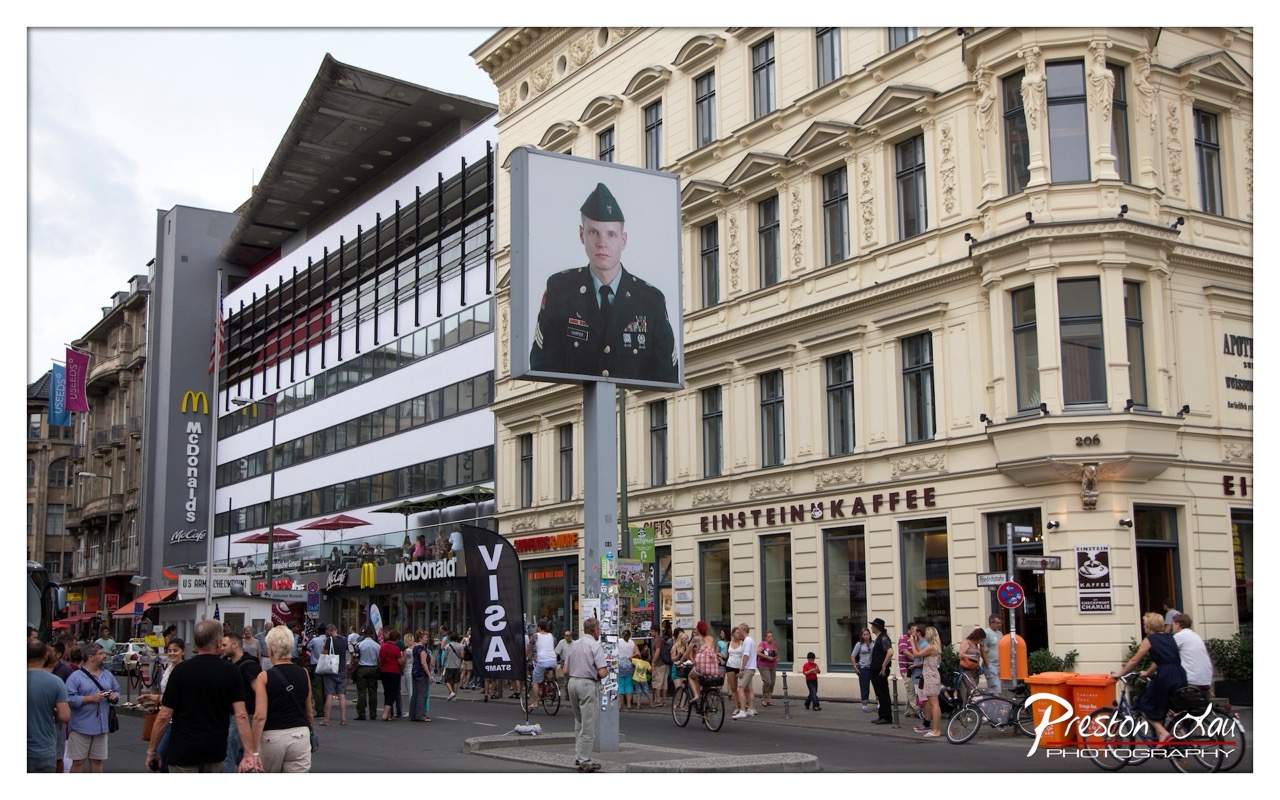

Urban Junction: Where Soldiers Meet Golden Arches
Rating: 7/10
This image captures a wonderfully chaotic street scene, likely in Berlin, where the jarring juxtapositions of urban life are on full display. On the left, a stark, modern building proudly houses the golden arches of McDonald's, while on the right, a beautifully ornate classical building offers the refined charm of Einstein Kaffee. Looming over it all is a giant billboard featuring the stern, earnest face of a soldier named Harper. Below, a vibrant current of humanity flows along the sidewalk and street – people walking, cycling, and presumably grappling with the profound philosophical implications of choosing between a Big Mac and a latte under the watchful gaze of a military man. The overall mood is one of bustling everyday life, underscored by an unexpected layer of solemnity brought by the portrait, making you wonder if soldier Harper is reviewing the crowd's snack choices.
From a technical perspective, the composition is busy, almost overwhelming, reflecting the sensory overload of the scene. It's a vertical slice of urban texture, with the central billboard acting as a slightly uneasy focal point between the architectural styles. The lighting is classic overcast-day softbox – even, shadowless, and forgiving, perfect for capturing detail without harsh contrasts, though perhaps lacking a certain dramatic flair. The color palette is mostly muted, dominated by the beige of the classical building and the grey/white of the modern one, allowing the greens of the uniform and the reds and yellows of the commercial signs to stand out. It's a candid, documentary approach that captures the messy, fascinating reality of a busy city intersection, successfully highlighting the odd, sometimes humorous, visual dialogues that occur in public space.
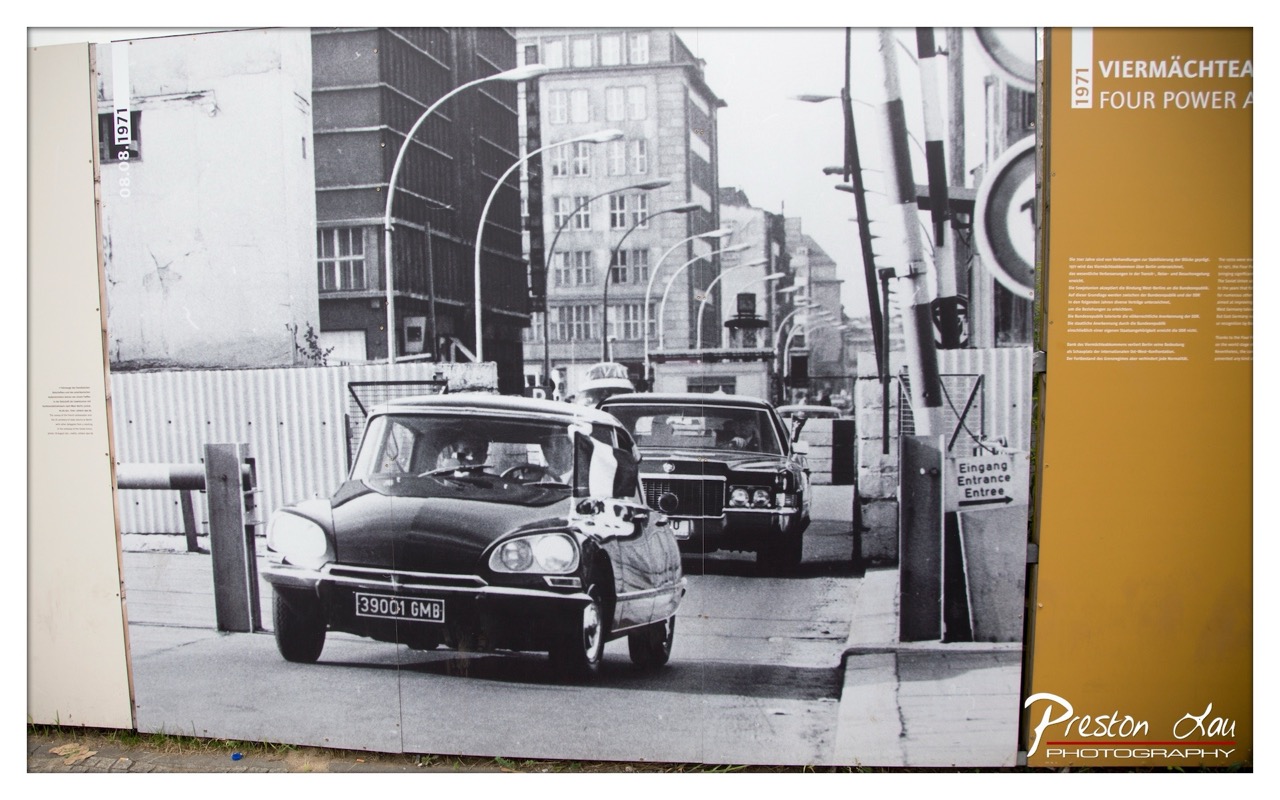

Historical Checkpoint Display
Rating: 7/10
This image captures a large outdoor display board featuring a fascinating black and white historical photograph from August 8, 1971. The photo within the image depicts a border crossing scene, likely in Berlin given the context provided by the text "VIERMÄCHTEABKOMMEN" (Four Power Agreement) and the mention of "Eingang Entrance entree". In the foreground of the historical image, a sleek Citroën DS, a classic of its time, is queuing behind what appears to be a larger American car, possibly a Cadillac, before a barrier. The background shows multi-story buildings and numerous streetlights lining the road, suggesting an urban environment. The overall mood is historical and slightly tense, reflecting the reality of cold war division, while the display itself lends an informational, almost museum-like tone to the current scene.
From a photographic perspective, this image is a documentary shot of a display. The photographer has captured the board itself, including the historical photograph, accompanying text panels, and even the ground below. While functional for showing the context of the display, the composition feels somewhat utilitarian, cutting off the full board at the edges and including distractions like the foreground pavement and grass. The outdoor lighting, while necessary for the setting, likely introduces some glare on the printed surface of the historical photo. A significant detractor is the large, white watermark placed prominently over the lower right portion of the historical image, which is the primary subject of interest *within* the display. It's like putting a giant stamp on a painting – slightly annoying, but I suppose it serves a purpose, even if that purpose feels like an ironic commentary on boundaries, much like the historical photo itself.
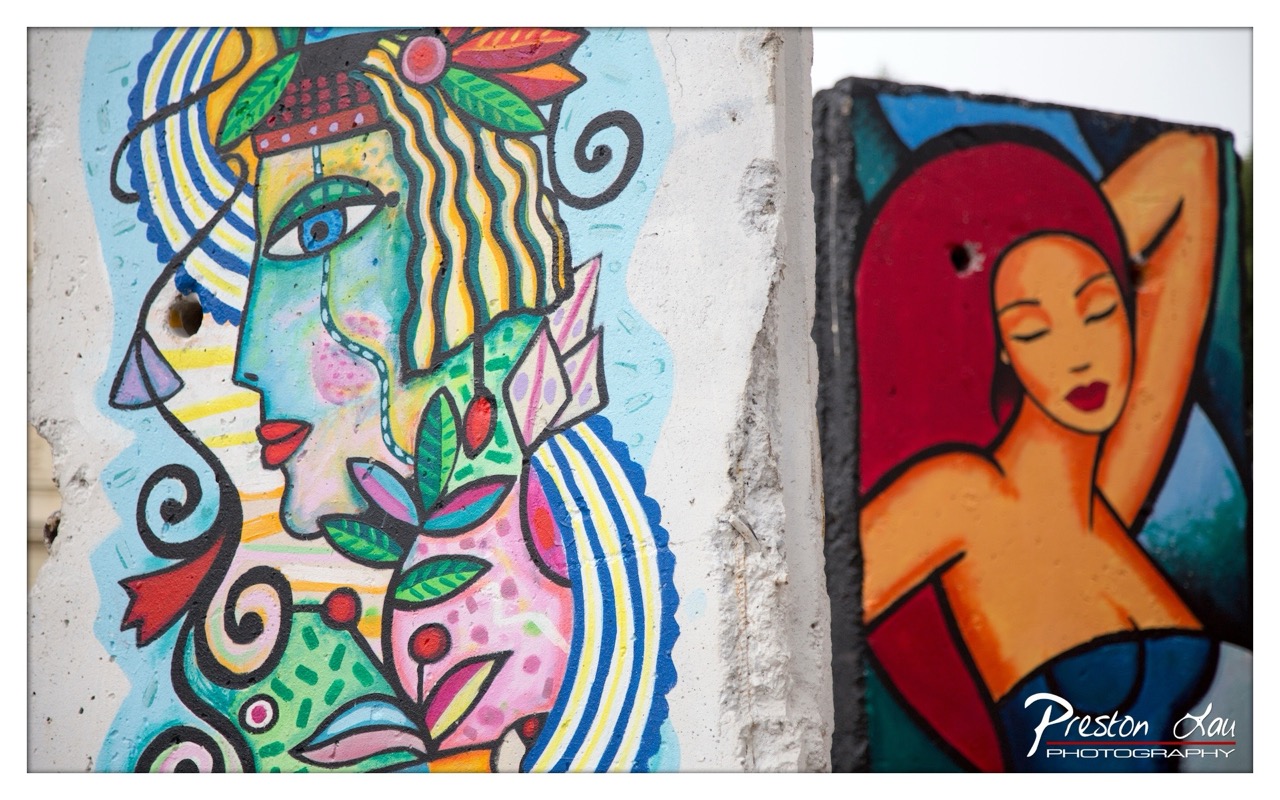

Concrete Canvas: Vibrant Echoes
Subject: 8/10
Stepping right up to the concrete gallery, we encounter a fascinating dialogue between two distinct styles of street art etched onto a stark, weathered wall, likely a relic with a story or two. The composition expertly places these vibrant pieces side-by-side, highlighting their differences while celebrating their shared defiance against the grey canvas. On the left, a complex, intricate portrait bursts with lively colours and organic forms, a whirlwind of stylized features and botanical elements, almost like nature reclaiming the stone. Beside it, a bolder, simpler depiction of a reclining figure in striking red and orange hues offers a different kind of expressive power, a moment of serene repose captured in paint. The mood here is a compelling mix of historical gravitas from the wall's presence and the unbridled joy and energy radiating from the art itself, a visual conversation between past rigidity and present expression.
From a photography perspective, the natural, diffuse lighting is a blessing, rendering the intense colours beautifully saturated without harsh shadows, letting the art truly pop against the drab concrete background – it's like the sun finally decided to cheer up the wall. The detail captured in the rough texture of the wall provides a tactile dimension to the image, making you almost feel the material, a gritty counterpoint to the smooth paint. The colour palette is undeniably the star of the show, a dazzling array of blues, greens, yellows, and reds that refuse to be ignored; it's a masterclass in colour contrast against a neutral backdrop. The slightly angled perspective adds a dynamic touch, preventing it from being a flat, straight-on shot, although it does slightly favour the left mural. Overall, a strong capture that effectively showcases the power of art to transform a mundane (or historically significant) surface into a public gallery.
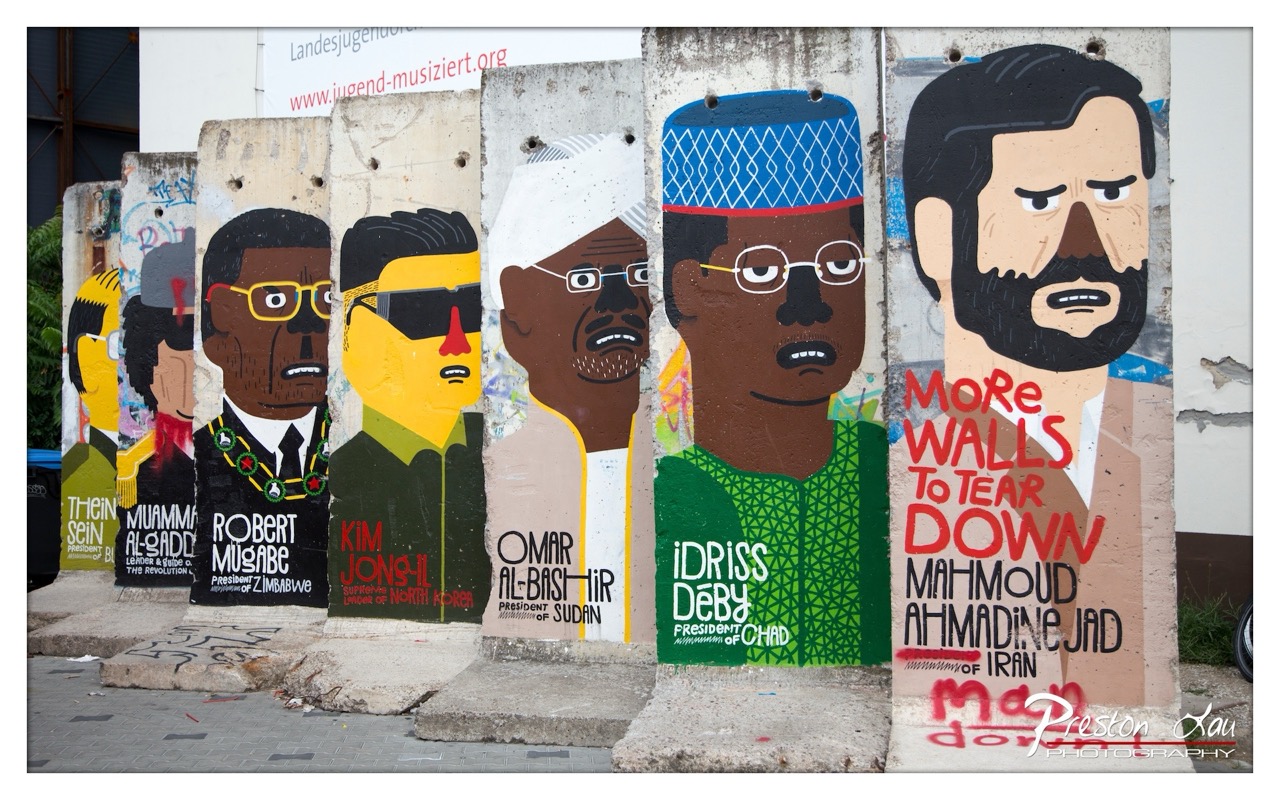

The New Axis of Walls
Rating: 8/10
Stepping right up to a historical relic turned canvas, we find ourselves face-to-face with a rogues' gallery painted onto sections of the infamous Berlin Wall. Rating this visual commentary a solid 8/10, primarily for its powerful subject matter and location choice. The mood here is undeniably satirical and politically charged, using the very symbol of division to call out modern leaders perceived as building their own 'walls' of oppression. It's a biting, humorous take on global politics, asking us to consider "MORE WALLS TO TEAR DOWN" beyond just the physical ones. The juxtaposition of the grim history of the wall with these brightly colored, almost cartoonish portraits of figures like Mugabe, Gaddafi, and Kim Jong-il creates a jarring and thought-provoking effect, a grim chuckle at the persistence of walls in a supposedly connected world.
From a photography perspective, the composition effectively lines up the concrete panels, creating a clear horizontal flow across the various dictators depicted. The lighting is quite flat and even, typical of an overcast day, which is practical for documenting the graffiti without harsh shadows, though it doesn't add much dramatic flair – perhaps fitting for the grim subject matter. The color palette is intentionally bold and simple, using block colors that pop against the weathered grey concrete, emphasizing the graphic style of the artwork. The style itself is distinctly street art – raw, direct, and illustrative, perfect for conveying a quick, impactful political message. The rough texture of the wall panels, the pavement below, and the glimpse of a background building and sign all add layers of context to this powerful open-air gallery piece, a stark reminder that history's lessons, and walls, come in many forms.
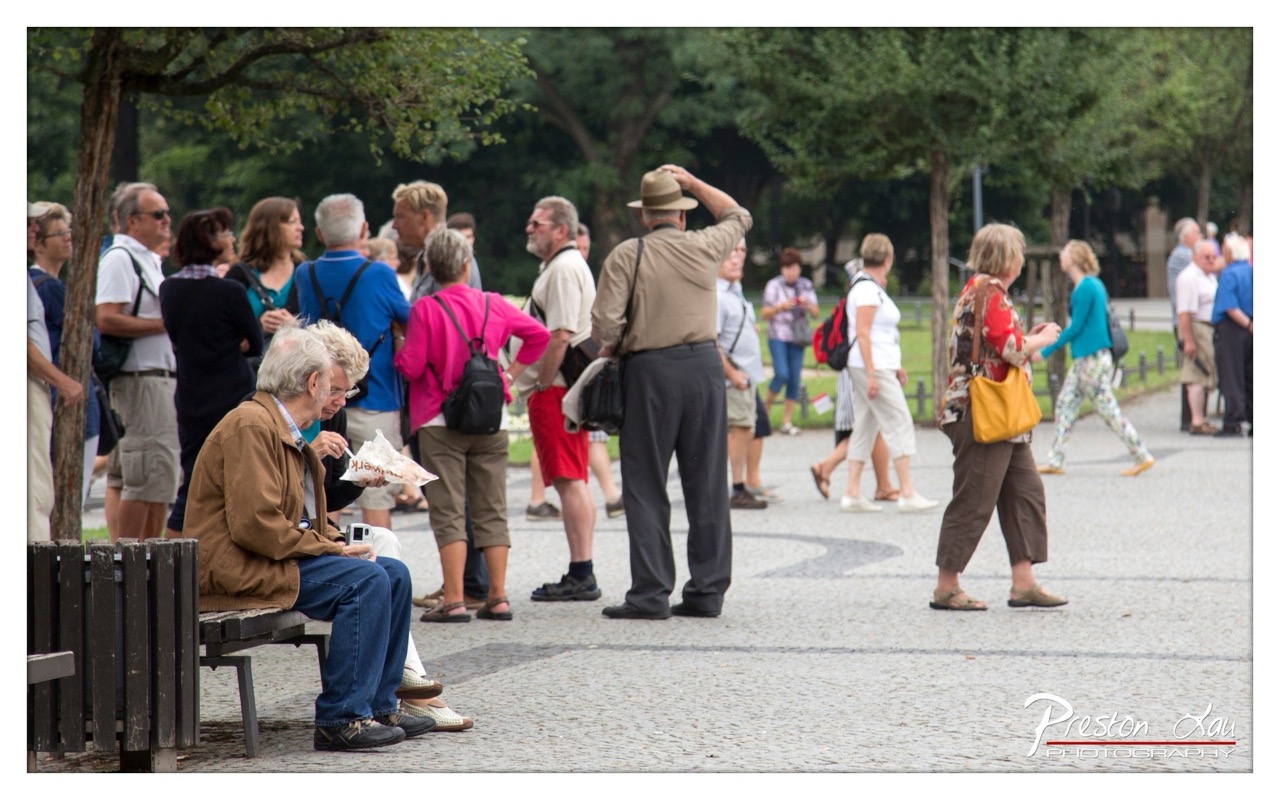

A Confluence of Casual Tourists
Rating: 7/10
Ah, the classic tourist tableau, captured here with a healthy dose of observational realism. Our subjects, rated a solid 7/10 for their delightful ordinariness, mill about a sun-dappled (or perhaps overcast-dappled, judging by the soft light) public space. In the foreground, a couple enjoys a snack on a bench, perhaps debating the merits of the local cuisine or just trying to figure out which map orientation is *actually* north. Mid-frame, a gentleman adjusts his hat with practiced nonchalance, a subtle gesture that screams "I'm on vacation and trying to look effortlessly cool, or maybe I just have an itchy scalp." The overall mood is relaxed and exploratory, the quiet hum of sightseeing palpable among the diverse group, ranging from brightly attired backpack-wearers to those sporting the classic beige and khaki uniform of the seasoned traveler.
From a technical standpoint, the composition anchors the viewer with the seated couple on the left, drawing the eye deeper into the scene where the hat-adjuster serves as a secondary focal point. The photographer employed a relatively shallow depth of field, effectively blurring the background trees and distant figures into a pleasant bokeh haze, ensuring our main players don't get lost in the foliage – a wise choice, because who cares about trees when there's potential hat drama? The soft, diffused lighting is forgiving, perfect for rendering the various shades of beige and brown favoured by the discerning tourist fashionista, though the pops of hot pink and bright yellow provide a welcome visual jolt. It's a candid style that feels unposed, capturing genuine moments... or at least, moments that look genuine when immortalized in pixels on the detailed paving stones.
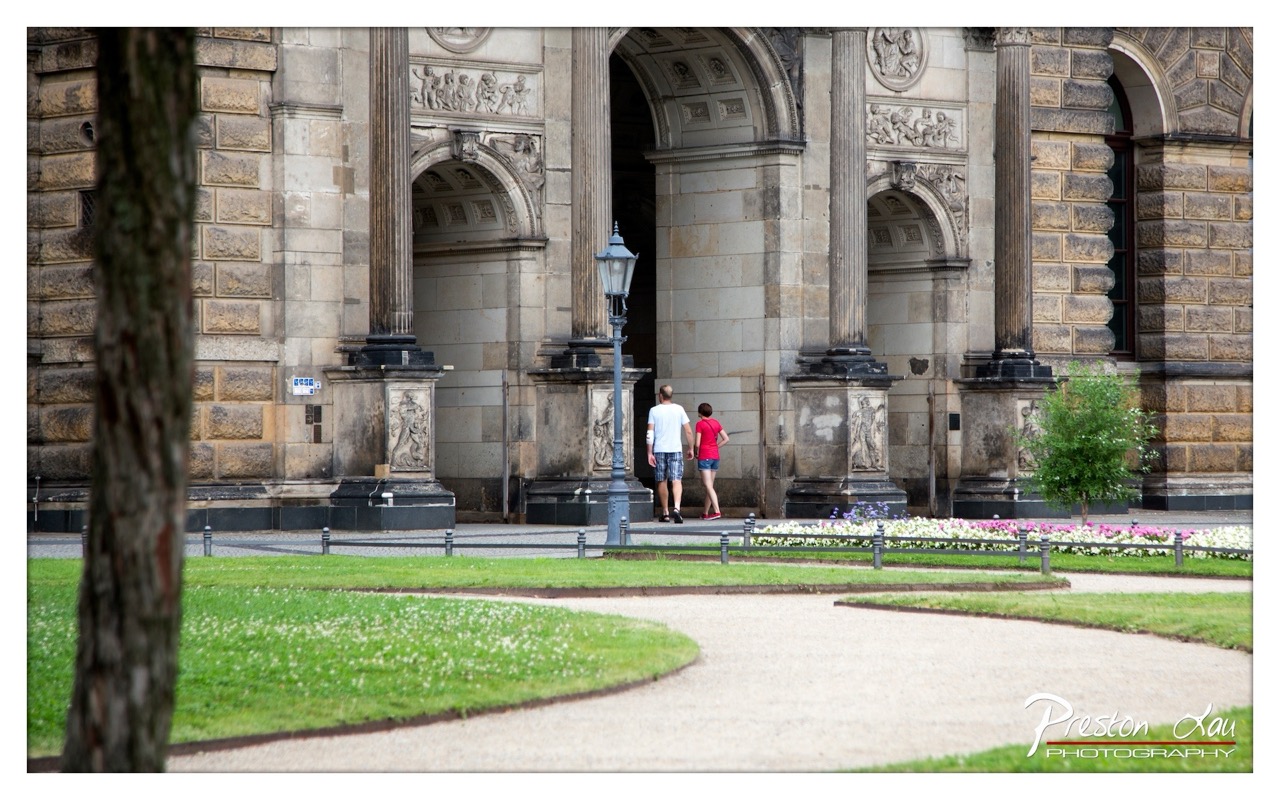

A Grand Approach
Rating: 7/10
This image captures a tranquil scene as a couple walks away from the camera, heading towards the imposing entrance of a magnificent stone building. The architecture is the undeniable star, with its classical columns, grand arched doorways, and detailed sculptural elements adorning the facade. A classic lamppost stands sentry near the path the couple takes, adding a touch of old-world charm. The foreground features a curved path winding through neatly manicured grass and patches of small, colorful flowers, suggesting a peaceful park or garden setting leading up to the historic structure.
From a photographer's standpoint, the composition aims to create a sense of scale by dwarfing the human figures against the monumental architecture. The soft, diffused light is kind to the stone texture and carvings, allowing details to pop without harsh contrast. However, the large, out-of-focus tree trunk dominating the left side of the frame is a significant distraction, pulling the eye away from the main subjects and feeling like an unintentional photobomb by Mother Nature. The lamppost also feels a little awkwardly placed, slightly obscuring the couple. While the subject matter is interesting, a slightly different angle or perhaps a tighter crop could have better integrated the couple and the building while eliminating the intrusive foreground element, proving that sometimes, even a majestic tree should politely stay out of the shot.
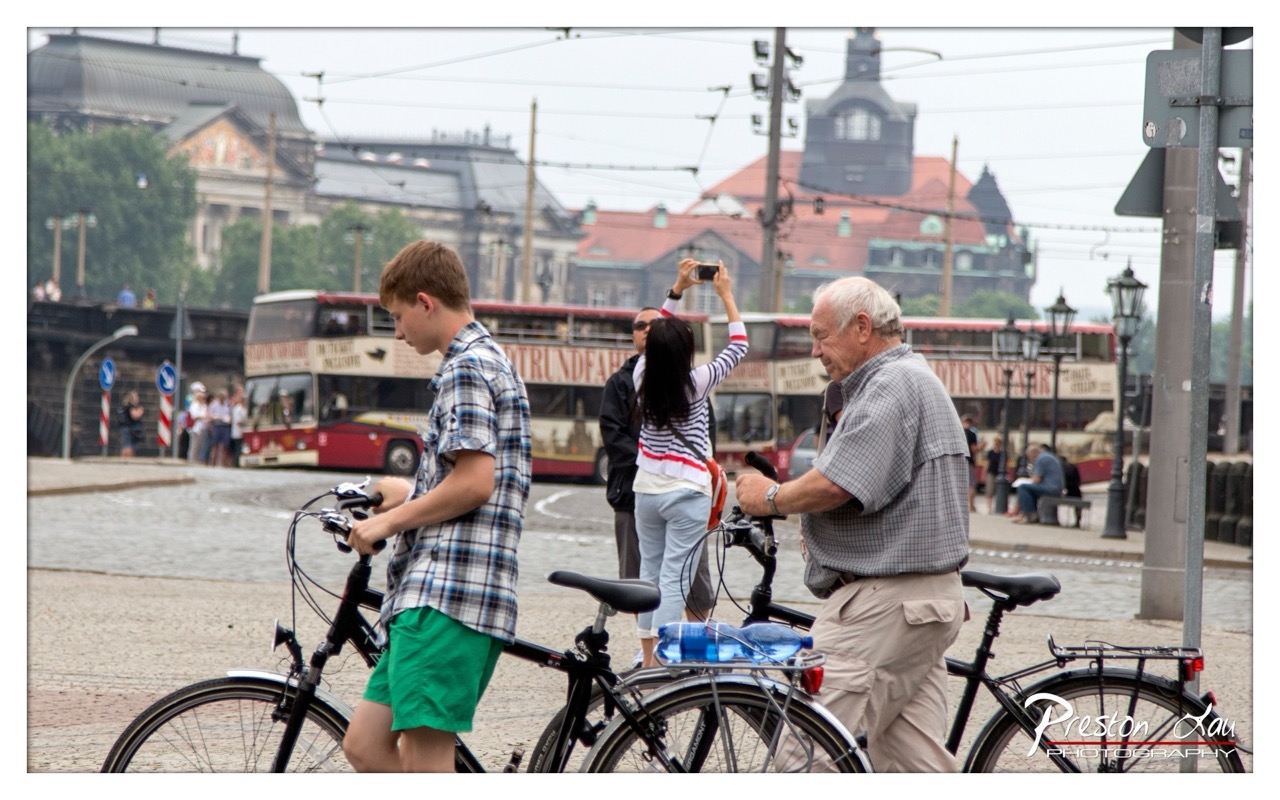

Urban Rhythms and Distractions
Rating: Subject: 7/10
This urban scene captures a few distinct moments within the hustle and bustle, primarily centering on two cyclists paused on a cobblestone street. To the left, a young fellow in a plaid shirt and bright green shorts looks down, perhaps pondering the philosophical implications of bike chains, while to the right, an older gentleman in khaki cargo shorts and a patterned shirt seems equally engrossed in his bicycle, possibly checking his tire pressure with the focus of a diamond cutter. In between them, a woman stands defiantly against the flow, phone held aloft to capture a moment, while a double-decker tour bus lumbers past in the busy background filled with historic architecture and fellow humans attempting to navigate the day. The flat, overcast lighting ensures everything is visible, but adds a touch of 'meh' to the atmosphere, much like realizing your picnic is scheduled for a drizzle.
From a photography standpoint, the composition places the bikes front and center, creating a layered effect with the busy street life behind them. It’s a classic street photography approach, capturing candid interactions – or lack thereof, as everyone seems lost in thought or their devices. The subject matter is relatable; who hasn't fumbled with a bike or tried to snap a quick photo in a crowded place? The backdrop of historic European buildings provides a sense of place, although it gets a bit lost in the visual noise and softer focus behind the primary subjects and the prominent double-decker bus. While it successfully captures a moment of urban pause, the overall image feels a little cluttered, with the bikes dominating the frame, perhaps a touch too much, like bringing your whole garage to a minimalist art exhibit.
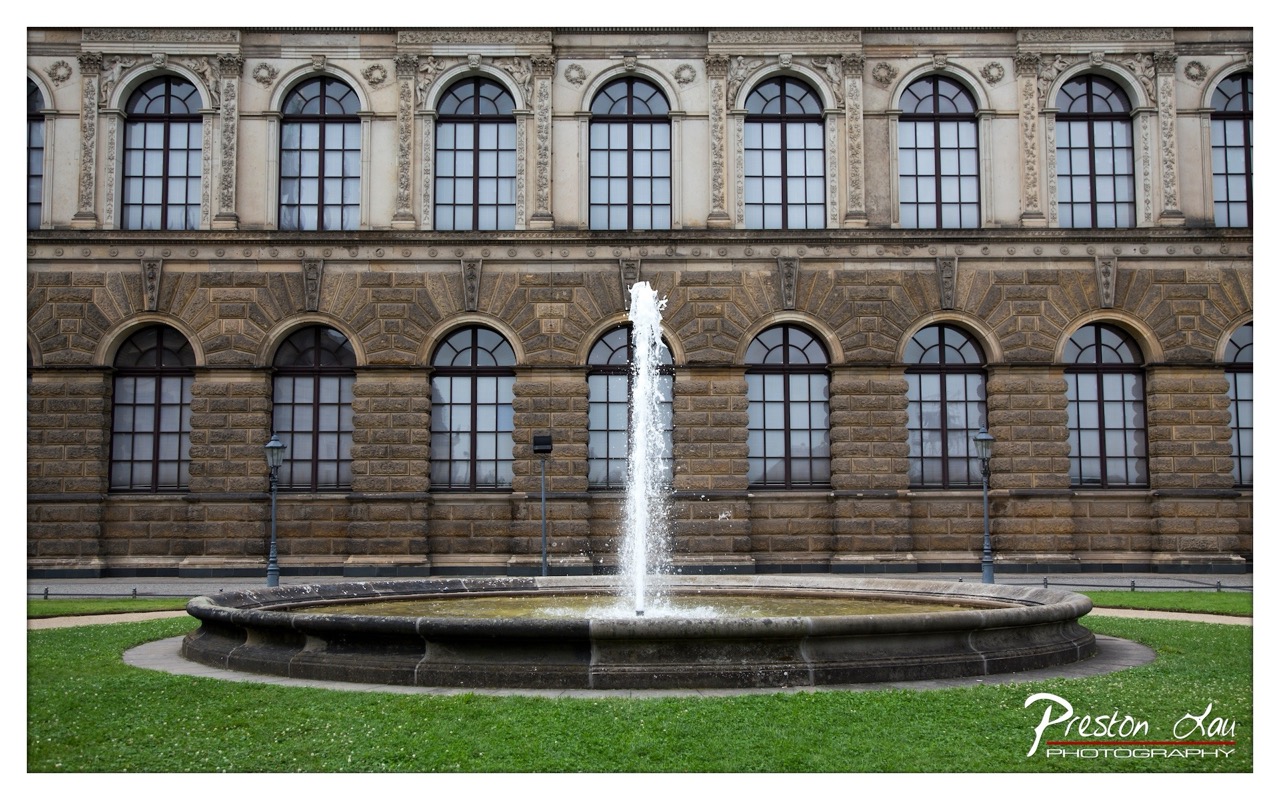

Architectural Splash Dance
Subject Rating: 8/10
Well hello there, majestic building! Standing tall and symmetrical like it's posing for a passport photo, this grand dame of architecture takes center stage, though it's arguably upstaged by the lively fountain performing its best high-pressure water ballet right in front. What we have here is a classic pairing: stoic stone facade meets energetic aquatic feature, set against a backdrop of neatly trimmed grass and a rather forlorn-looking lamppost. The mood is one of slightly formal tranquility, perhaps like attending a very polite garden party where the only real excitement comes from the waterworks.
From a photographic perspective, the composition leans heavily into symmetry, which the building provides in spades with its repeating arched windows and decorative elements. The fountain breaks this perfectly, adding a dynamic vertical line that draws the eye down. The lighting is rather even and diffused, giving a flat but clean look with excellent detail on the stonework and window panes – great for architectural study, maybe less so for dramatic flair. The color palette is quite muted, focusing on browns, greys, and greens, letting the white spray of the fountain truly pop. It's a clean, perhaps slightly clinical, style of capture that prioritizes sharpness and detail over atmosphere, making it a solid addition to any catalog of impressive buildings, even if the grass does look like it could use a bit more clover for visual interest.
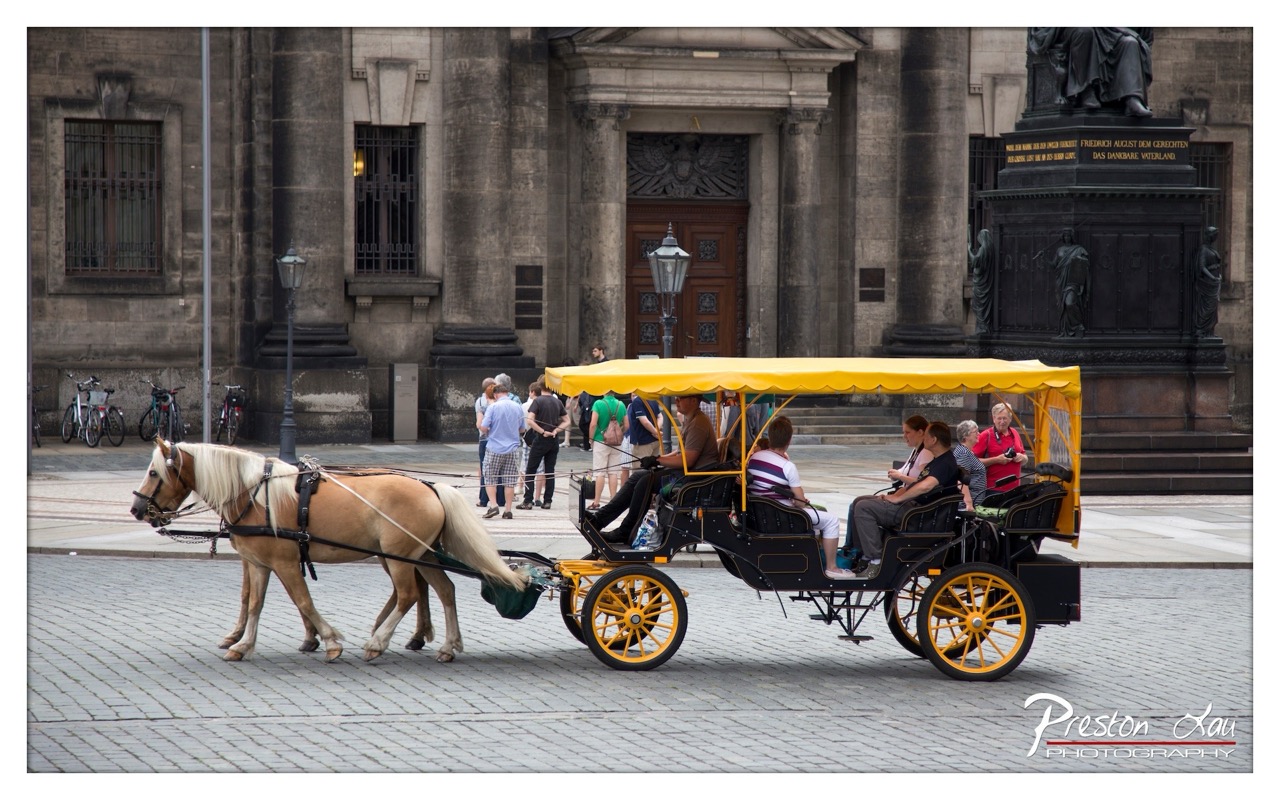

Horse Power, Tourist Edition
Subject Rating: 8/10 (A classic choice for capturing the old-world charm, though the horse looks like it's ready for a break).
Here we witness a timeless scene unfolding on a European street: a sturdy, light-colored horse with a flowing blonde mane diligently pulling a sleek black carriage. Perched inside, beneath a bright yellow canopy, are several tourists soaking up the sights, perhaps contemplating the engineering marvel that is cobblestone or simply enjoying a break from walking. The driver, looking rather focused on the task at hand, guides the equine engine forward. This tableau of leisurely transport moves against the backdrop of a truly imposing, grey stone building – the kind with serious architectural gravitas, featuring grand entrances, large windows with iron grates, and columns that have likely stood guard for centuries. Scattered bicycles near the building hint at more modern methods of getting around, providing a nice contrast to the hoof-powered journey.
From a photographer's perspective, this shot expertly captures a moment of traditional tourism. The vibrant yellow of the carriage is a fantastic focal point, popping against the otherwise subdued palette of grey stone and brown horse. The composition places the moving subject prominently in the frame, drawing the viewer's eye immediately. The lighting, seemingly soft and diffused, avoids harsh shadows and gives everything a pleasant, even tone, which is forgiving for detail across the scene, from the horse's harness to the intricate stonework of the building. The perspective, possibly slightly low, makes the building feel even grander. While the subject matter is classic and perhaps a bit predictable for a travel shot, the clean execution and the striking color contrast make it effective. It's a well-composed image that successfully encapsulates the mood of historical exploration without the need for a map app.
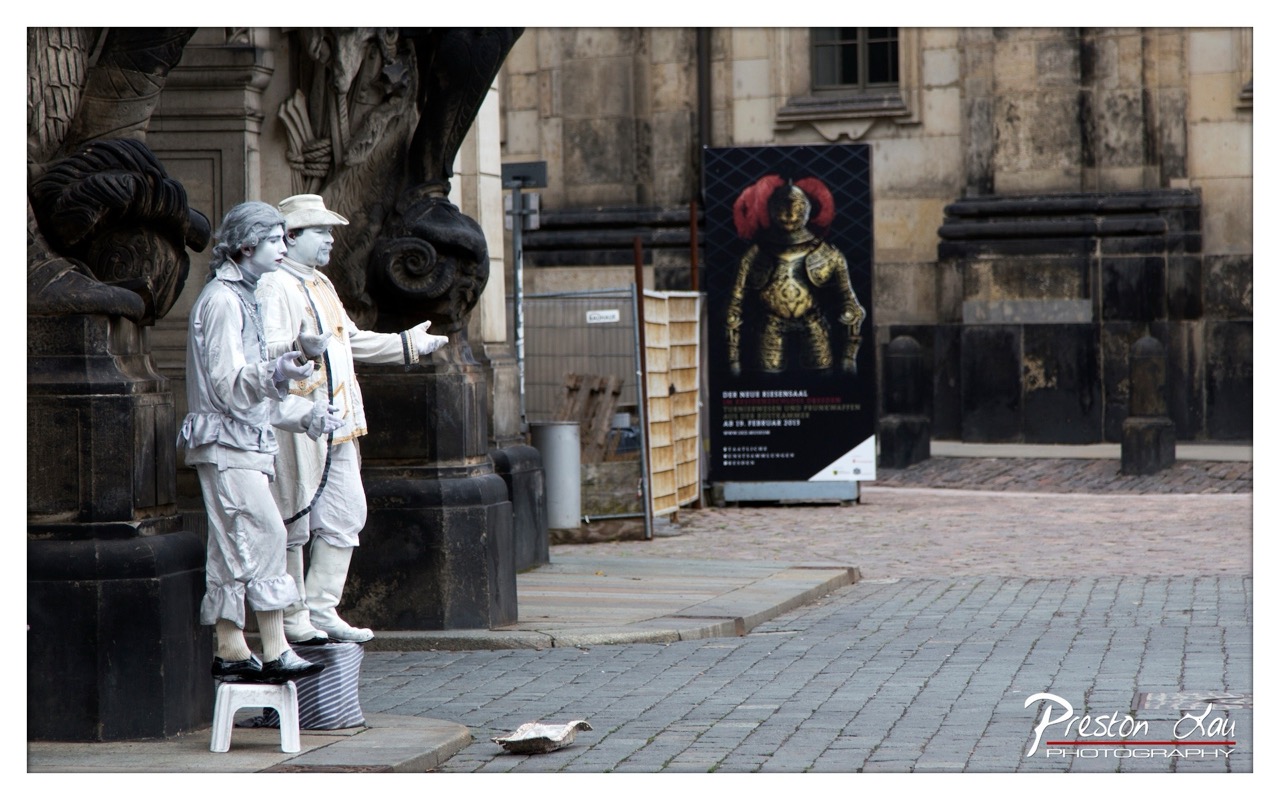

Living Statues in the Shadow of History
Subject Rating: 8/10
Here we have a classic street photography subject: living statues, adding a touch of unexpected performance art to the urban landscape. Two performers, one in shimmering silver and another in striking white and gold, stand frozen in period costume against the formidable stone architecture of what is likely a historical building. They are poised on simple platforms – a striped cylinder and a white stool atop another cylinder – maintaining their rigid poses, a testament to patience and perhaps cramping muscles. The scene is set on a cobbled street, with a large dark pillar framing the performers on the left. The mood is quiet and observational, capturing a moment of stillness amidst the potential bustle of a public space. The composition places the figures squarely in the foreground, drawing the eye immediately, while the substantial stone column adds a sense of scale and historical weight.
From a technical perspective, the lighting appears rather flat, likely due to overcast conditions, which provides even illumination but lacks the dramatic shadows or highlights that could sculpt the figures further. The color palette is dominated by muted greys, whites, and blacks from the building and pavement, with the performers' costumes and the vibrant red and gold of the poster on the right providing the main pops of color. Speaking of the poster, the advertisement for "DER NEUE RIESENSAAL" featuring a suit of armor creates a fascinating, almost meta, backdrop for these human statues, as if they are promoting the very history they embody. While the shot captures the scene effectively, a different angle or a slightly more dynamic pose from the performers (if feasible in their act) could elevate the image. The presence of the practical props like the stools, while necessary for the performance, are a small reminder of the human effort behind the art, adding a touch of relatable reality to the illusion.
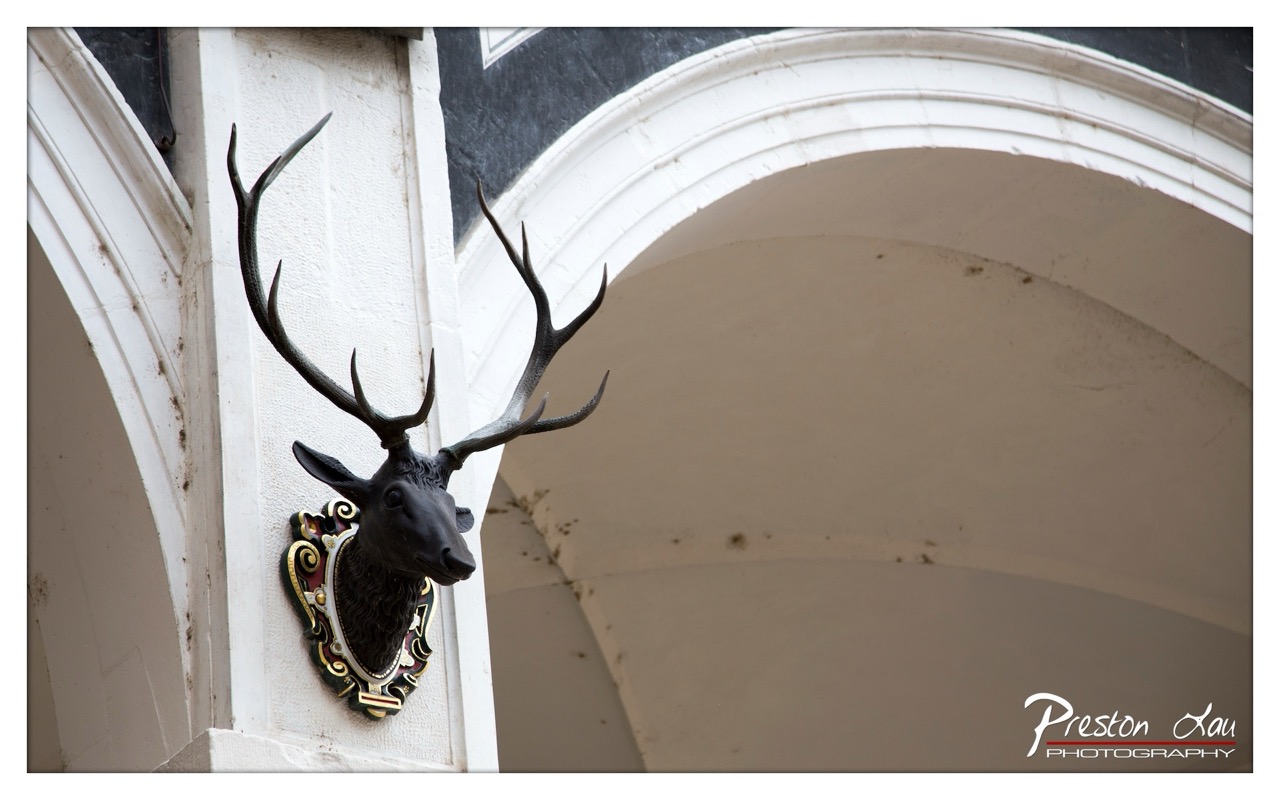

The Stare of the Stoic Stag
Rating: 7/10
This shot features a rather stoic-looking stag head mount, permanently affixed to a white wall, apparently contemplating the structural integrity of the adjacent archway. Rated a solid 7/10, not for the subject's liveliness (it's clearly past its prime in that department), but for its dignified presentation in a surprisingly grand setting. Our antlered friend is mounted on a rather fetching, if slightly ostentatious, shield plaque adorned with reds, greens, and golds, adding a splash of historical drama to the scene. The overall mood leans towards formal and watchful, suggesting this fellow is keeping a close eye on the comings and goings beneath the arch. It makes you wonder how many pigeons have tried to perch on those impressive antlers.
From a photography perspective, the composition places the deer head cleverly off-center, using the expansive, curved archway on the right to provide architectural context and balance – a smart move to avoid a static, bullseye shot. The lighting appears to be soft natural light, which gently models the contours of the antlers and face, creating a sense of depth without harsh shadows, proving that even taxidermy deserves good lighting. The shallow depth of field effectively isolates the subject from the background, ensuring your attention is solely on the noble head and its decorative shield, leaving the archway slightly out of focus but still a crucial part of the environment. The muted color palette of the white walls and arch highlights the richer tones of the mount's plaque, drawing the eye to its ornate details. It’s a well-composed shot that captures a piece of architectural decor with a touch of formality and maybe just a hint of "I used to run free, now I'm just a wall fixture" melancholy.
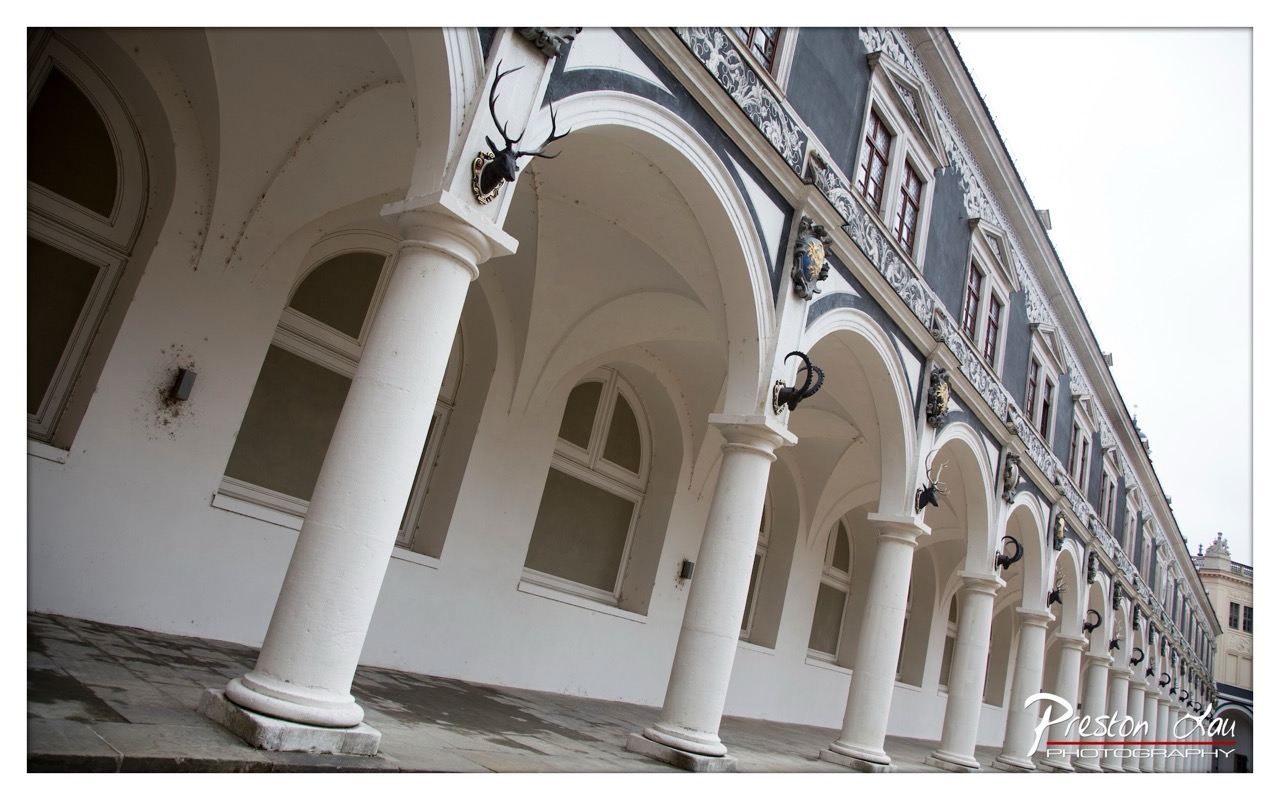

Architectural Menagerie
Rating: 7/10
This image presents a rather formal architectural subject, a long building facade featuring a repetitive arcade. What's happening is essentially a dignified building just... standing there, showing off its fancy arches and columns. The mood is historical and somewhat grand, offset slightly by the bizarre collection of mounted animal heads serving as rather morbid decorative elements. It feels like a historical building that moonlights as a hunter's lodge. The low angle gives a sense of scale, making the building feel imposing, though the perspective is slightly askew, giving the distinct impression that either the building is leaning, or the photographer had one too many steins of something before pressing the shutter button.
From a photography perspective, the composition utilizes strong leading lines from the repeating columns and arches to draw the eye down the length of the building. The repetition creates a visual rhythm, but the tilt is the elephant (or perhaps deer) in the room – is it a deliberate artistic choice for dynamism, or just a crooked shot? The lighting is flat and overcast, which avoids harsh shadows but results in a somewhat muted color palette, fitting for the grey stone and white trim but lacking dramatic flair. Pertinent objects include the sturdy white columns, elegant arches, somewhat plain windows, decorative shields, and, of course, the slightly unsettling row of taxidermied animal heads – talk about a conversation starter! The style leans towards architectural documentation with a touch of quirk provided by the decorations. The ground is a wet, grey pavement, and the background is just a blank, overcast sky and more of the building receding into the distance, complete with the photographer's watermark. It's a decent shot that captures the architectural features and the unusual decorations, but the tilt keeps it from standing perfectly straight on its visual feet.
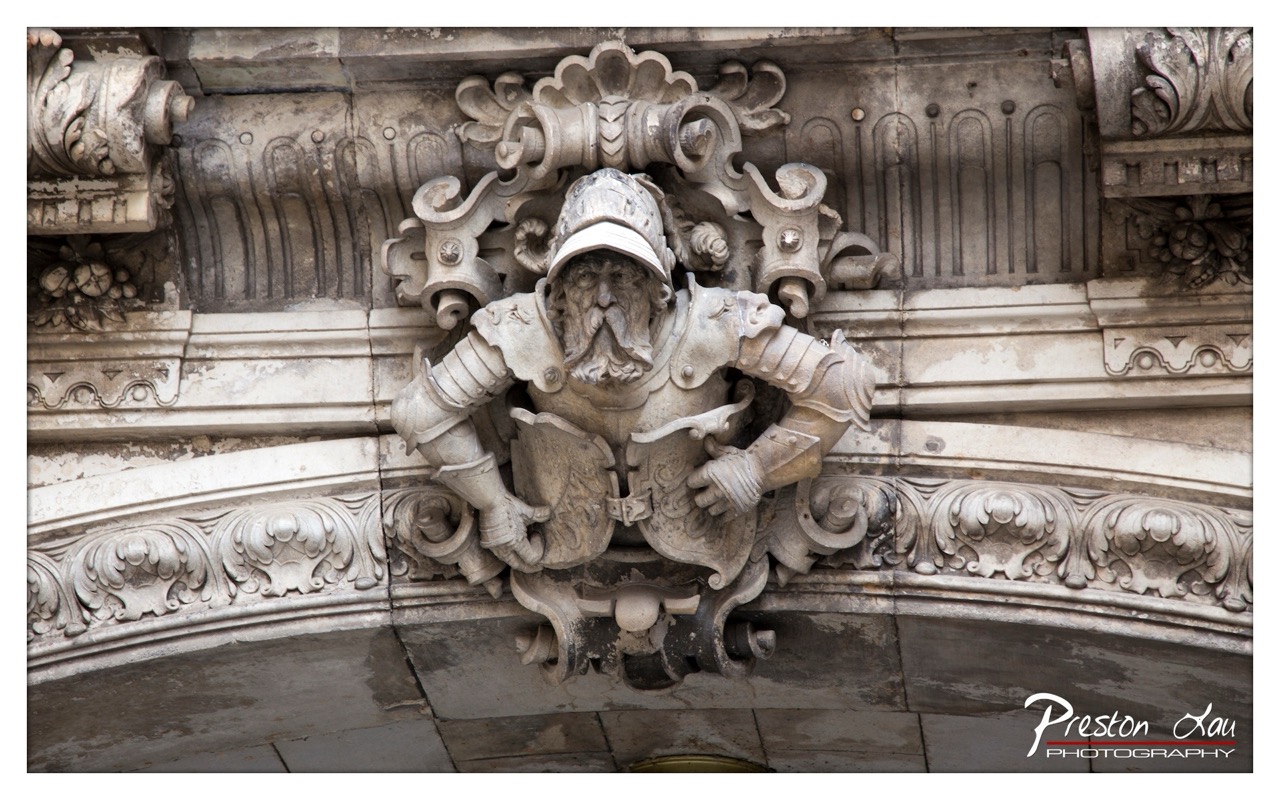

Stone Sentinel
Subject Rating: 8/10
Meet the original tough guy guarding the archway – a stone sentinel carved into the building facade, looking like he's been standing there for centuries and is just about done with everyone's nonsense. Clad in incredibly detailed armour, complete with a rather fetching helmet and a truly magnificent, windswept beard, this guy is all about gravitas and possibly complaining about his aching back. His hands are resting on his breastplate or the structure below, giving him a look of staunch support, or perhaps he's just trying to adjust his very heavy attire. The surrounding architectural details, like the intricate scrolls and fluting, frame him like the main event he clearly believes himself to be. The mood is definitely historical and imposing, albeit with a hint of grumpy defiance from our stony friend.
From a photography perspective, this shot absolutely nails the texture and form. The natural light, likely from above, creates strong shadows that pop every chisel mark and emphasize the depth of the carving, making the stone feel incredibly tactile. The composition is tight, focusing squarely on the figure and the immediate, ornate surroundings, which pulls your eye right to the intricate details of the armour and that wonderfully expressive (for stone) face. The limited color palette of weathered stone adds to the sense of age and permanence. This image isn't just documenting architecture; it's capturing the character embedded within it, showing how effective lighting and composition can transform a static object into a portrait with personality, even if that personality is "Get off my lawn!"
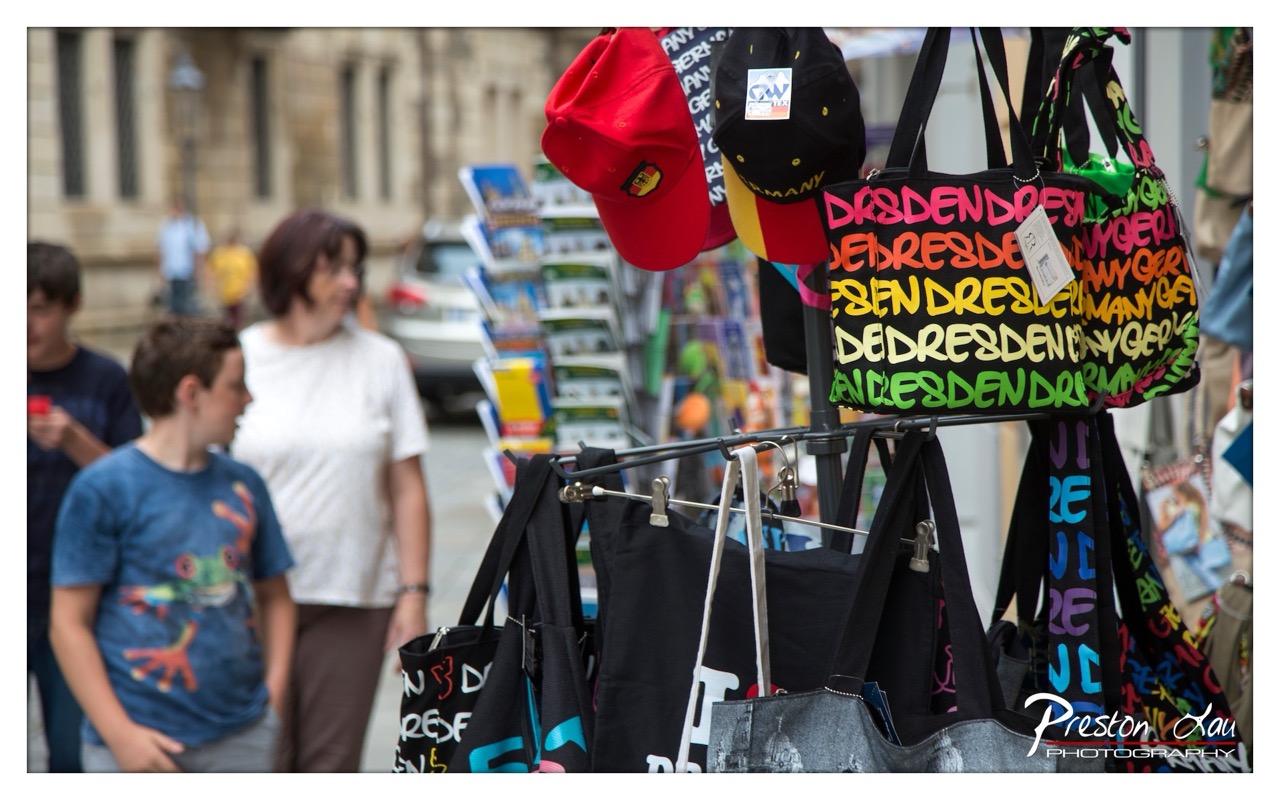

Tourist Trinket Tango
Subject Rating: 6/10
Ah, the classic "tourist stand" shot! The photographer has opted for a close-up on the vibrant, slightly overwhelming display of hats and bags, effectively turning the local souvenir scene into the main character. In the background, blurred into a gentle bokeh, we see a couple of figures who seem utterly oblivious to the dazzling array of "Dresden" bags before them, perhaps contemplating the existential dread of another day of sightseeing or just trying to decide if that blue shirt kid needs another frog-themed tee. The mood is a peculiar mix of chaotic consumerism in the foreground and serene, slightly out-of-focus human existence in the back. It perfectly captures that feeling of being overwhelmed by cheap mementos while the actual street life carries on around you.
From a technical standpoint, this image is a masterclass in selective focus. The shallow depth of field ensures the bags and hats are pin-sharp, practically screaming "Buy me!", while the background dissolves into soft shapes and colors, pushing the merchandise right into your face – much like a real-life souvenir vendor. The composition is heavily weighted towards the right and center, focusing on the colourful bags and leaving the poor, blurry humans somewhat marginalized, which is arguably accurate for the tourist experience sometimes. Lighting is decent daylight, bringing out the garish colours of the "Dresden" graffiti-style text and the red cap with the German flag motif. It’s street photography with a very specific target: highlighting the *stuff* people buy, not necessarily the people buying it. A bold choice, or perhaps just an easy target after a long day of people-watching.
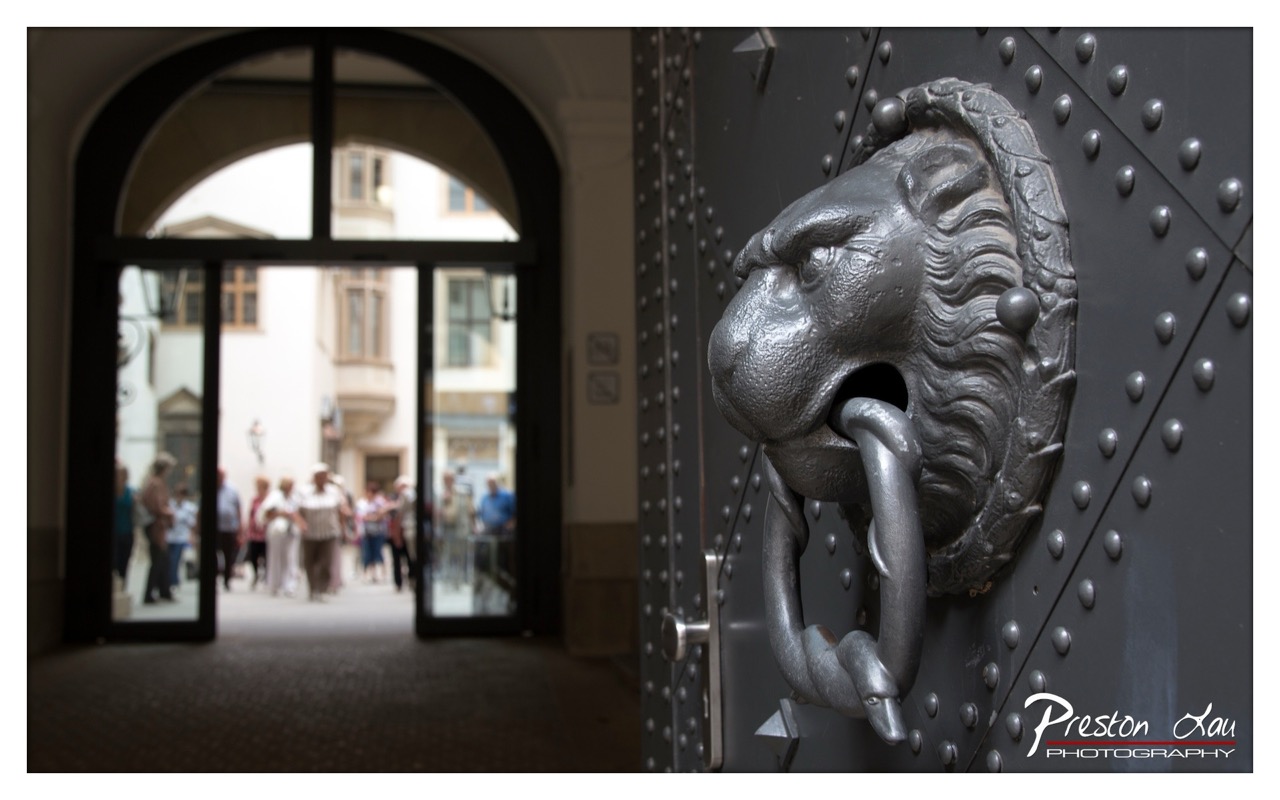

Guardian of the Gate
Subject Rating: 8/10
Behold, the formidable doorknocker, a fierce metal lion seemingly poised to roar a greeting (or perhaps a warning) to any who dare approach this rather imposing door. Mounted firmly on a surface studded with countless rivets, the lion's head, complete with a bushy mane and what looks like a rather severe expression, grips the heavy metal ring that serves as the knocker. Through the grand, arched doorway behind the door, a glimpse of a bustling courtyard or street scene unfolds, populated by a blurred throng of people going about their day, their forms indistinct yet hinting at life beyond the threshold. The mood is one of intriguing contrast – the sharp, detailed, static guardian in the foreground against the soft, dynamic, out-of-focus world behind it.
From a photographic standpoint, this shot expertly plays with depth of field, isolating the impressive lion knocker as the undeniable star of the show. The composition utilizes a split-frame approach, placing the main subject off-center to the right while the arched doorway and background provide context and visual balance on the left. The lighting appears natural, highlighting the texture and detail of the metal knocker without harsh shadows, making the lion look stoic rather than scary (mostly). The choice of a shallow depth of field effectively separates the imposing, historic detail of the door from the lively, blurred reality beyond, turning mundane street activity into a soft, impressionistic backdrop. It's a classic technique used well, proving that sometimes, the most interesting view is the one just before you enter or just after you leave.
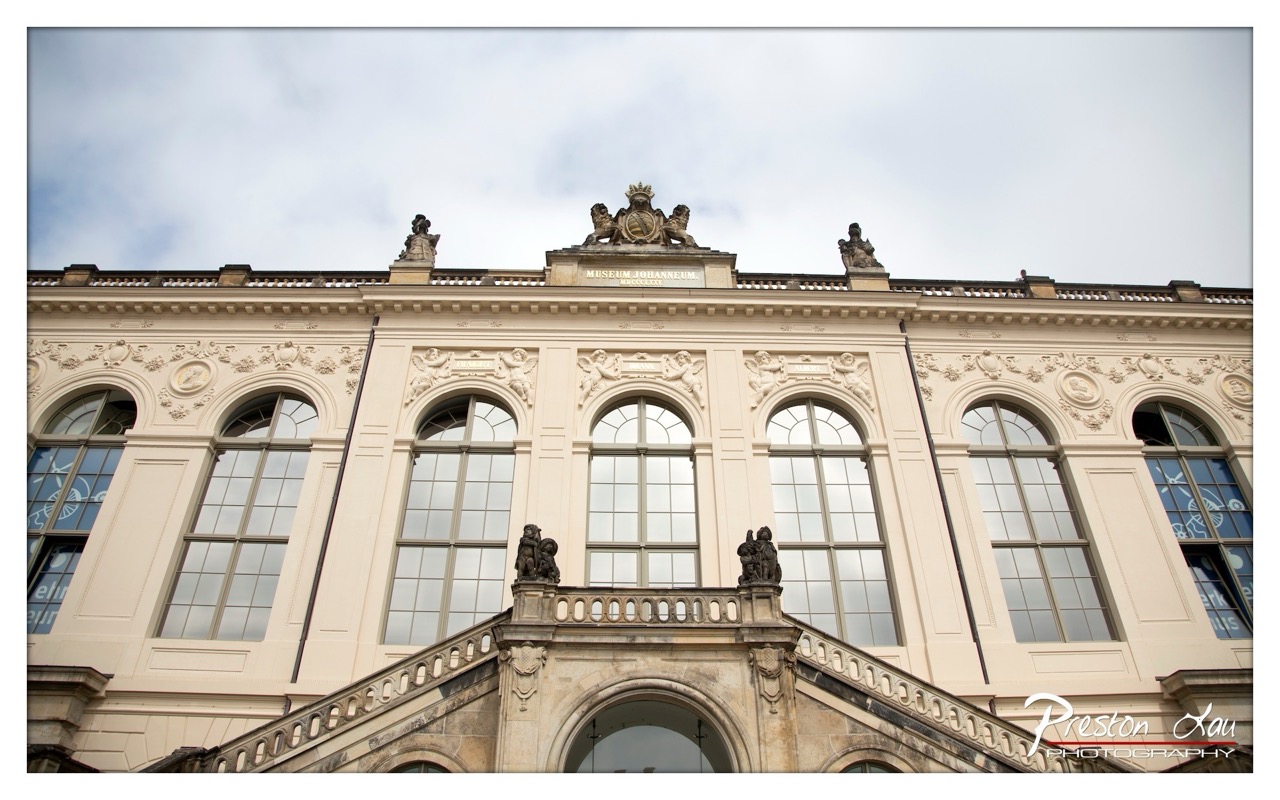

Museum Majesty, Slightly Undercooked Sky
Subject Rating: 8/10 - This building is clearly trying to impress, putting its best facade forward with statues and fancy windows. It's a solid 8 for architectural grandeur, maybe a 9 if the sky wasn't so aggressively neutral. It's the "business in the front, overcast party in the back" of buildings. What's happening? Well, it's just being a magnificent old building, standing there, probably contemplating the fleeting nature of human existence or perhaps just hoping the pigeons aren't having a field day on its statues. The mood is one of historical importance and somewhat subdued gravitas, likely due to the sky looking like it's about to decide whether to rain or just stay boringly grey. We see the prominent inscription "MUSEUM JOHANNEUM", lest you confuse this impressive structure with, say, a particularly elaborate public toilet. Those stairs leading up add a nice touch of dramatic entry, making you feel like you're ascending to photographic heaven (or at least a decent collection of artifacts).
From a photographic perspective, the composition feels a bit like "look up and point," which works for capturing the scale and detail, though it does lean back slightly, giving those vertical lines a bit of a lean – classic architectural photography challenge! The lighting is soft and diffused thanks to the cloudy sky, which is great for minimizing harsh shadows and showing off the intricate details of the facade and those cherubic figures above the windows (are they whispering sweet nothings or critiquing the stonework?). The color palette is pleasantly muted, focusing on the warm tones of the stone against the cool grey of the sky and glass. While the muted tones are fitting for the subject, a touch more contrast or a hint of sunshine might have elevated the overall impact. The reflection of the sky in the windows adds a dynamic element, though the content within the windows on the far left and right are intriguing but slightly distracting – are those abstract art pieces or just weird reflections? Overall, a well-executed shot of a grand subject, capturing its dignity despite the sky's lack of enthusiasm.
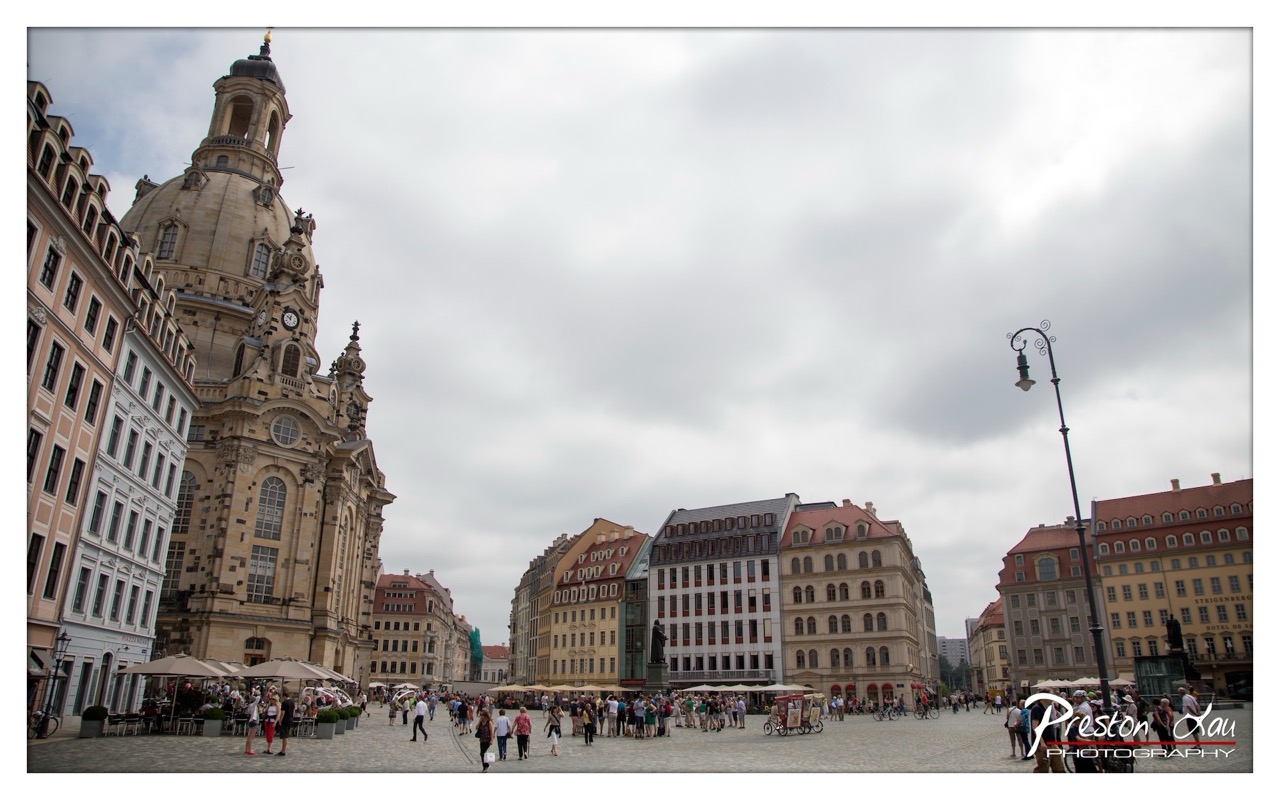

Dresden's Grand Square Under Overcast Skies
Rating: 7/10
Step right up to the heart of Dresden! This photo captures the magnificent Frauenkirche standing guard over a lively city square, a quintessential scene of European urban life. The subject here is the grand architectural spectacle meeting the humble hustle and bustle of daily existence. Hordes of people are doing what people do in famous squares: walking, chatting, sitting under umbrellas at cafes, and probably debating whether to get another Sachertorte. The mood is undeniably active and historical, though the heavily overcast sky suggests the sun decided to take a raincheck, casting a rather muted palette over the scene. It's a snapshot of history and humanity sharing the same cobblestones.
Photographically, this shot provides a wide view, giving us context for the square's scale. The composition successfully incorporates the major landmarks, though the towering street lamp on the right acts like that one friend who insists on being in every photo, slightly pulling focus. The soft, diffuse light from the clouds is great for minimizing contrast and detail retention in shadows and highlights, but it does rob the image of some punch and vibrancy. We get a good look at the textures of the stone and the varying architectural styles of the buildings. While competently executed with good depth of field ensuring sharpness, the framing could be tighter to emphasize the main subjects or perhaps lose the aforementioned lamp. It's a solid record of the location, perfect for showing someone 'I was here, and it was cloudy and full of people!'
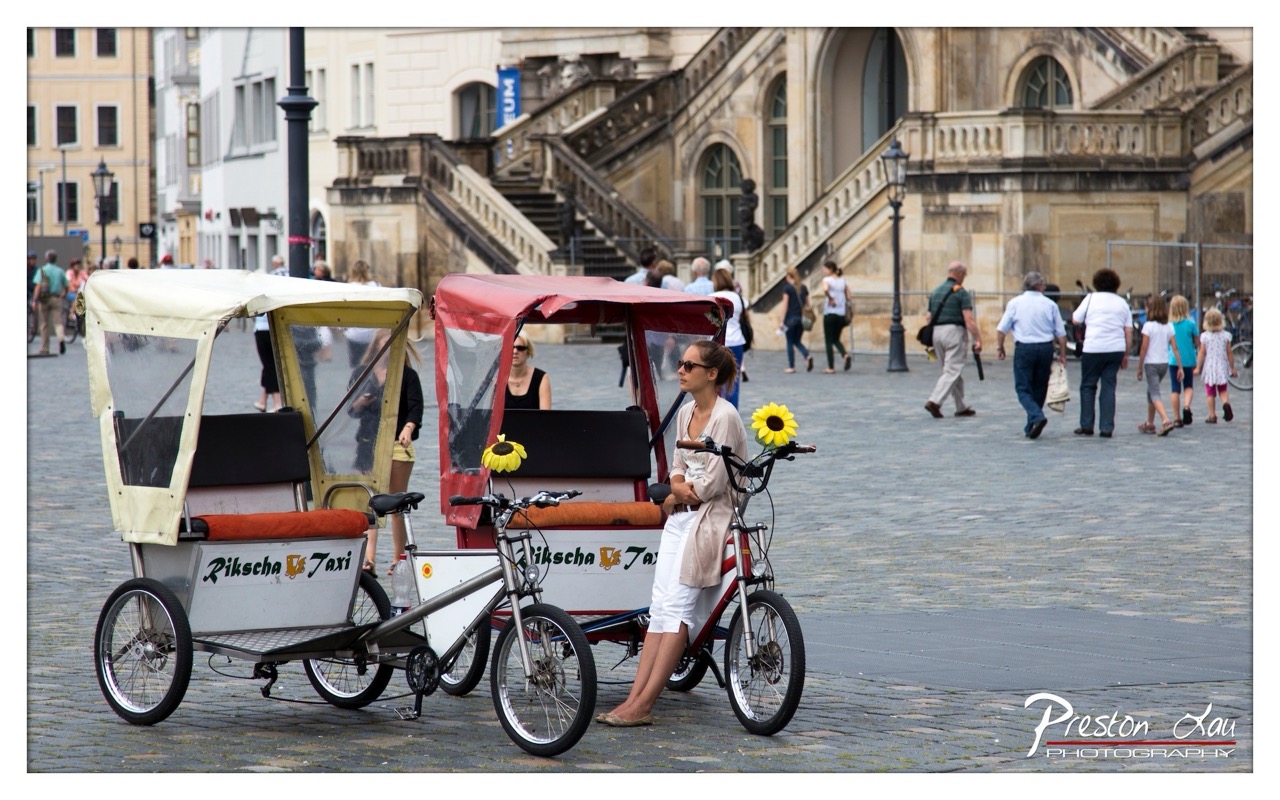

Sunshine Chariots and Cobblestone Strides
Subject: 7/10
Ah, the noble rickshaw, patiently awaiting its next human cargo amidst the historical grandeur of what appears to be a European city square. Here we have a pair of these pedal-powered carriages, one in a rather cheerful yellow and white, the other a bold red, taking center stage. In the foreground, a passenger in the red one is caught mid-contemplation, looking off to the side as if pondering the existential weight of being transported by bicycle. The scene is one of pleasant urban activity; people mill about in the blurred background, providing context and a sense of place, suggesting a relaxed, leisurely mood, perhaps a sunny afternoon dedicated to sightseeing or simply getting from A to B via slightly more eccentric means.
From a photographic standpoint, the composition is quite effective, employing a shallow depth of field to isolate the main subjects – the rickshaws and their passenger – against the softly blurred backdrop of architecture and passing pedestrians. This draws the eye directly to the foreground, preventing the busy background from becoming a distraction. The natural lighting is soft and even, avoiding harsh shadows and rendering colors faithfully, making the vibrant red and yellow pop against the muted tones of the square. The quirky artificial sunflowers adorning the handlebars add a touch of whimsical color and personality to the otherwise functional vehicles. It's a classic street photography approach, focusing on interesting elements within a broader urban landscape, although placing the watermarked photographer's name quite prominently in the bottom right corner does rather stamp its authority on the scene.
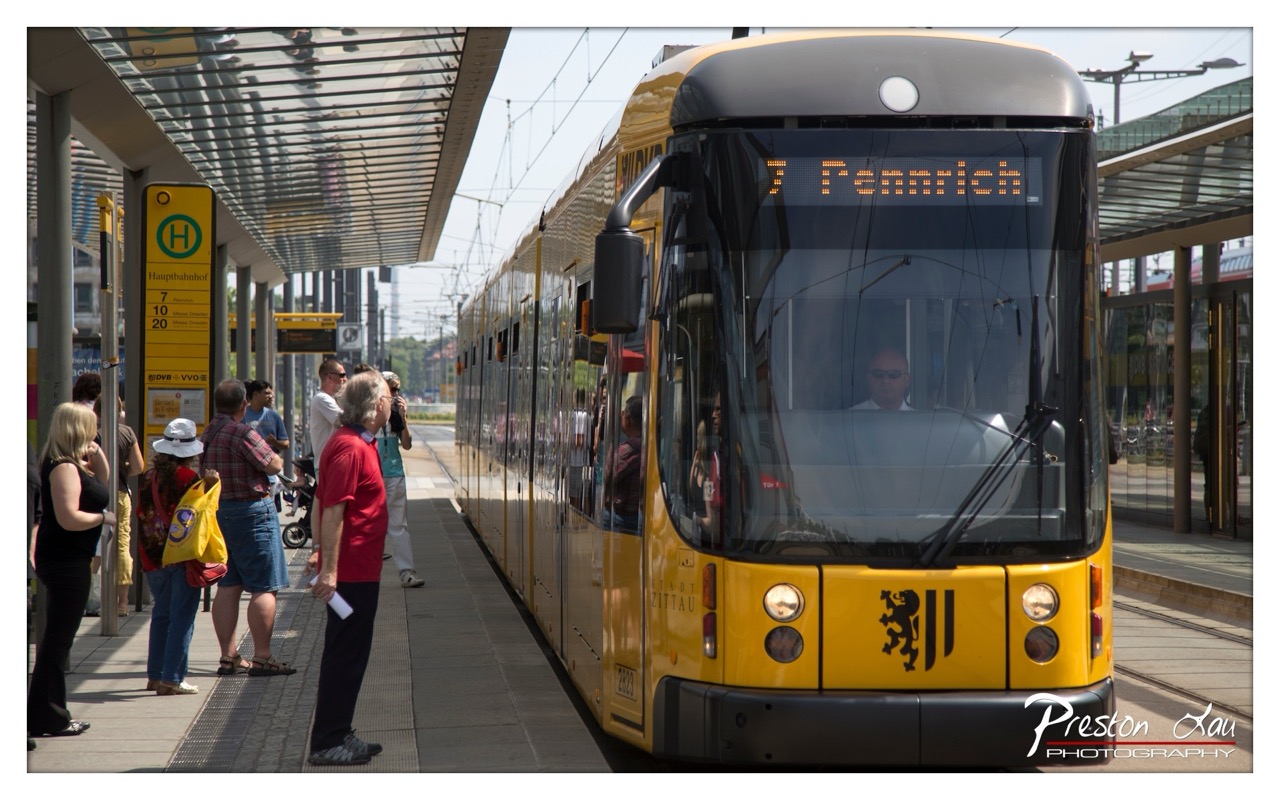

Waiting for 7 Pennrich
Subject Rating: 8/10
Ah, the excitement (or mild inconvenience) of waiting for public transport, perfectly captured here at a bright, modern tram station. The star of the show is undeniably the sleek, cheerful yellow tram, proudly displaying its route: "7 Pennrich". It looms large on the right side of the frame, ready to whisk its passengers away to whatever wonders (or errands) await in Pennrich. On the platform, a diverse cast of characters is gathered – some gazing towards the tram, others lost in thought or conversation. There's the gentleman in the red shirt looking rather pensive, a group chatting, and a woman with a bright yellow bag that seems to be trying to compete with the tram itself. The mood is one of quiet anticipation, a brief pause in the urban flow, all taking place under the cool, reflective shelter of the station roof.
From a photographic standpoint, the composition effectively balances the massive presence of the tram with the human element and station architecture on the left. The vibrant yellow of the tram is a powerful focal point, popping against the cooler tones of the concrete and metal. The lighting suggests a bright, sunny day, possibly midday, creating strong contrasts and shadows, which add depth to the platform and highlight the glossy finish of the tram. The reflective glass roof overhead adds an interesting textural element and hints at the sky above. While harsh midday light can be tricky, here it serves to emphasize the scene's realism and the bright, functional aesthetic of the modern transit system. The background provides a glimpse of the surrounding city environment, grounding the scene in its urban context. And lest we forget, the prominent watermark reminds us who expertly froze this fleeting moment of transit life.
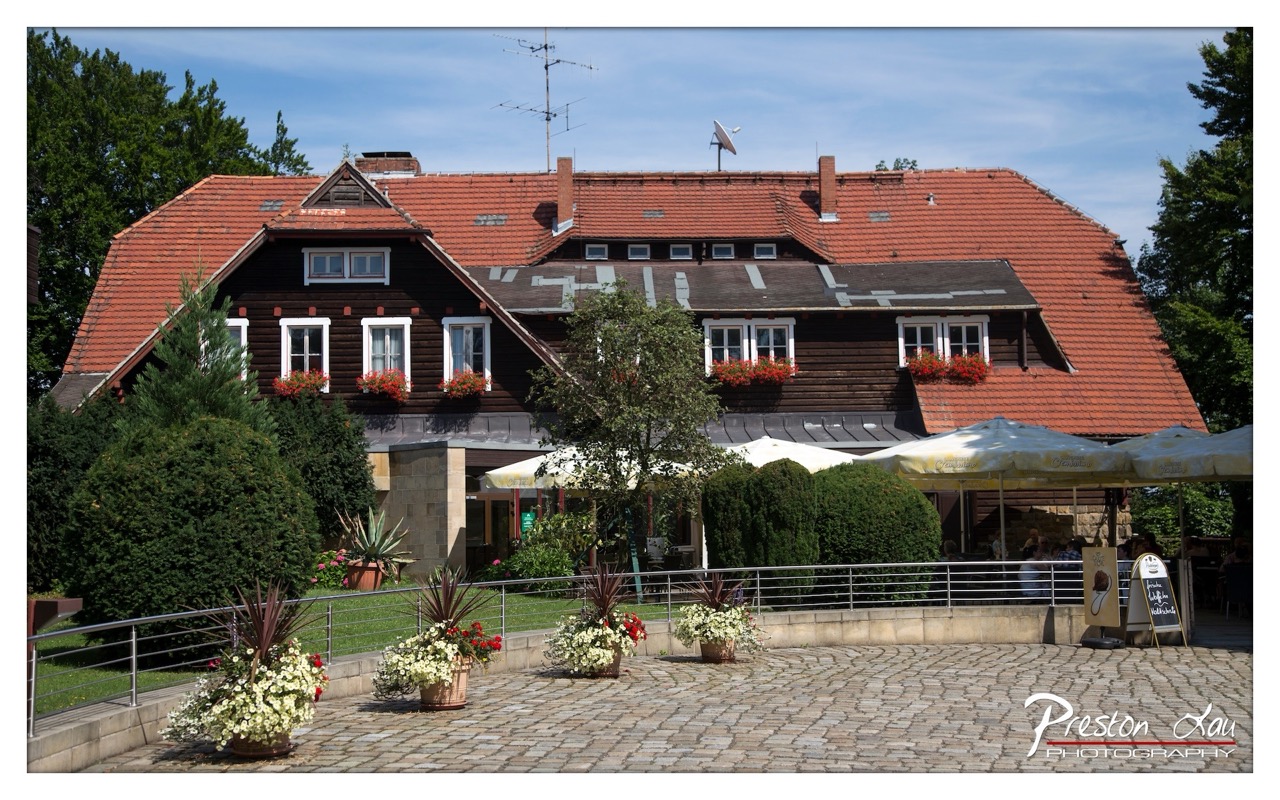

Architectural Charm (and Antennas)
Rating: 7/10
This image presents a large, multi-part building, seemingly a hotel or restaurant, basking under a clear blue sky on a sunny day. The dominant features are the warm red tile roof and the dark wood-paneled facade dotted with white-framed windows, many adorned with cheerful red flower boxes. A paved patio area in the foreground, covered in detailed cobblestones, is set up with several large umbrellas, suggesting an outdoor seating or dining space. Potted plants strategically placed near a modern metal railing add pops of color and life to the scene, hinting at a pleasant spot to relax. The overall mood is bright, inviting, and suggests a tranquil getaway location, ready to serve patrons seeking shade and refreshments.
From a technical perspective, the composition places the substantial building front and center, utilizing the patterned cobblestones and the railing as subtle leading lines towards the main subject. The lighting is bright and direct, characteristic of a sunny day, which effectively illuminates the building's facade and brings out the vibrant colors of the flowers and the blue sky, though it creates some strong shadows. The level of detail captured is quite good, showing the texture of the roof tiles and the wood grain. However, the array of antennas and a satellite dish atop the roof are perhaps less aesthetically pleasing elements that contrast with the rustic architecture – a photographer's dilemma between documenting reality and creating a perfectly picturesque scene. Despite these modern intrusions, it's a solid capture of a charming building on a fine day, effectively conveying its welcoming nature, albeit with a slightly cluttered skyline.
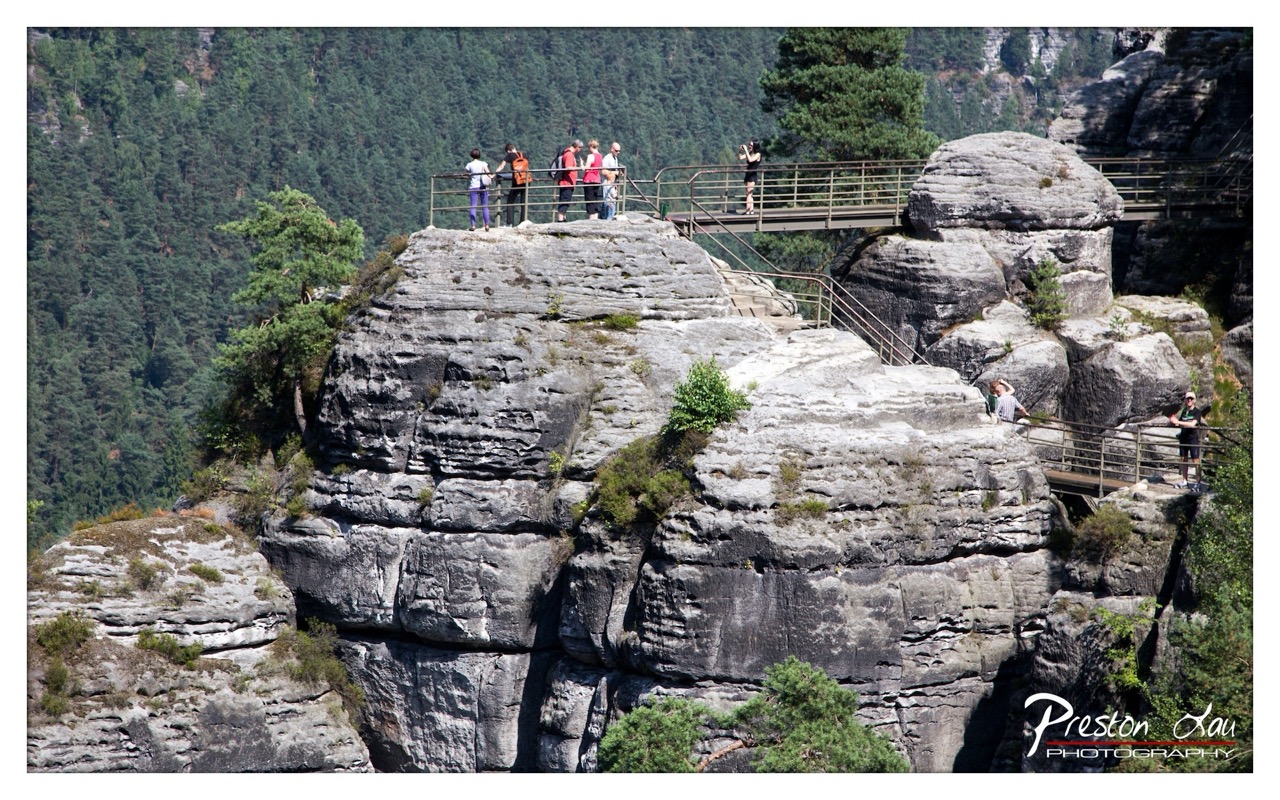

Rocks, Rails, and Ramblers
Rating: 7/10
Okay, let's talk about bridging gaps – both literally and figuratively. The subject here is a magnificent geological formation, a colossal pile of weathered rock layers that frankly look like nature's idea of Jenga, rated a solid 9/10 for sheer visual drama. Humans, in their infinite wisdom and desire for epic views without excessive climbing, have installed a rather impressive series of bridges and staircases, turning this natural wonder into a tourist superhighway. People are actively navigating these elevated walkways, peering out at the landscape, and no doubt pondering how many steps they've climbed, all contributing to a mood of adventurous accessibility in this vertical landscape. The background is a sea of dense green forest, emphasizing just how high up these rocks actually are, while the bright sky suggests a clear, sunny day – perfect for getting slightly sunburnt while admiring ancient stone.
From a photographic perspective, this image does a good job of capturing the scale and the interaction between the natural and the man-made. The composition uses the lines of the bridges to lead the eye through the scene, though the large rock formation in the center feels a bit static, daring you to find a more dynamic angle. The lighting, while sufficient, appears to be midday flat light, meaning fewer dramatic shadows to highlight the textures of the rock – great for detail, less so for mood. The color palette is dominated by the reliable grey of the stone and the greens of the trees, a classic landscape pairing. Including the people is key here; they provide context and scale, transforming it from just a rock formation into a place visited and experienced. It's a competent shot of a truly spectacular location, clearly documented by someone who remembered to slap their watermark on it – because if you didn't watermark it, did you even climb the stairs?
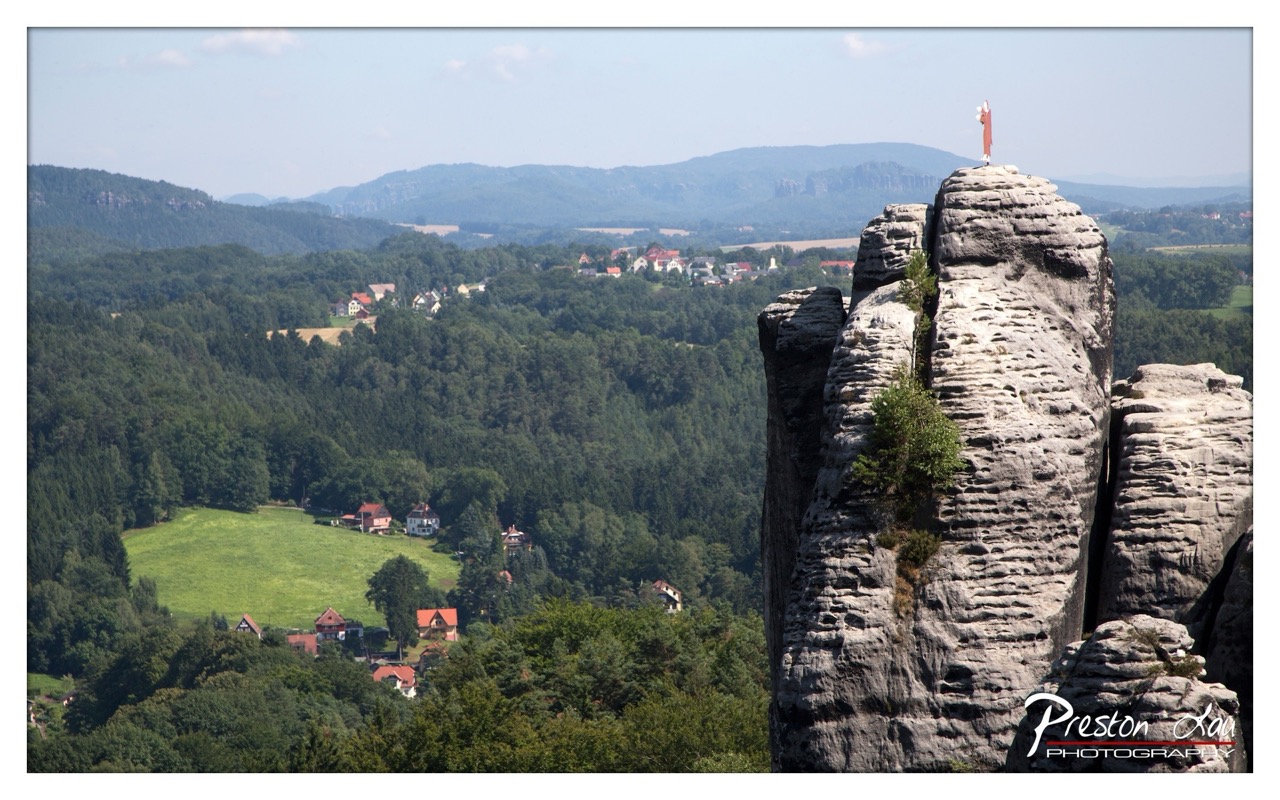

The Lonely Sentry Rock
Subject: 8/10
Behold the majestic "Lonely Sentry Rock," standing tall against a sprawling European landscape. What's happening? Well, a solitary figure, perhaps a brave climber or a rather ambitious garden gnome, has claimed the very peak of this imposing sandstone spire, seemingly surveying a vast expanse of deep green forest and the charming, scattered houses of a village nestled below. The mood is one of serene grandeur mixed with a touch of whimsical isolation, as the tiny human element highlights the sheer scale of the natural world around it. It makes you wonder if they packed a lunch for their lofty perch atop that impressive, layered rock formation.
From a photographic perspective, the composition is striking, placing the heavily textured rock formation on the right, providing a strong anchor point and visual interest with its layered strata and craggy face. This contrasts beautifully with the softer, undulating lines of the forested hills and distant horizon on the left. The natural lighting is effective, highlighting the textures of the rock and bathing the landscape in a pleasant daytime glow, though perhaps a polarizer could have punched up the blue sky a touch. The colors are predominantly earthy greens and greys, with pops of red from the rooftops adding a touch of warmth to the otherwise verdant scene. This style of sweeping landscape photography is classic, aiming to capture both the dramatic foreground feature and the expansive backdrop, though the placement of the figure adds a unique, slightly surreal element that elevates it beyond a standard scenic shot. It's like the rock decided to sprout a tiny human antenna for better reception.
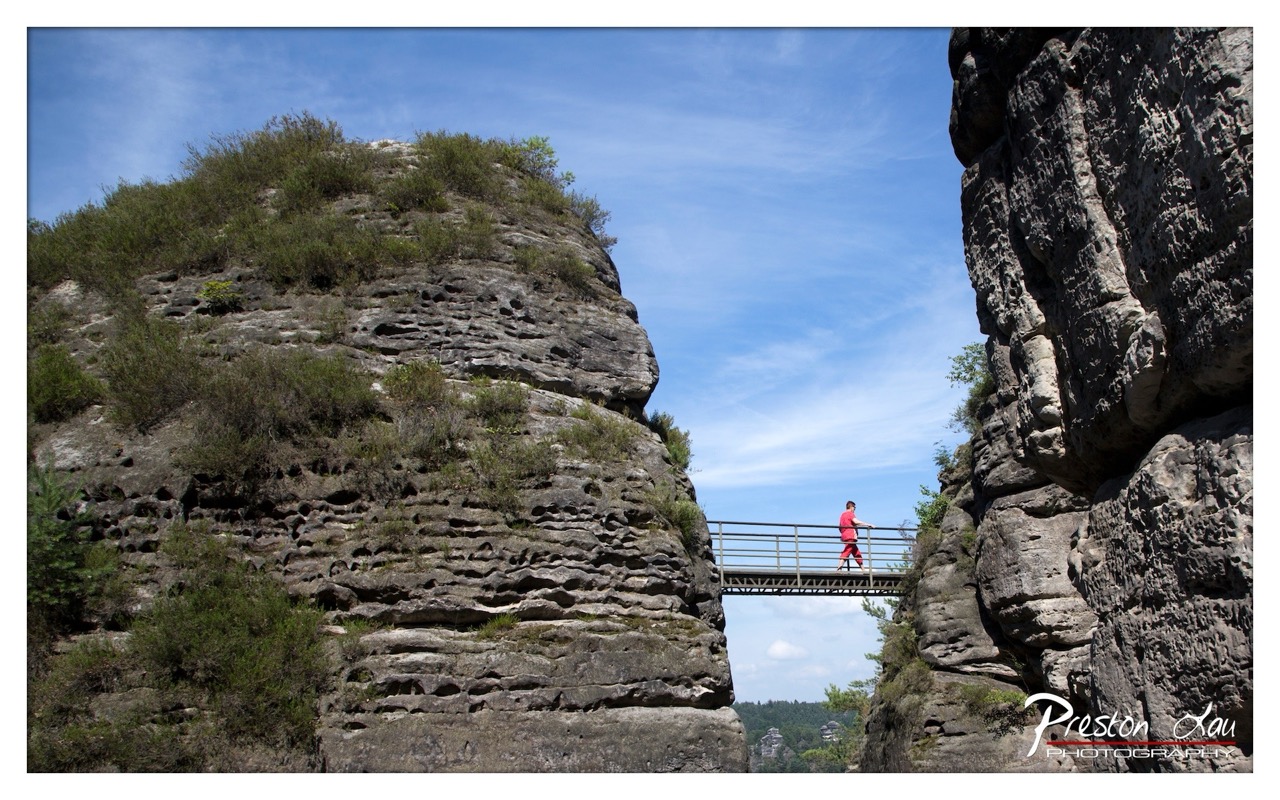

Bastei Bridge Wanderer
Rating: Subject 8/10
This epic shot places a tiny human figure in bright red against the colossal scale of the Bastei rock formations in Germany, linked by a rather sensible-looking bridge. Our intrepid subject, sporting what looks suspiciously like a kung fu uniform, is making their way across the gap between these ancient, pockmarked stone titans. The mood is one of awe and adventure, highlighting the sheer impressiveness of nature and the small but significant presence of humanity within it. The rugged texture of the rocks, dotted with stubborn green scrub, contrasts sharply with the man-made elegance of the bridge and the distant, hazy landscape visible through the gap.
From a photographer's perspective, this image uses a strong horizontal element (the bridge) cutting across the frame, connecting two powerful vertical masses (the rocks). The bright red figure is a clear focal point, providing a pop of color against the more muted natural tones and drawing the eye immediately. The lighting is typical of a bright, sunny day, creating deep shadows on the textured rock faces, which adds drama but also challenges dynamic range – maybe the photographer could have packed a fill-flash or just waited for softer light, though you'd miss that glorious blue sky. The composition effectively uses the gap between the rocks and the bridge to guide the viewer's gaze towards the distant, picturesque background, hinting at the wider landscape beyond this dramatic chasm. And yes, we see the watermark; looks like Preston Lau was here, capturing the moment before our friend in red decided to perform a high kick mid-bridge.
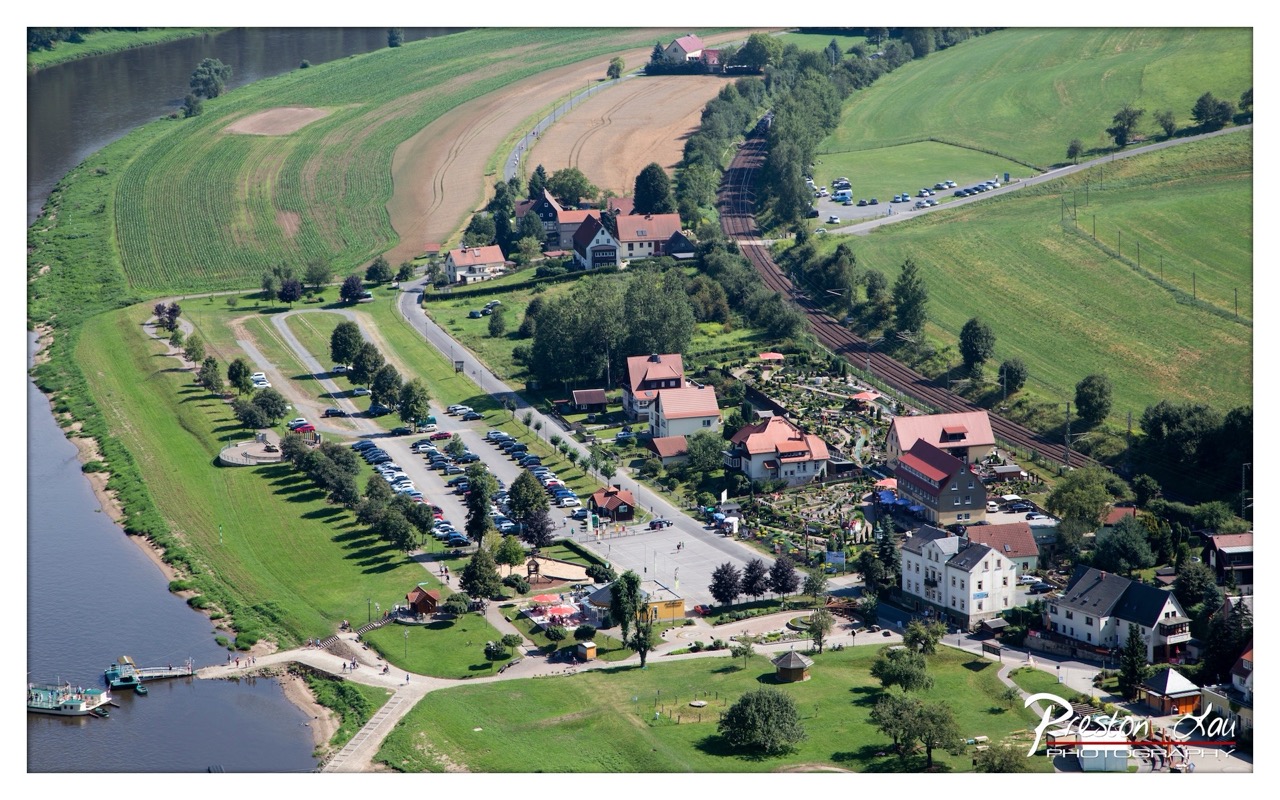

Miniature World on the River Bend
Rating: 7/10
Behold, a veritable tapestry of human endeavor woven onto the grand canvas of the natural world, viewed from a height that makes cars look like ants and houses like dollhouses. This aerial shot captures a slice of life alongside a meandering river, where fertile fields gracefully curve, contrasting sharply with the geometric precision of roads, railway tracks, and the decidedly non-geometric jumble of buildings and parking lots. It’s a scene bustling with quiet activity – cars parked in neat rows suggesting a destination, perhaps a local attraction or ferry crossing point visible by the riverbank. The mood is one of detailed observation, almost like peering into an elaborate model train set, bright and sunny, showcasing a place where nature's flow meets man's busy patterns. The presence of a unique, densely packed area that looks like a miniature garden or park adds a curious element to the composition, promising tiny wonders down below.
From a photographer's standpoint, the composition leverages the aerial perspective brilliantly, using the sweeping lines of the river and fields to frame the more concentrated human structures. The high angle effectively flattens the scene, turning landscapes into patterns and settlements into intricate details. Lighting is bright and appears fairly even, highlighting the varied textures of fields, water, and rooftops, though a slight haze might be present, common in aerial shots. The color palette is rich with natural greens and blues, punctuated by the earth tones of buildings and fields, creating a pleasing visual balance. While the detail is impressive, allowing viewers to explore the scene like a map, the prominently placed watermark is, shall we say, generously sized, asserting ownership with the subtlety of a billboard. Despite this assertion, it's a strong documentary image, capturing the complex relationship between a community and its landscape, reminding us that even from above, our little worlds are fascinatingly complex.
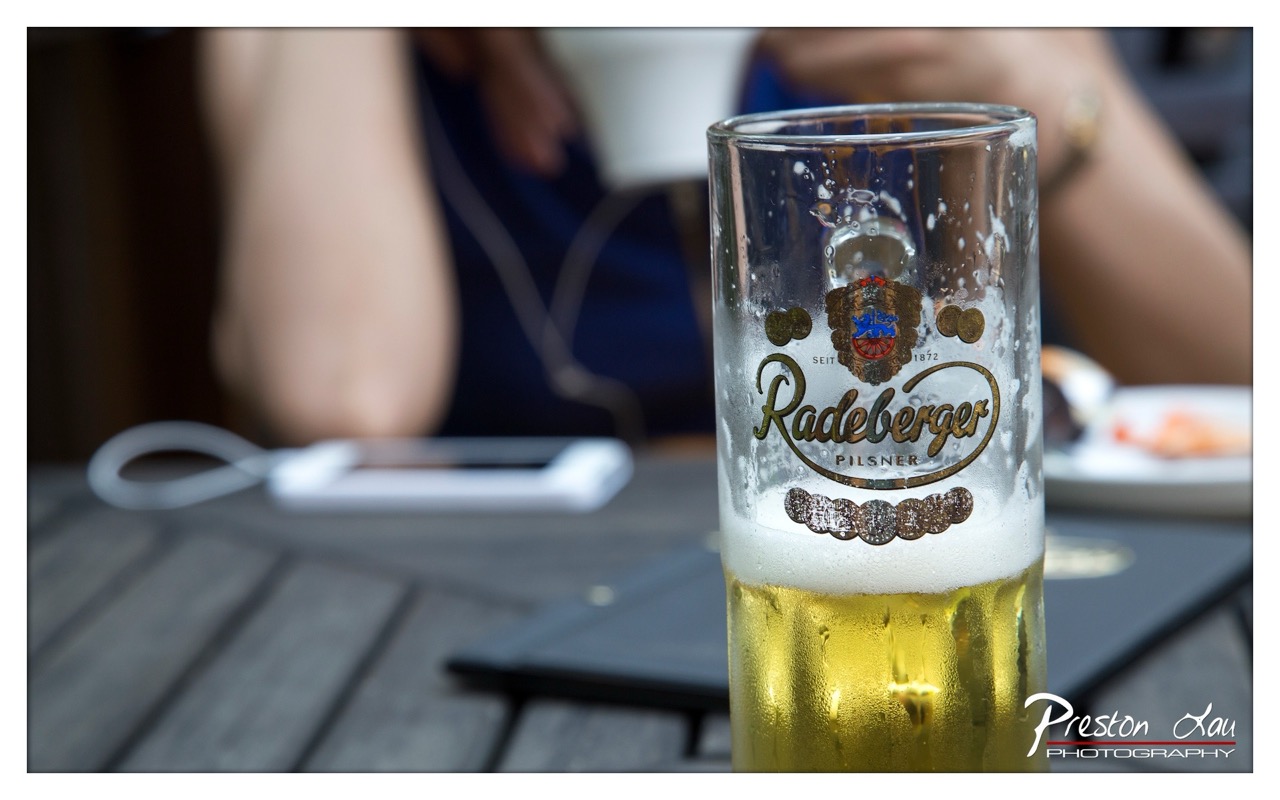

A Cold One Takes Center Stage
Rating: Radeberger Pilsner (as the subject's essence): 8/10
Ah, a moment of pure, unadulterated liquid gold! The star of this scene is undoubtedly a beautifully presented glass of Radeberger Pilsner, condensation clinging lovingly to its curves, promising icy refreshment on a warm day. We're clearly seated at a sturdy, textured wooden table, the perfect companion for a refreshing beverage. While the foreground is dominated by this glorious pint, the background hints at a common modern tableau: blurred figures of fellow patrons, perhaps lost in conversation or, as seems to be the case with the prominently placed white smartphone and tangled cable, entirely absorbed in their digital worlds. A dark menu or folder sits nearby, along with a plate showing some indistinct food. It's a classic scene of relaxation, where the simple pleasure of a good beer cuts through the hazy distractions of life (and photographic backgrounds).
From a photographic standpoint, this shot is all about celebrating the main subject with a healthy dose of shallow depth of field, otherwise known as 'bokeh-licious'. The glass is tack-sharp, pulling your eye immediately to the golden liquid and iconic Radeberger label, while everything else melts into a creamy, unobtrusive blur. This compositional choice effectively isolates the beer, giving it the celebrity treatment it deserves and making it pop against the less important background elements. The lighting appears to be natural, soft but highlighting the condensation beautifully, making you practically feel the chill through the screen. The warm tones of the beer and table contrast nicely with the cooler, darker blues and greens in the background. The photographer's style here is clear: find your hero, isolate it using focus, and make it sparkle. It's a simple formula, executed well, making this beer look incredibly inviting, even if the poor souls in the background are just fuzzy outlines of human existence.
Loading map...